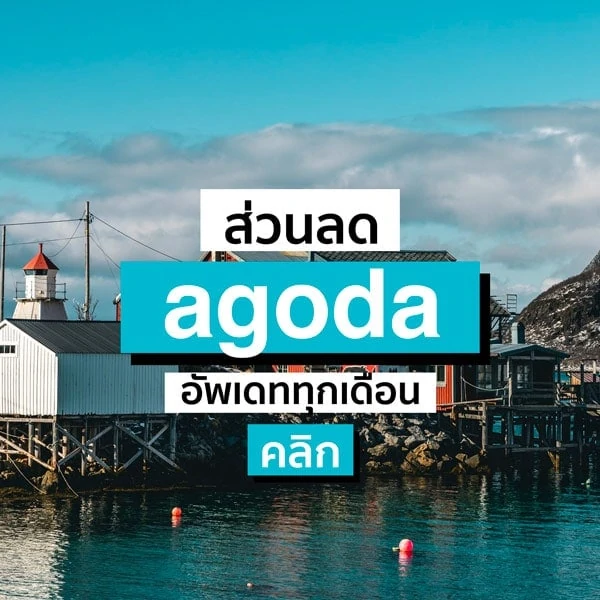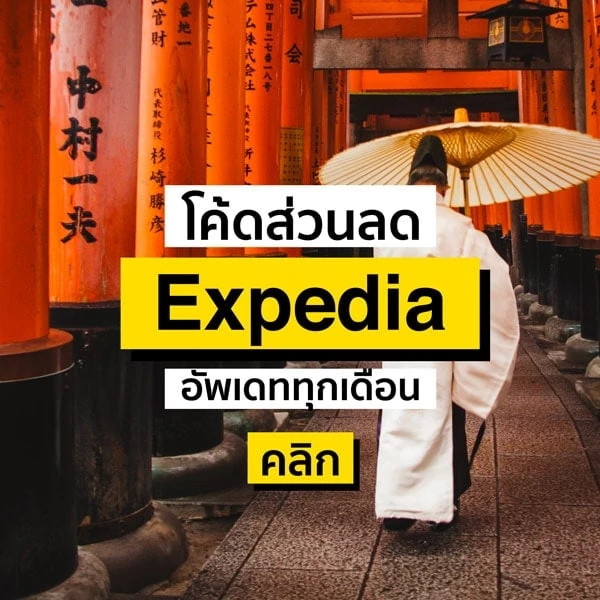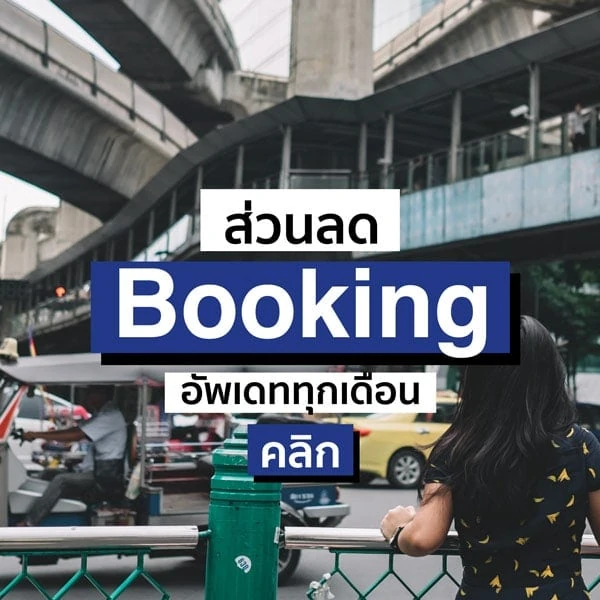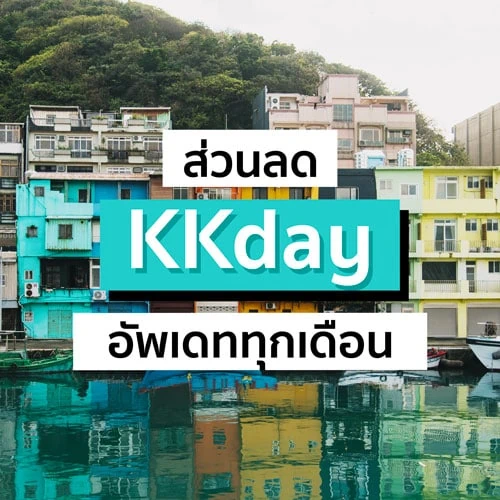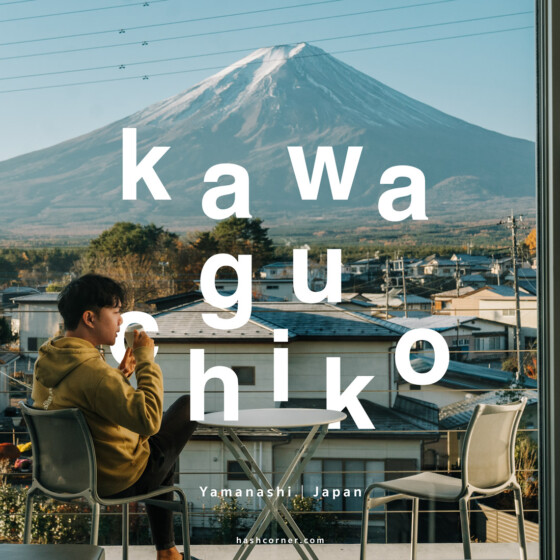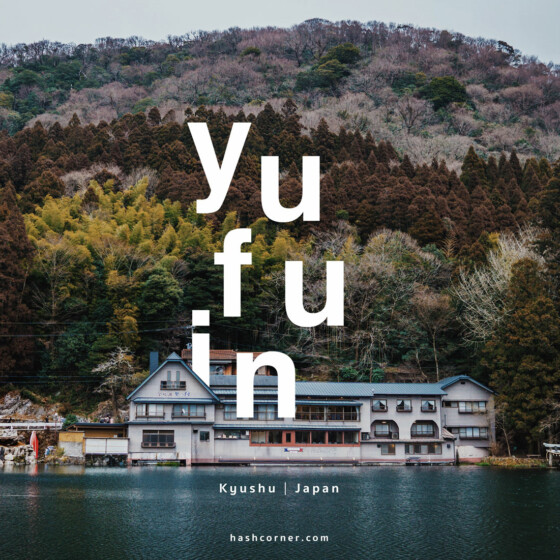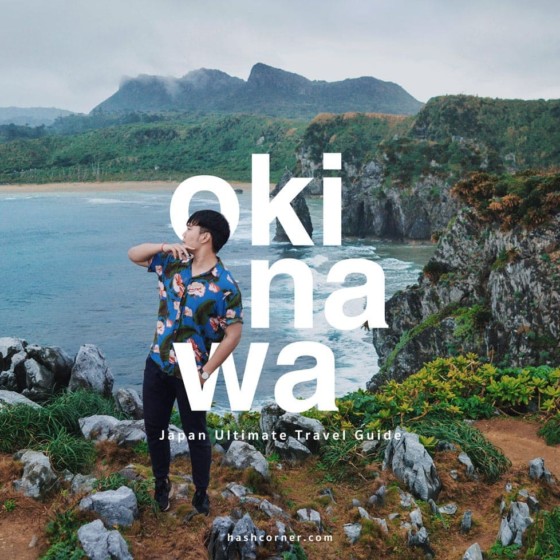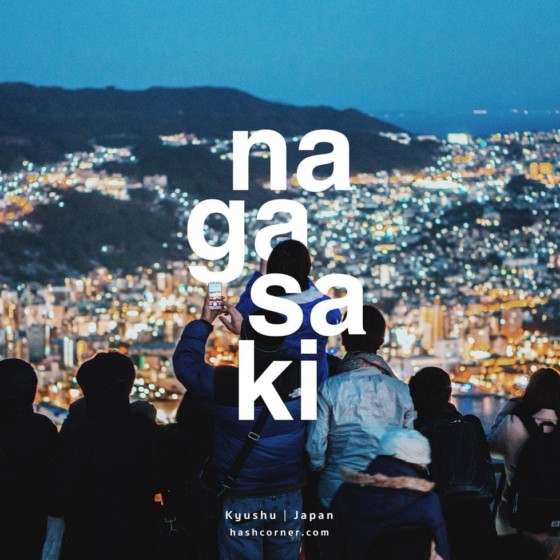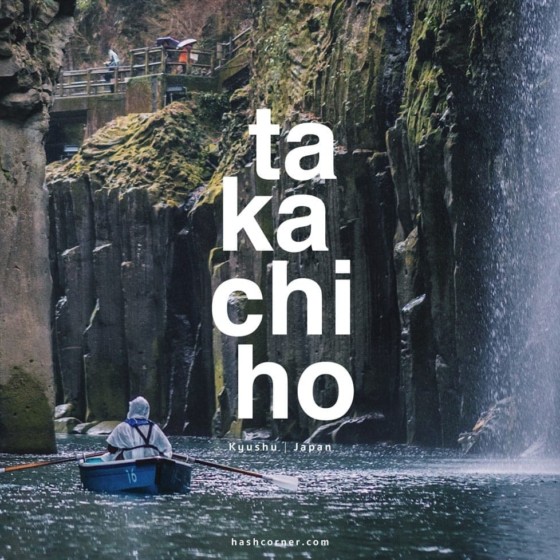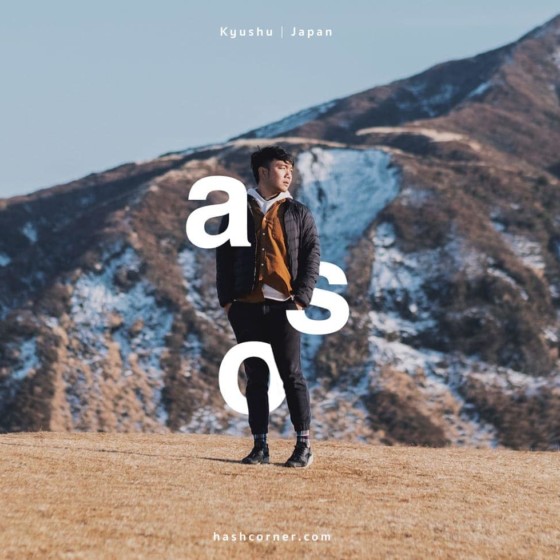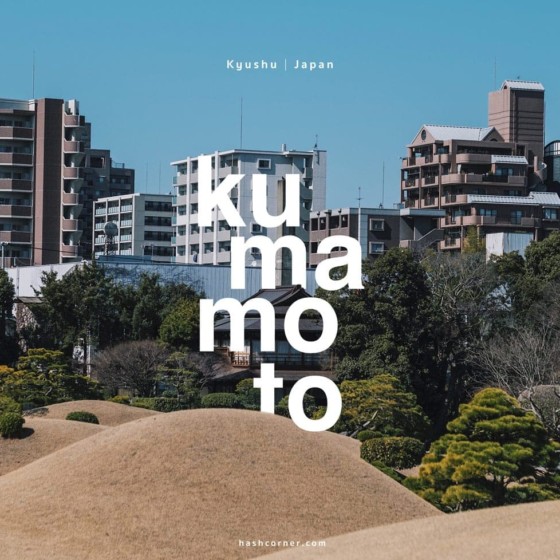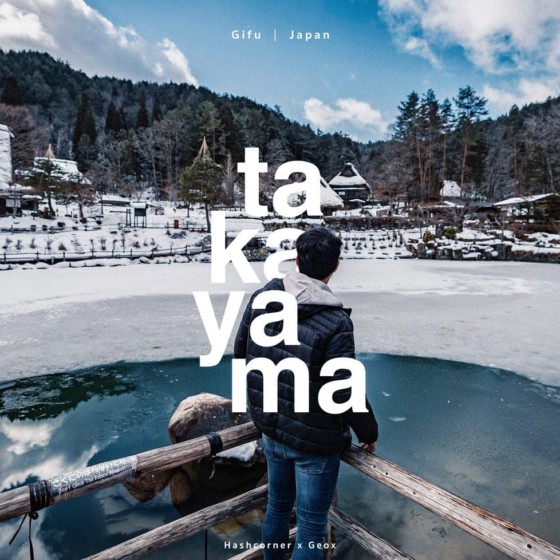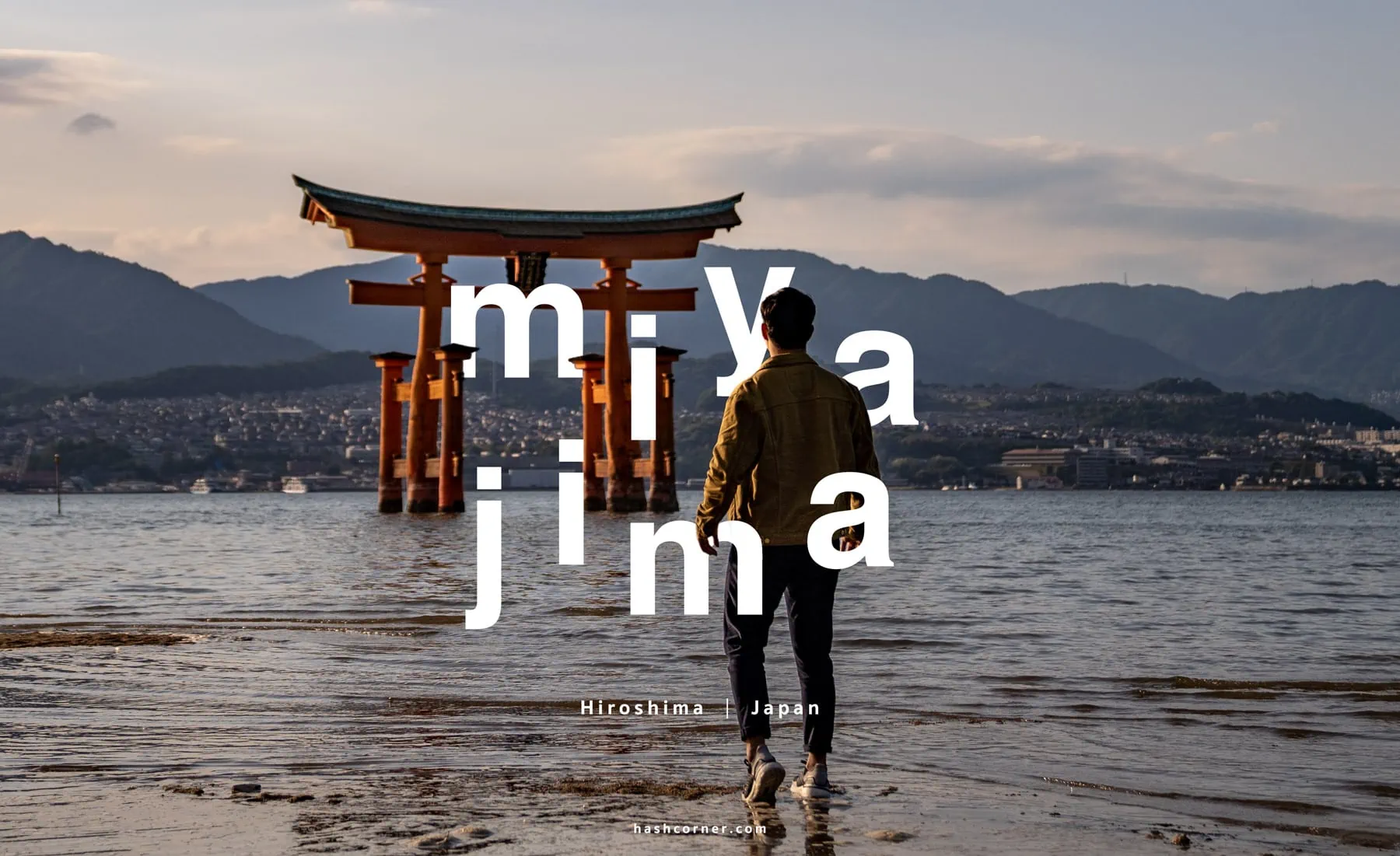
Miyajima Island, also known as Itsukushima, is a name known to anyone who’s a Japan travel enthusiast. For those who aren’t familiar, once you see the photo in this review, you’ll recognize it. The image of the O-Torii Gate is one of the famous landmarks that’s been used in promoting Japan’s tourism for a long time. Let me tell you, it’s absolutely fantastic and truly beautiful (but you have to visit at the right time). No matter how curious or skeptical you are, I suggest we set off on this adventure together. Exciting, right?!
Train Passes That Cover Miyajima Island.
You can use many train passes for your visit to Hiroshima and you can even take the JR ferry to Miyajima Island. It can be confusing to decide which one to use, and that really depends on your specific travel plans in Japan. So, let me list various train passes and you can decide which one fits your plan best. You might want to consider where you’ll land first and what cities you plan to visit. Once you’ve figured that out, you can purchase the appropriate train pass for a more cost-effective and convenient train travel experience. You can compare prices on both Klook and KKday.
- 🎫 Kansai Hiroshima Area Pass: (I used this pass for this review.) This pass covers JR lines that serve popular cities such as Osaka, Kyoto, Nara, Kobe, Wakayama, Himeji, Okayama, and Hiroshima. It allows you to ride the Sanyo Shinkansen between Osaka-Kobe-Okayama-Hiroshima, the Kansai-Airport Express Haruka from Kansai Airport (KIX), and the JR Ferry to Miyajima Island. This pass is valid for 5 days and costs roughly $108. You can purchase it [through Klook] [through KKday]
- 🎫 Sanyo-San’in Area Pass: This pass covers JR lines that serve popular cities such as Osaka, Kyoto, Nara, Kobe, Wakayama, Himeji, Okayama, Hiroshima, Yamaguchi, and Fukuoka. It allows you to ride the Sanyo Shinkansen between Osaka-Kobe-Okayama-Hiroshima-Yamaguchi-Hakata (Fukuoka), the Kansai-Airport Express Haruka from Kansai Airport (KIX), and the JR Ferry to Miyajima Island. This pass is available for 7, 14, and 21 days and costs roughly from $143. You can purchase it [through Klook] [through KKday]
- 🎫 Hiroshima Yamaguchi Area Pass: This pass covers JR lines that serve popular cities such as Hiroshima, Yamaguchi, and Fukuoka. It allows you to ride the Sanyo Shinkansen between Hiroshima-Yamaguchi-Hakata (Fukuoka), and the JR Ferry to Miyajima Island. This pass is valid for 5 days and costs roughly from $90. You can purchase it [through Klook] [through KKday]
- 🎫 Sanyo-San’in-Northern Kyushu Area Pass: Similar to the Sanyo-San’in Area Pass, this pass includes Northern Kyushu. It covers JR lines that serve popular cities such as Osaka, Kyoto, Nara, Kobe, Wakayama, Himeji, Okayama, Hiroshima, Yamaguchi, Fukuoka, Kumamoto, and Nagasaki. It allows you to ride the Sanyo-Kyushu Shinkansen between Osaka-Kobe-Okayama-Hiroshima-Yamaguchi-Hakata(Fukuoka)-Kumamoto, the Kansai-Airport Express Haruka from Kansai Airport (KIX), and the JR Ferry to Miyajima Island. This pass is valid for 7 days and costs roughly from $160. You can purchase it [through Klook] [throughKKday]
- 🎫 Japan Rail Pass – All Area (JR Pass): This pass allows you to use almost all JR trains throughout Japan, including almost all Shinkansen lines. It is available for 7 days and costs roughly $206. You can purchase it [through Klook] [through KKday]
แพลนเที่ยวญี่ปุ่น โอซาก้า-โกเบ-ฮิเมจิ-โอคายาม่า-ฮิโรชิม่า
แนะนำ พาสรถไฟ JR Kansai Hiroshima Area Pass
ญี่ปุ่นรอบนี้ เป็นการมาเที่ยวแถบคันไซ (รอบที่เท่าไหร่แล้วก็ไม่รู้) ซึ่งก๊อตเองได้มาเที่ยวกับแม่สองคนและตั้งใจมาเก็บคันไซฝั่งซ้ายยาวไปถึงภูมิภาคชูโกกุ โดยเฉพาะ ฮิโรชิม่า (Hiroshima) เพื่อไปเก็บแลนด์มาร์คเสาโทริอิขึ้นชื่อ จากนั้นก็กลับมาทางโอซาก้าเรื่อยๆ โดยผ่านทั้งโอคายาม่า (Okayama), ฮิเมจิ (Himeji) และ โกเบ (Kobe) นั่นเอง ซึ่งพาสที่เหมาะสุดกับแพลนนี้ของก๊อตนั้นคือ JR Kansai Hiroshima Area Pass แบบ 5 วัน ในราคา 13,700 เยนนี่แหละ คุ้มสุดแล้วเว้ย
จริงๆ พาสนี้มันไปที่อื่นได้อีกเยอะนะ เพราะมันครอบคลุมทั้งภูมิภาคคันไซ แต่อันนี้เป็นความตั้งใจของก๊อตเองที่จะเก็บฮิโรชิม่าด้วย เลยเลือกเที่ยวเก็บเมืองทางฝั่งนี้ที่บอกไปนั่นเอง โดยวิธีการซื้อก็เหมือนเดิมคือ ซื้อพาสเว็บ KLOOK และไปแลกเป็นพาสจริงที่สนามบินคันไซ จากนั้นก็ใช้ได้เลย โดยการไปทุกเมืองที่ก๊อตบอกไปนั้นใช้รถไฟความเร็วสูงชินคันเซ็นทั้งทริป ดังนั้น คุ้มแน่นอน
| วันที่ | ตัวอย่างการใช้พาส JR Kansai Hiroshima Area Pass |
| 1 | - เดินทางจากโอซาก้า > ฮิโรชิม่า - เที่ยวเกาะมิยาจิม่า (ฮิโรชิม่า) |
| 2 | - เที่ยวฮิโรชิม่า |
| 3 | - เดินทางจากฮิโรชิม่า > โอคายาม่า - เที่ยวโอคายาม่า |
| 4 | - เดินทางจากโอคายาม่า > ฮิเมจิ - เที่ยวฮิเมจิ (ฝากกระเป๋าที่สถานีรถไฟ) - เดินทางจากฮิเมจิ > โกเบ |
| 5 | - เที่ยวโกเบ |
| ราคาปกติหากไม่ใช้พาส: 25,290 เยน* (คิดโดยการใช้รถไฟชินคันเซ็นระหว่างเมืองทั้งหมด) ราคาพาส JR Kansai Hiroshima Area Pass: 13,700 เยน | |
ซื้อพาส JR Kansai Hiroshima Area Pass จาก KLOOK ข้างล่างนี้เลย
ส่วนลด KLOOK ประจำเดือน คลิกที่นี่
รีวิวเที่ยวญี่ปุ่นโอซาก้า-โกเบ-ฮิเมจิ-โอคายาม่า-ฮิโรชิม่า
1. โอซาก้า (Osaka)
2. โกเบ (Kobe)
3. ฮิเมจิ (Himeji)
4. โอคายาม่า (Okayama)
5. เกาะมิยาจิม่า (Miyajima)
6. ฮิโรชิม่า (Hiroshima)
Hiroshima Travel Plan
For the Hiroshima itinerary, my primary plan consists of spending one day touring the city of Hiroshima and another day exploring Miyajima Island. I believe this approach pretty much covers the highlights of Hiroshima. You get to delve into Hiroshima’s history during the World War era, as well as visit the sacred ‘Miyajima’ island, revered by many Japanese. Plus, you’ll get to witness the famous landmark, the O-Torii Gate, which is on many people’s bucket lists.
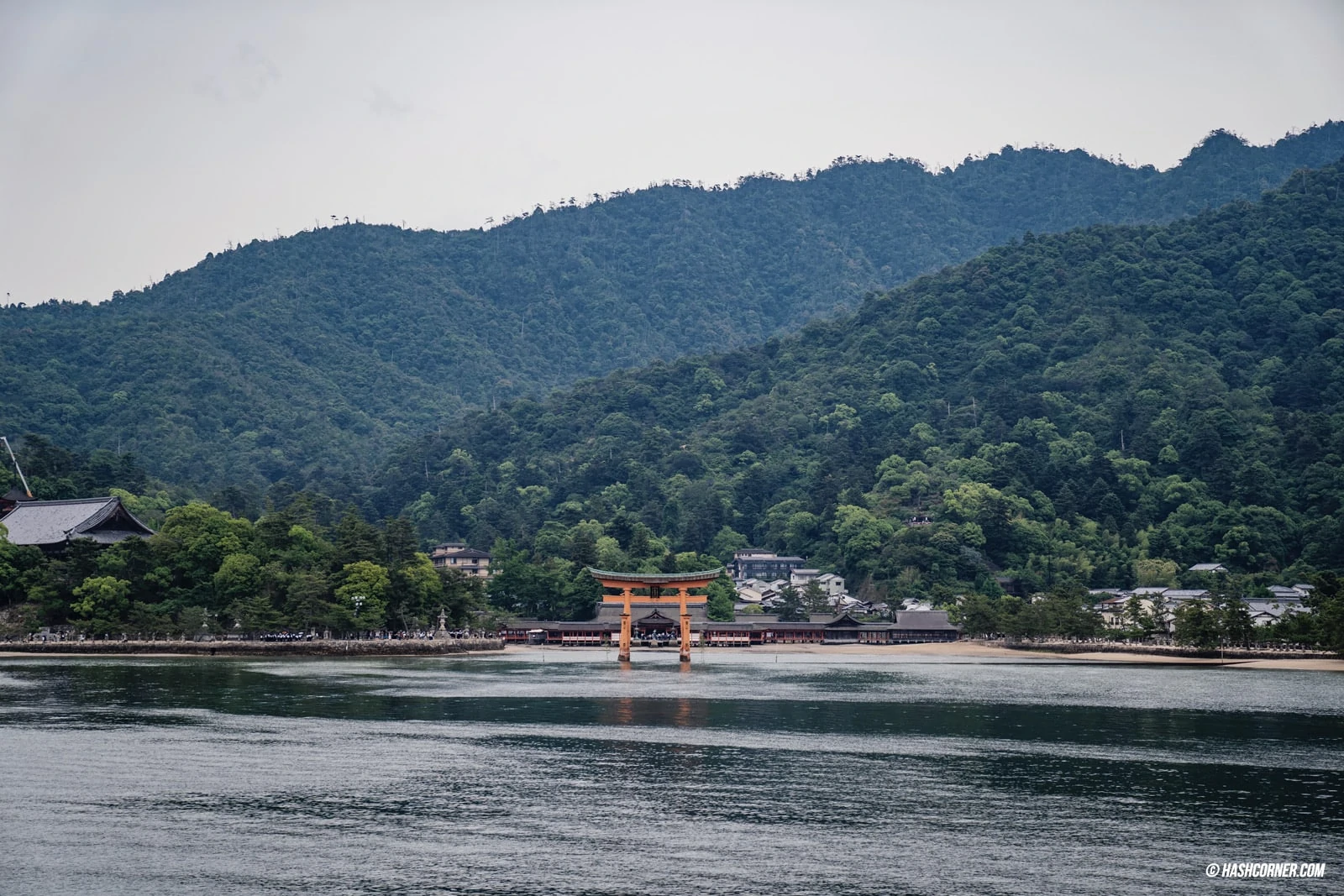
Personally, I think Hiroshima is a splendid and well-rounded city. It’s a must-visit for anyone interested in World War history. Traveling there provides a full-on, intense understanding of the atrocities and pressures of that time. Then, Miyajima Island offers a more fun and relaxing experience, with lots of picture-taking, encountering adorable deer, and doing a little mountain climbing. It’s also a chance to snap loads of pictures with one of Japan’s renowned landmarks. So, let’s dive into the travel plan!
| Day | Attractions |
| 1 | Miyajima / Itsukushima – Itsukushima Shrine – Daishoin Temple – Momijidani Park – Mount Misen – Senjokaku / Five-storied Pagoda – O-Torii Gate |
| 2 | Hiroshima – Hiroshima Atomic Bomb Dome – Hiroshima Peace Memorial Park – Hiroshima Peace Memorial Museum – Hiroshima Castle – Shukkeien GardenClick to read full review of Hiroshima |
| OTA Discount |
Where to Stay on Miyajima Island
For those planning to visit Miyajima Island, you can choose to stay in downtown Hiroshima and make a day trip to Miyajima. The journey takes approximately 45 minutes one way. However, if you wish to experience traditional Japanese accommodation, staying on Miyajima Island is a great alternative. For this section, I’ll only recommend accommodations on Miyajima Island.
🏨 Recommended Hiroshima accommodations from Agoda / Expedia / Booking.com
1. Miyajima Island
For those who want to immerse themselves more deeply in the ambiance of Miyajima Island without being part of the day-tripper crowds, I recommend staying on the island. Especially, the Ryokan (traditional Japanese inn) offers excellent options to choose from. If you decide to stay on Miyajima Island, I advise booking accommodations that include dinner. If not, check whether the hotel has a restaurant because most shops and restaurants on the island usually close around 6 p.m. Lastly, hotel and Ryokan prices on the island are relatively high but not overly exorbitant. Anyway, here’s a list to help you decide.
- Top-notch, luxurious Ryokans (more than $300/night): Itsukushima Iroha (⭐️ with onsen ) / Iwaso Ryokan (with onsen) / Jukeiso (with private Onsen)
- Good, affordable hotels ($180-$300): Miyajima Grand Hotel Arimoto / Hotel Miyajima Villa
- Budget-friendly hotels (less than $180): Auberge Mizuhaso / Oyado Tsukiusagi
Day 1: Miyajima Island / Itsukushima Island
On the first day of your Hiroshima trip, let’s begin with a visit to Itsukushima Island, more commonly known as Miyajima Island. If you’ve never heard of this name, you’ve definitely seen pictures of its renowned site – the O-Torii Gate, a vermilion gate standing in the middle of the sea, that’s famous worldwide. Visiting Hiroshima without dropping by here is a big no-no, a must-visit!
🛥 How to take a ferry to Miyajima Island
Since I stayed at a hotel near Hiroshima Station, it was super convenient. From Hiroshima Station, we can take a JR train for about 30 minutes to reach Miyajimaguchi Station, where the ferry terminal is located. At the terminal, there are two ferry operators, one on the left and the other on the right (which belongs to JR). You can spot the JR terminal easily because it has a huge sign.
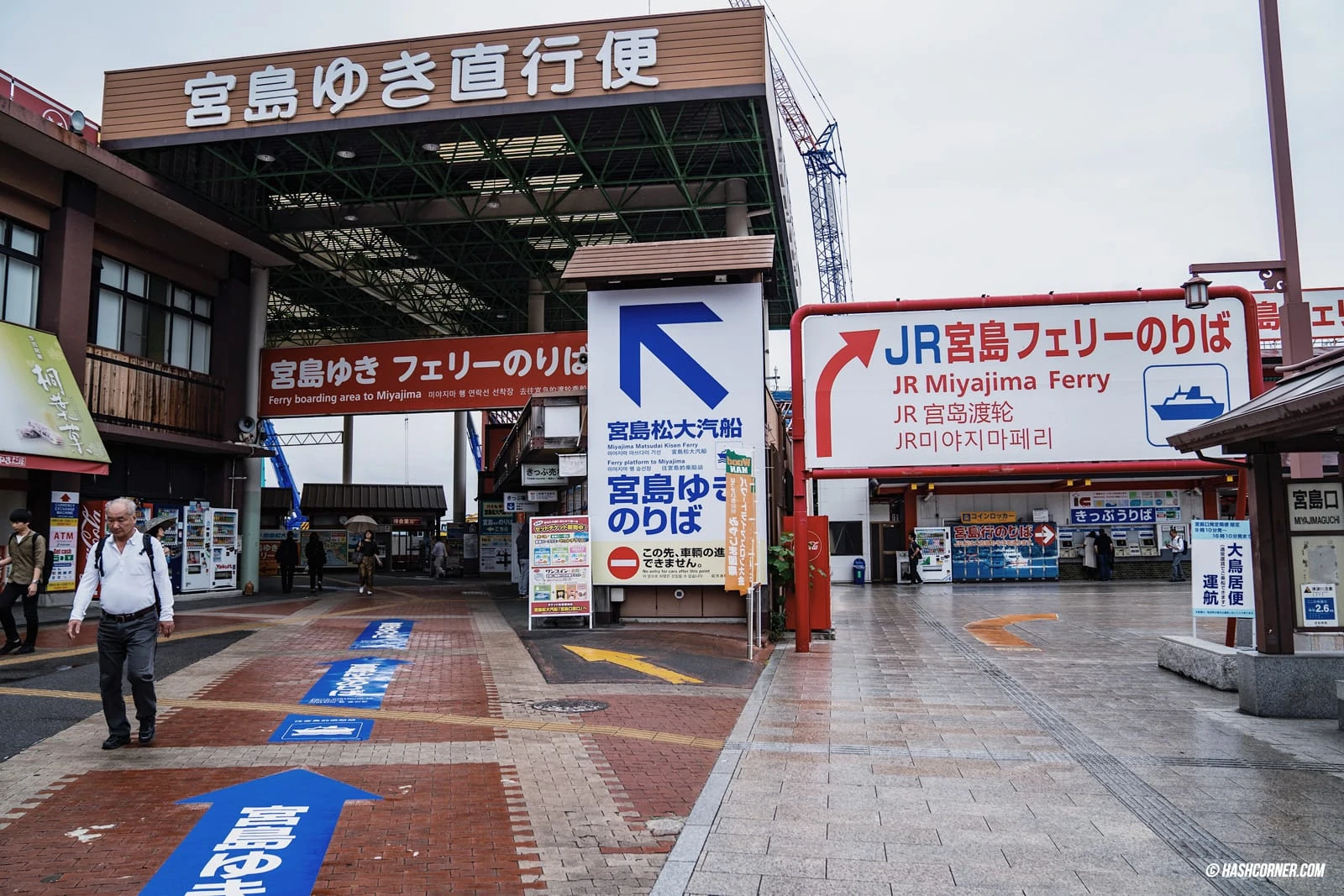
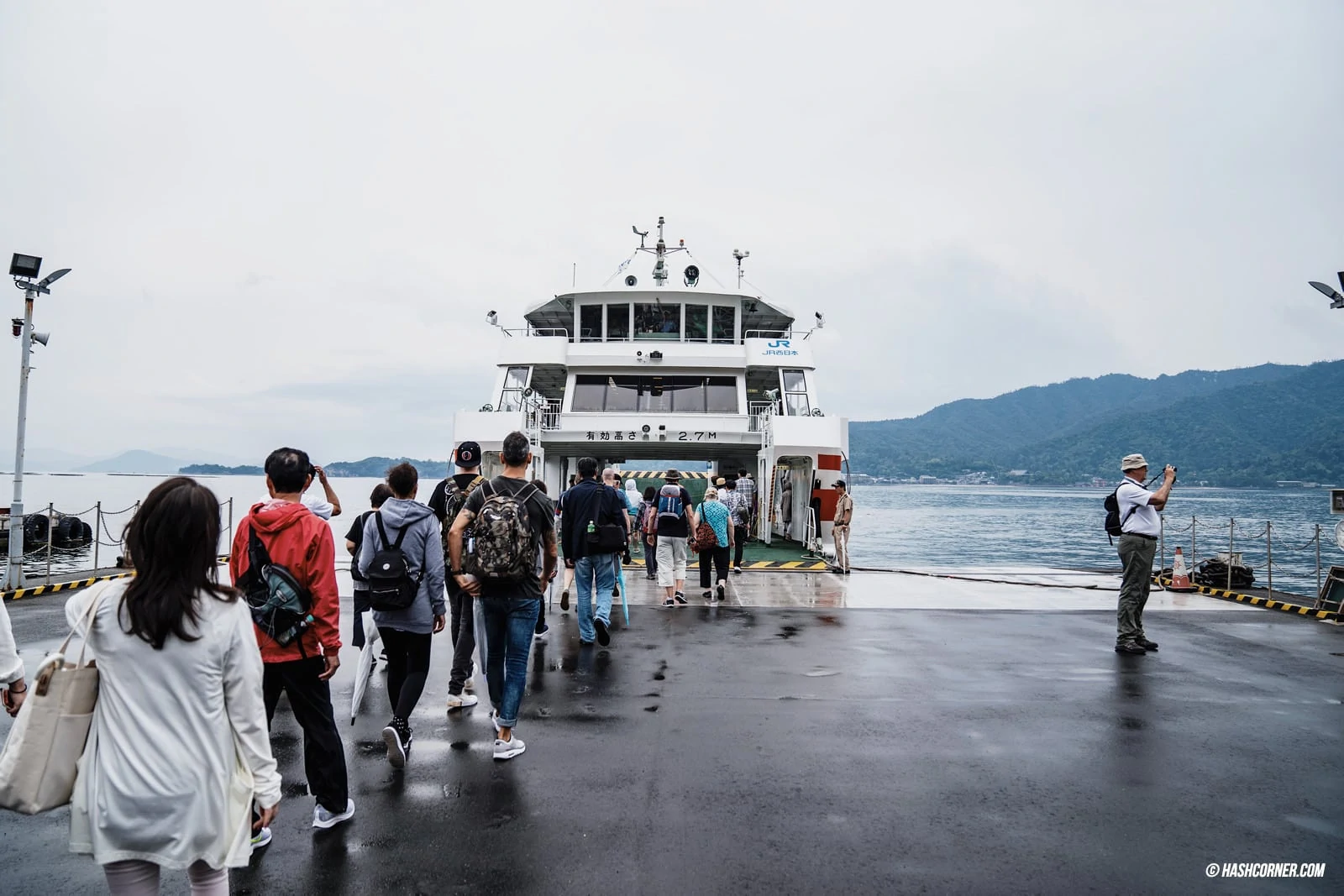
⚡️ At this point, if you have a JR PASS, you can use it to ride the JR ferry to Miyajima Island for free! As I had a JR Kansai Hiroshima Area Pass, I took the JR ferry. For those who don’t have a pass, check the prices at the ferry terminal. I’m not sure which operator offers a better deal.
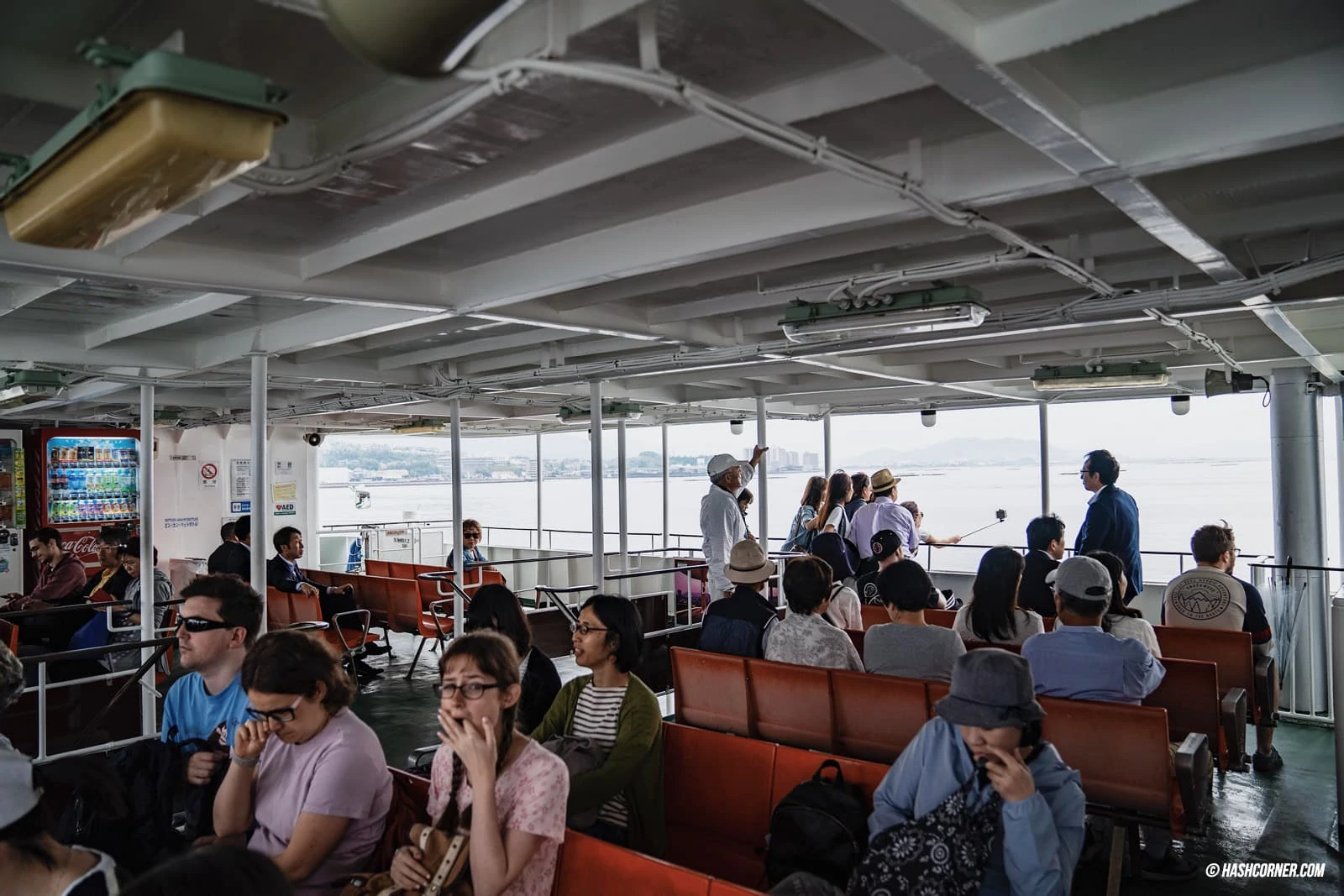
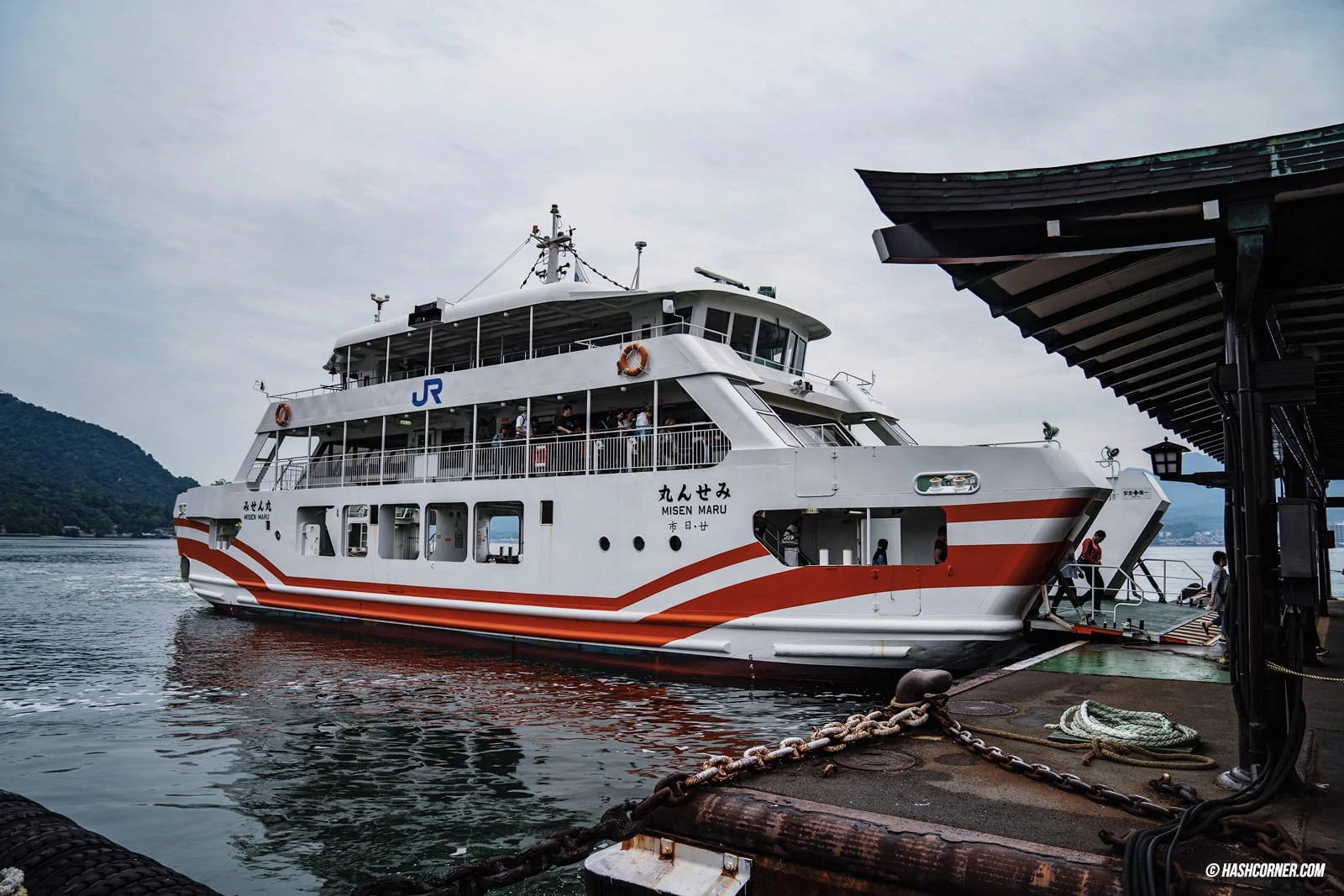
The first destination on Miyajima Island should be the Itsukushima Shrine and the O-Torii Gate, both at the same location. You can enjoy a leisurely walk around this area where many shops sell sweets and cute souvenirs. There are also adorable deer that you can play with. These deer are so peaceful and neat, much more so than those in Nara! Hahaha.
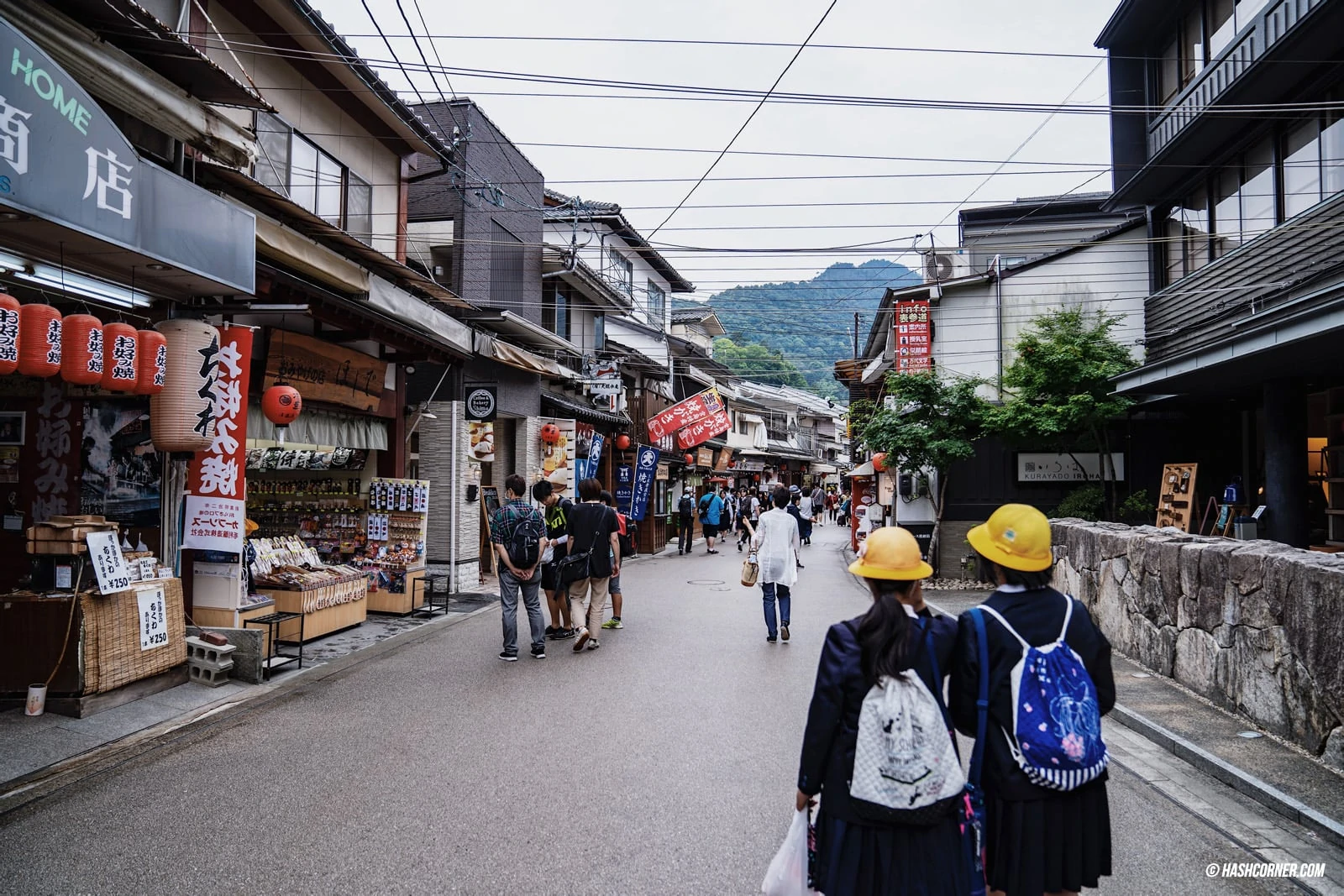
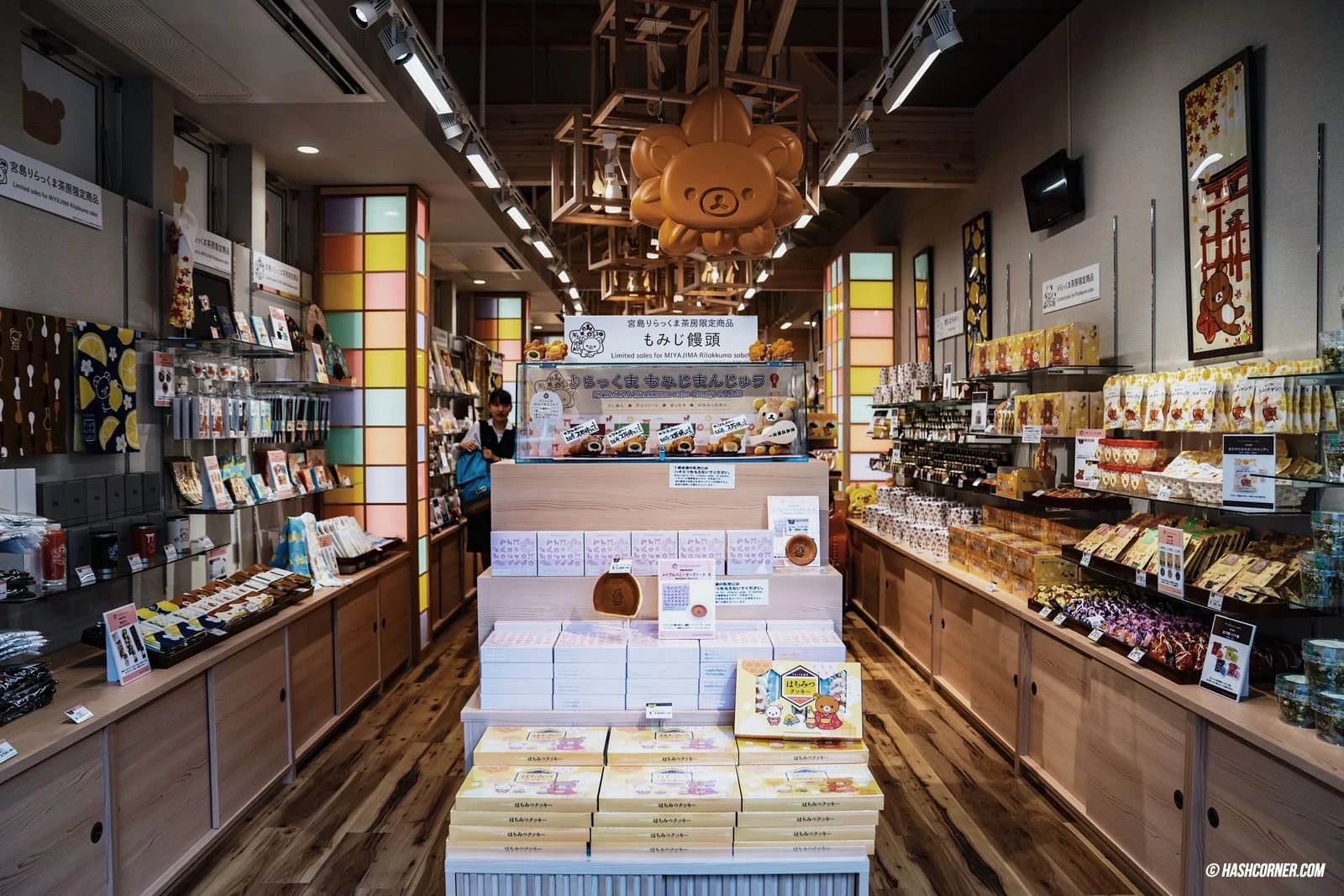
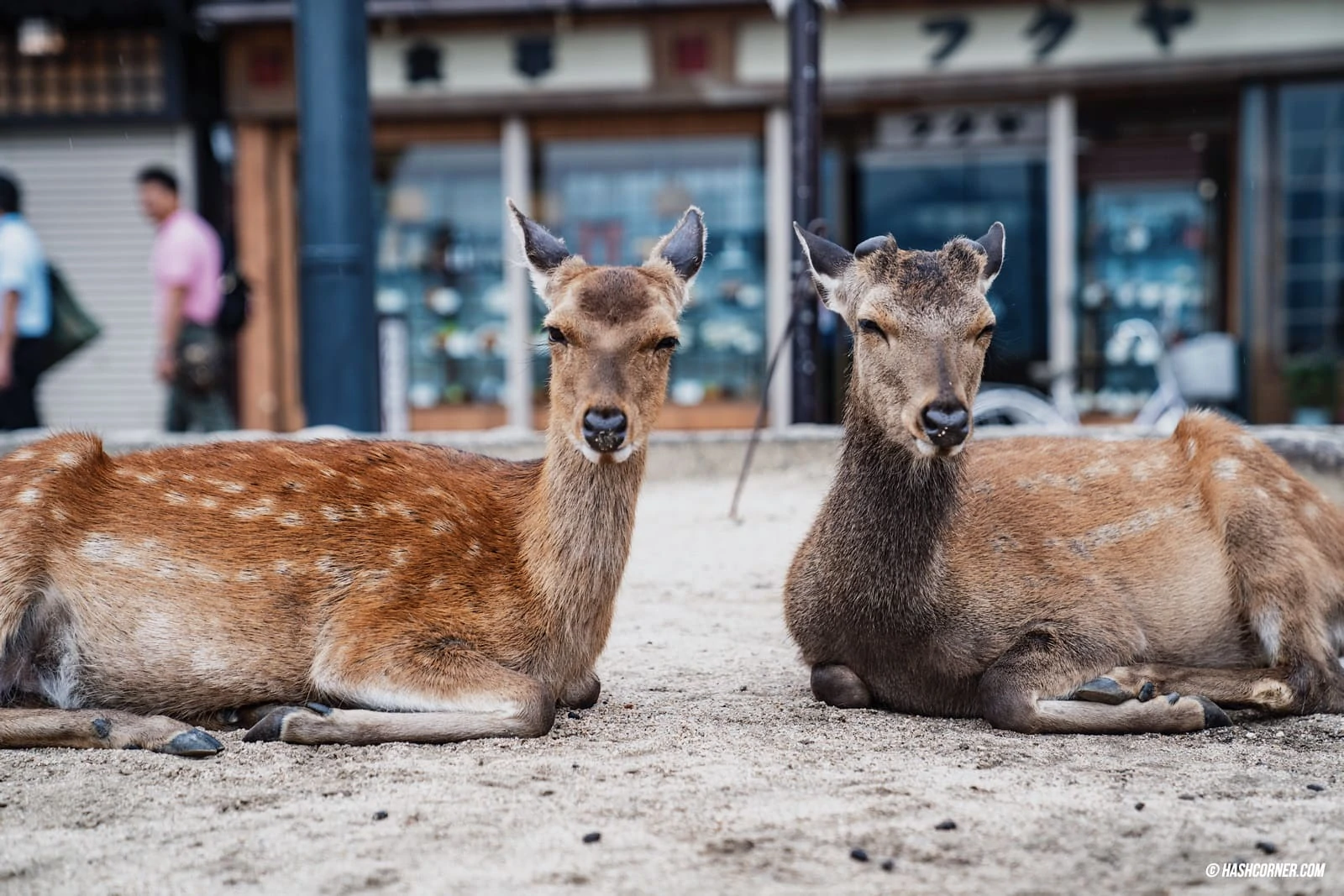
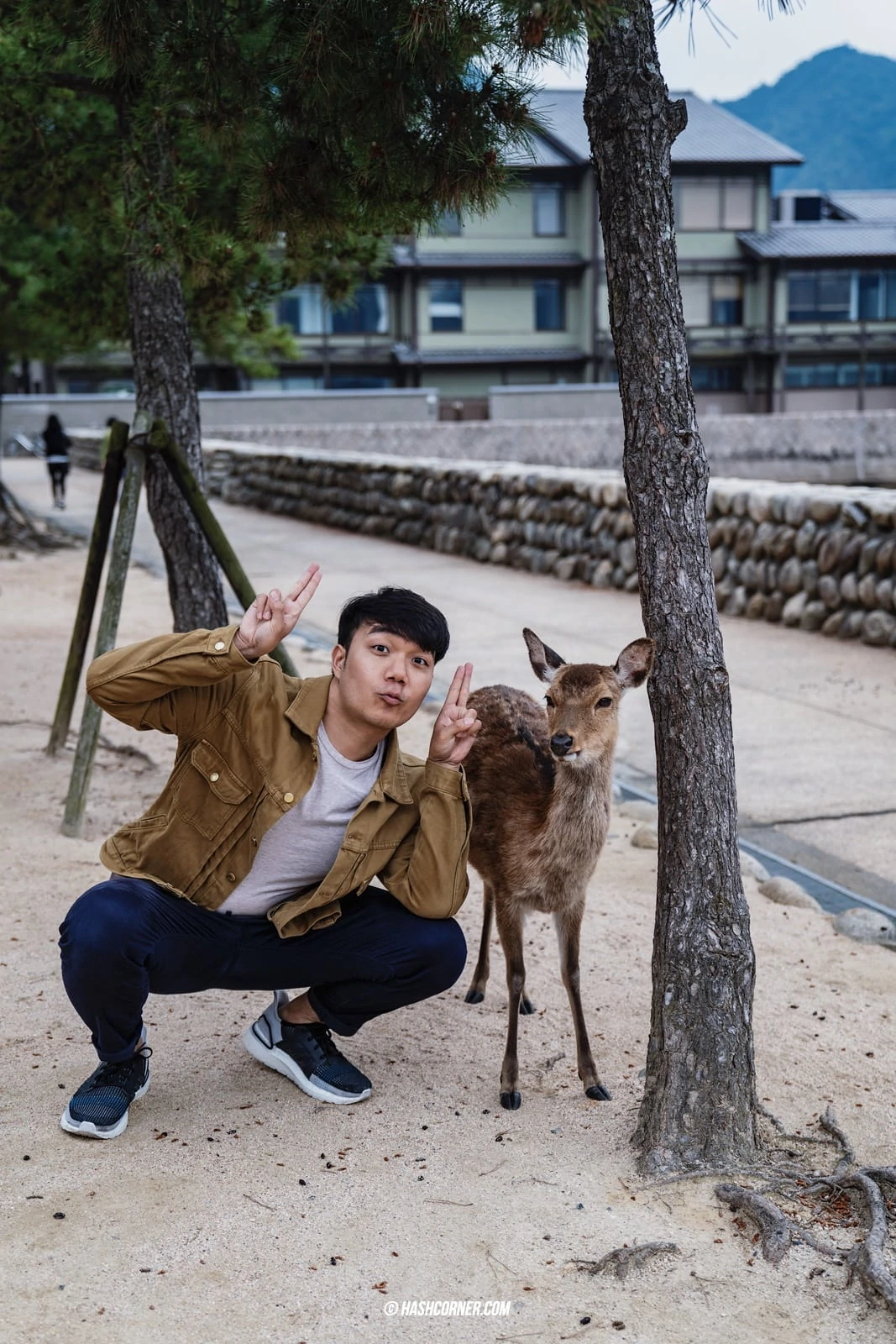
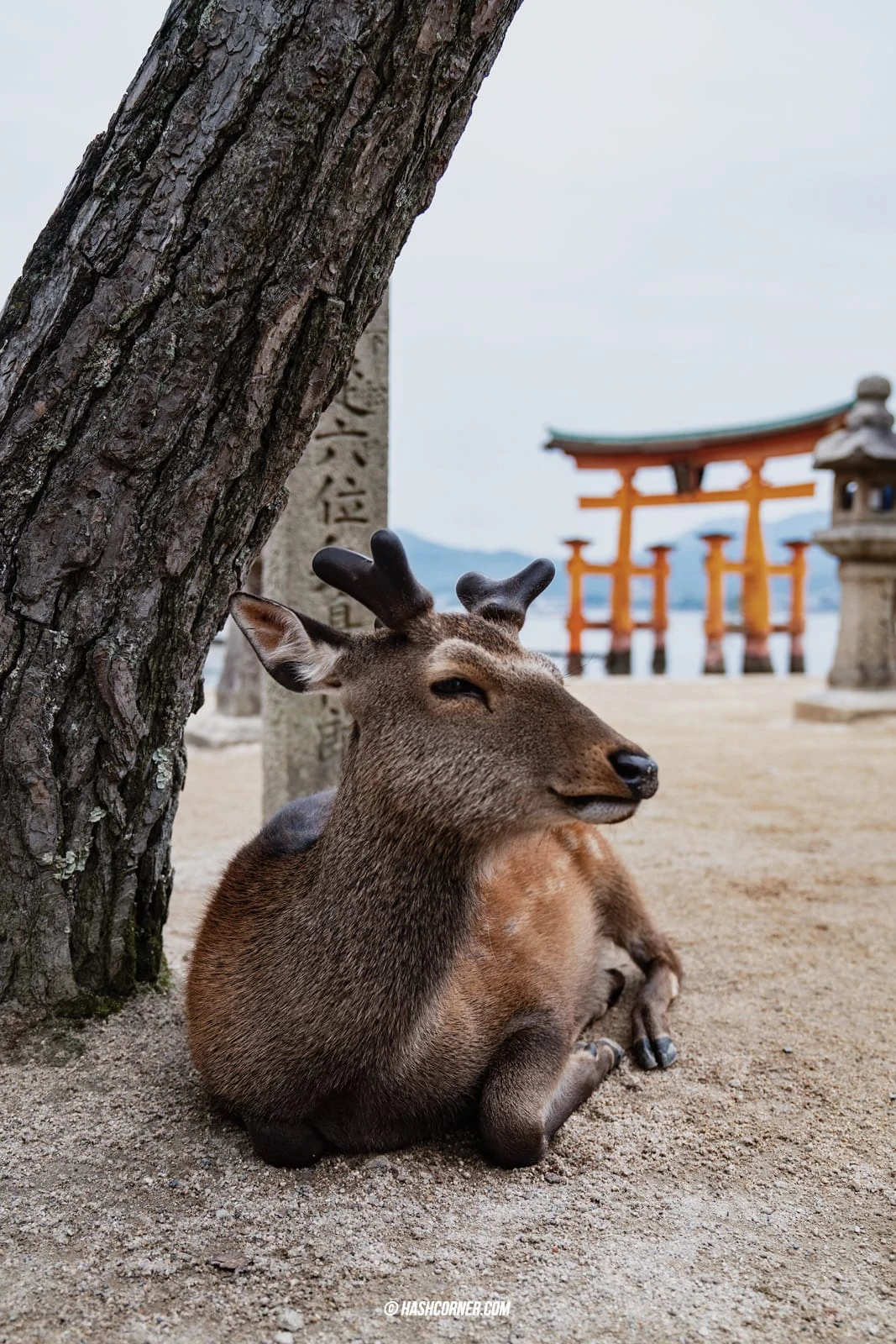
Itsukushima Shrine
When you first arrive at Itsukushima Shrine, you know instantly that this is the landmark of the island. Most tourists flock here to admire both the shrine and the renowned O-Torii Gate. We got there later in the day, just when the tide had receded to its lowest, allowing us to walk along the beach and get a close-up view of the gate. If you happen to visit during low tide, I recommend checking out the gate first before heading to the shrine, as there’s an entrance fee for the latter, and it can be a bit of a climb to get out.
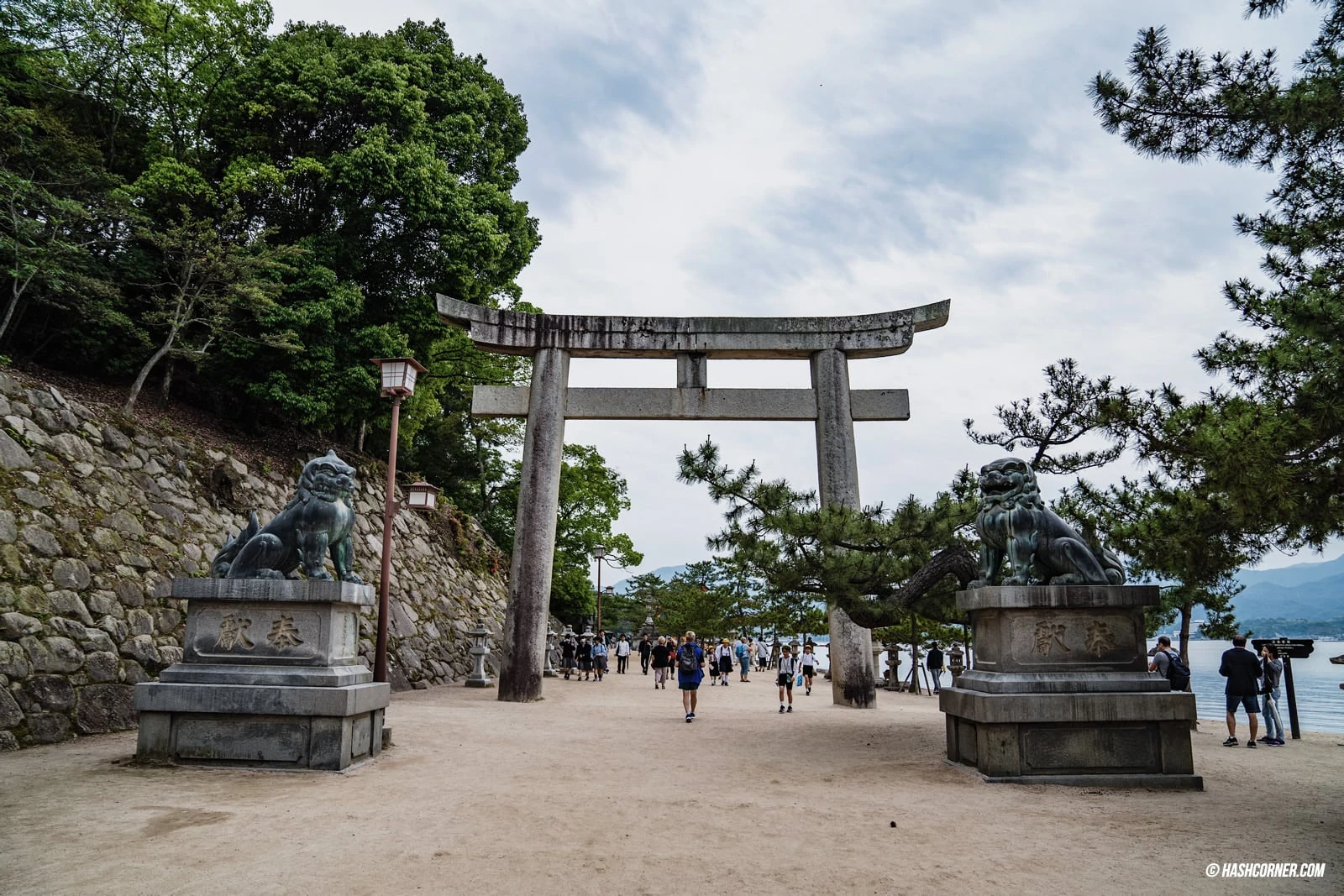
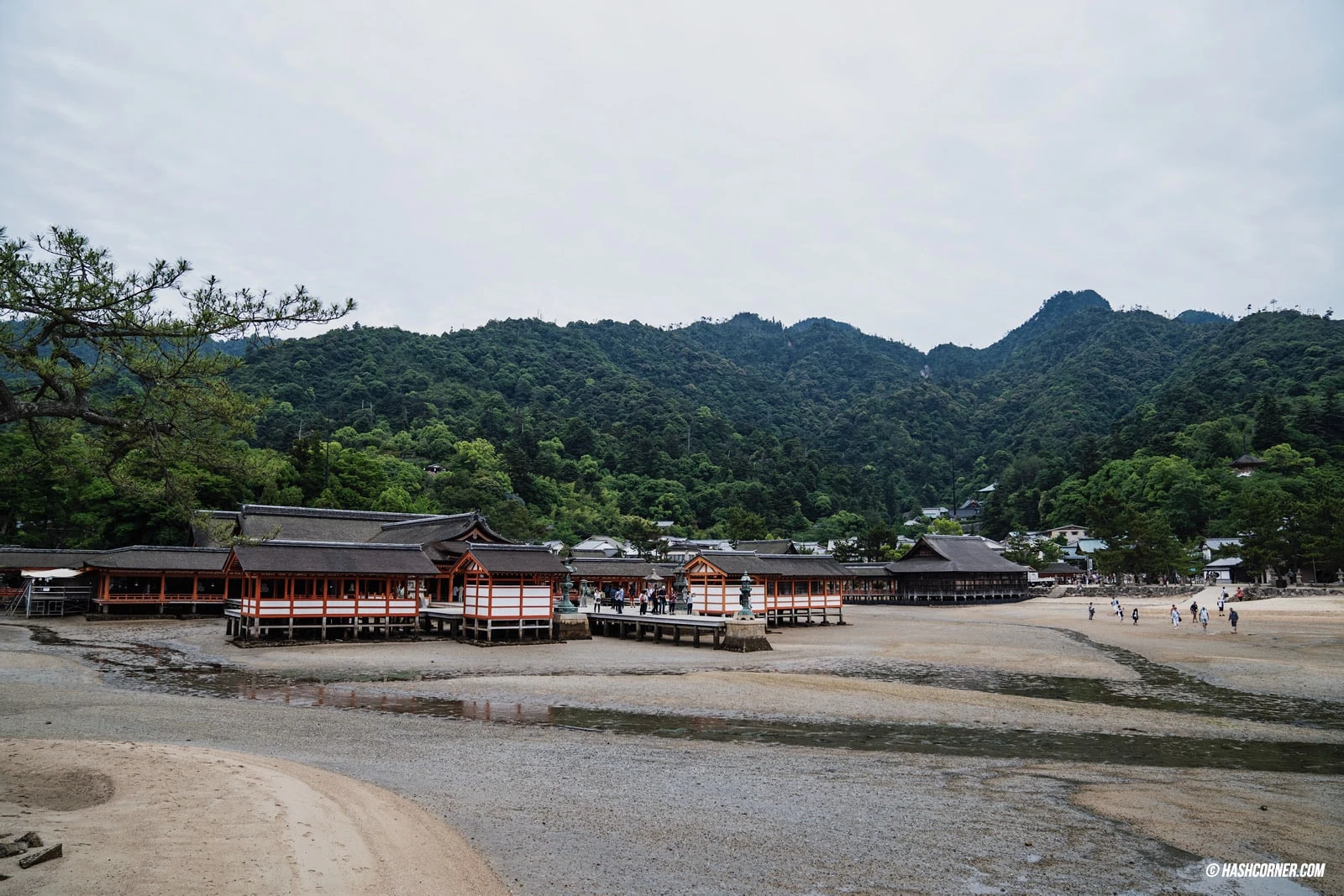
The O-Torii Gate is an integral part of Itsukushima Shrine and is considered a significant cultural landmark of Japan. The main posts are made from camphor wood, while the supporting posts use cedar. Weighing in at around 60 tons, the gate’s sheer weight keeps it standing in the middle of the sea without the need for piles. And would you believe it? This impressive structure is over 100 years old. Wow!
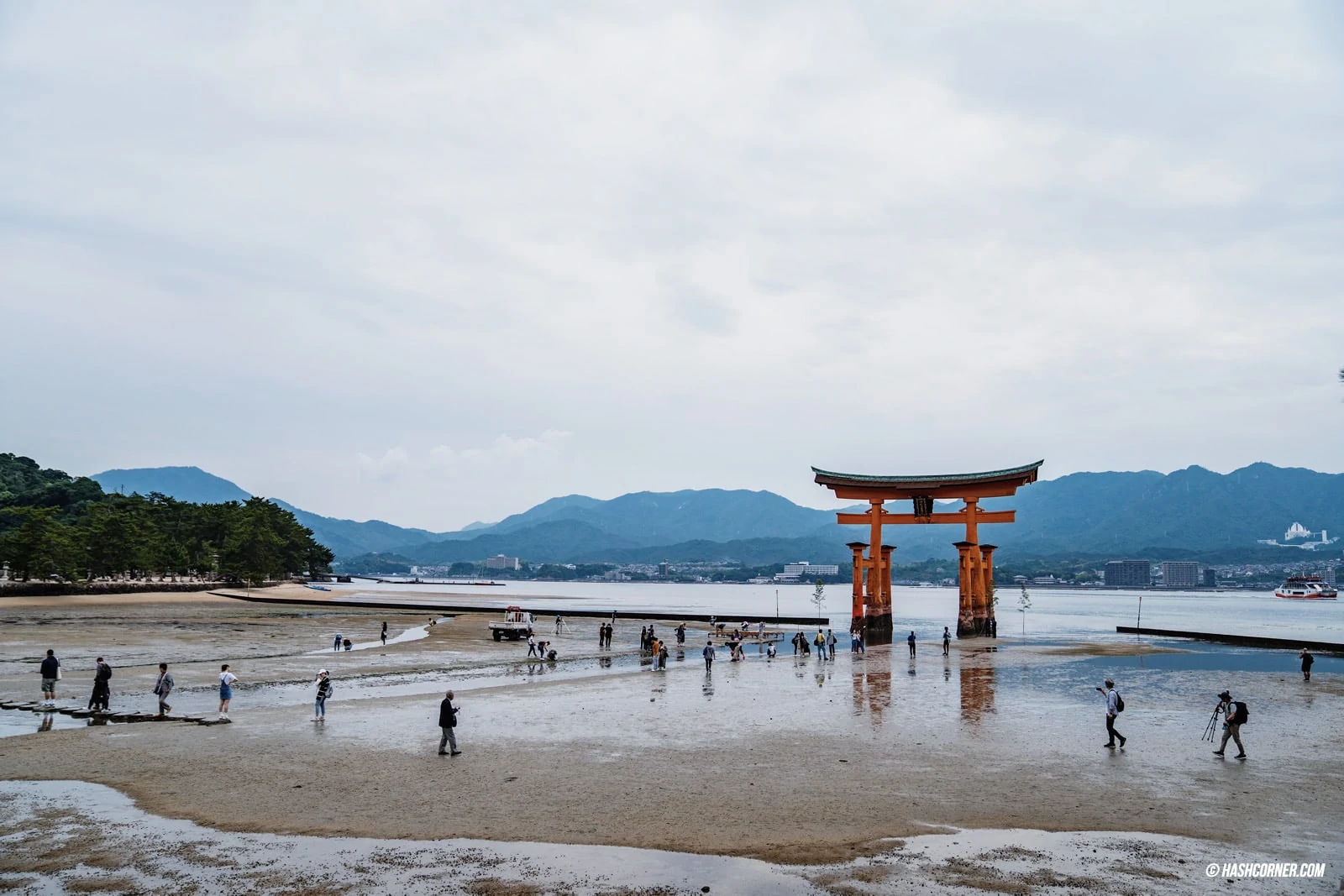
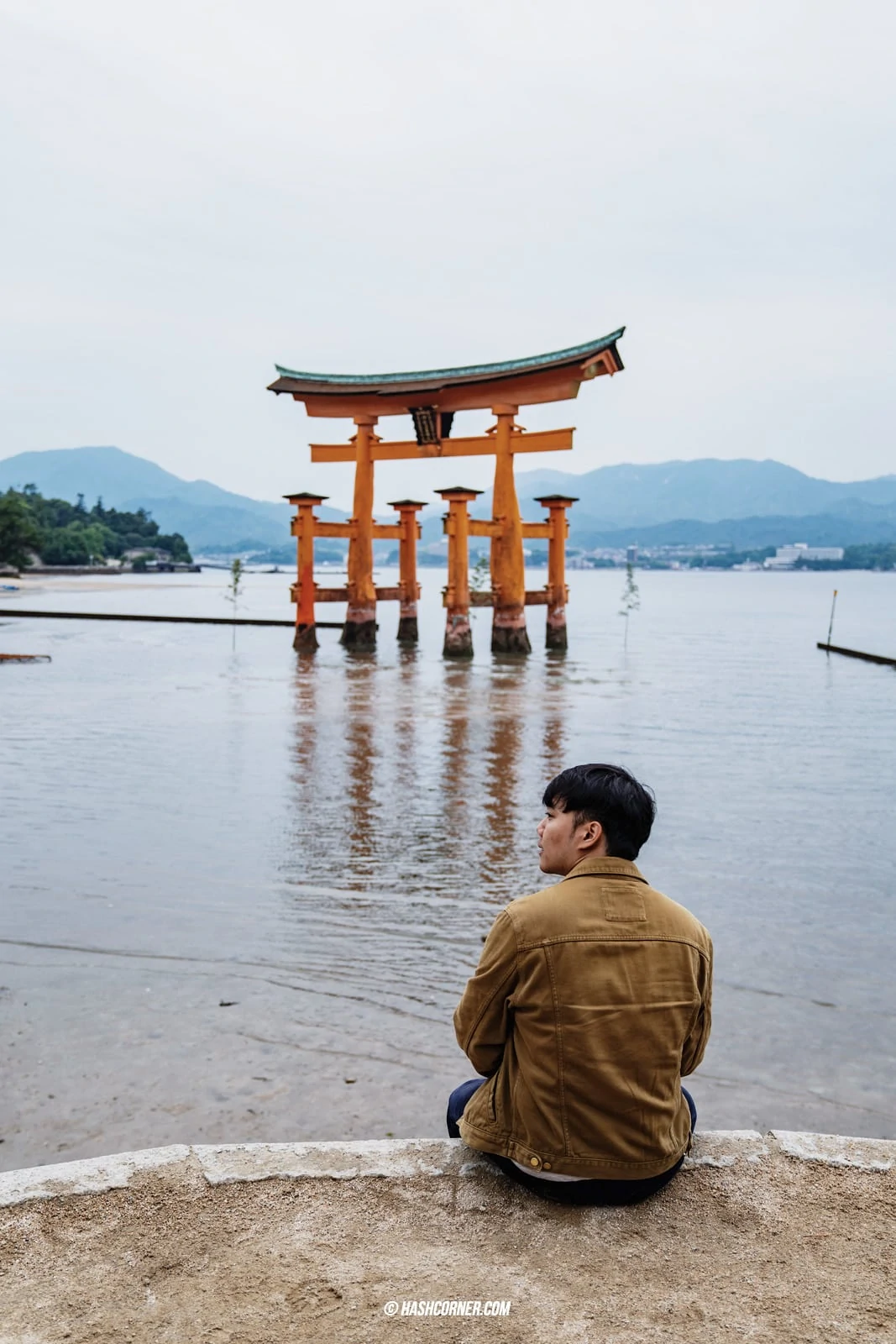
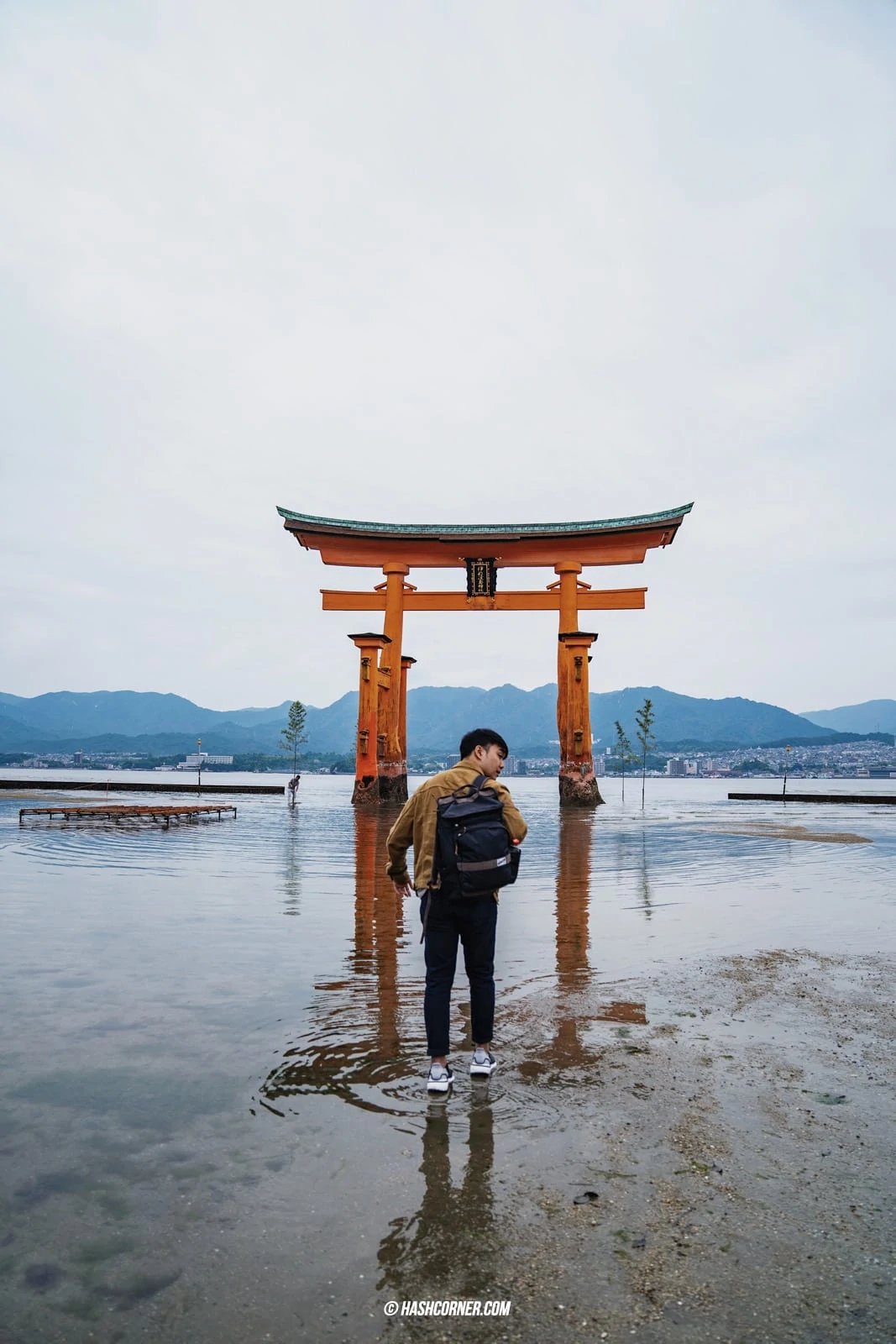
At that moment, it was unbelievable to see the gate with my own eyes. It was beautiful, harmonizing perfectly with the surrounding atmosphere and landscape. But let me tell you, it’s incredibly breathtaking at dusk when the tide rises, making the gate appear as if it’s floating on water. I plan to return here in the evening to experience that sight.
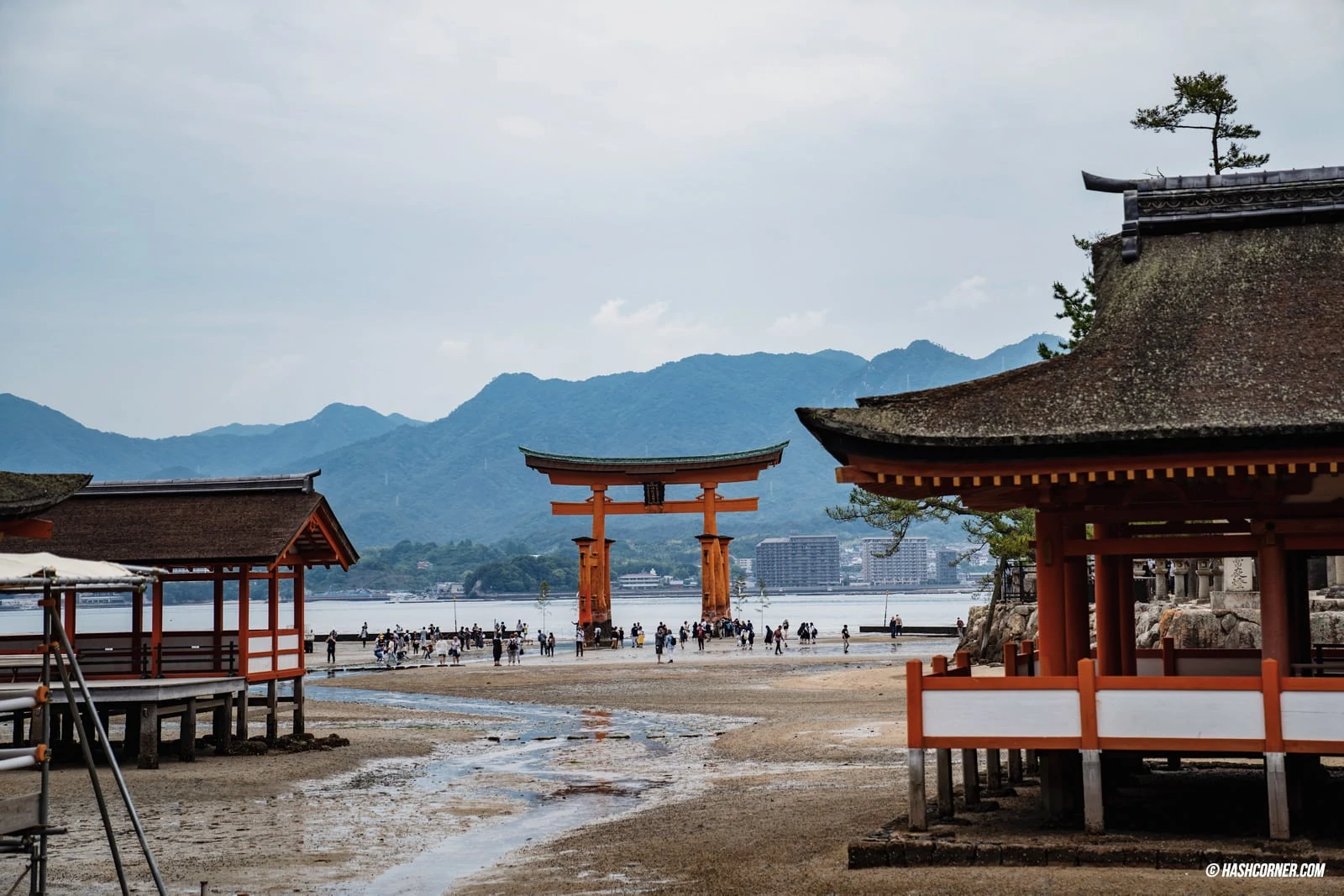
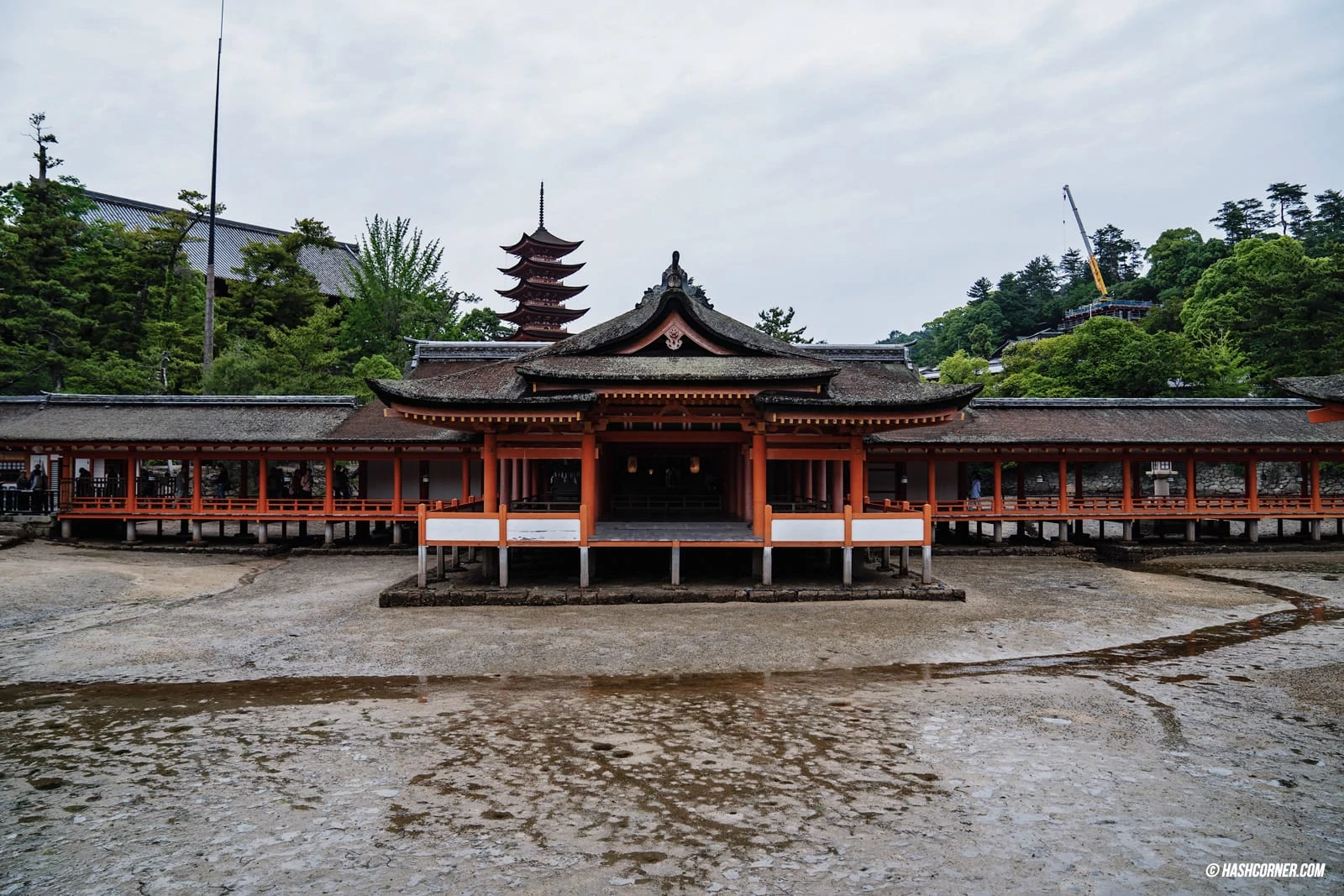
Adjacent to the gate is Itsukushima Shrine, which is one of Japan’s most valuable shrines. This Shinto shrine, over 1,400 years old, was built to worship three goddesses, who are the daughters of Susanoo-no-Mikoto, the god of seas and storms. Furthermore, it venerates the island itself, which locals consider sacred and even divine.
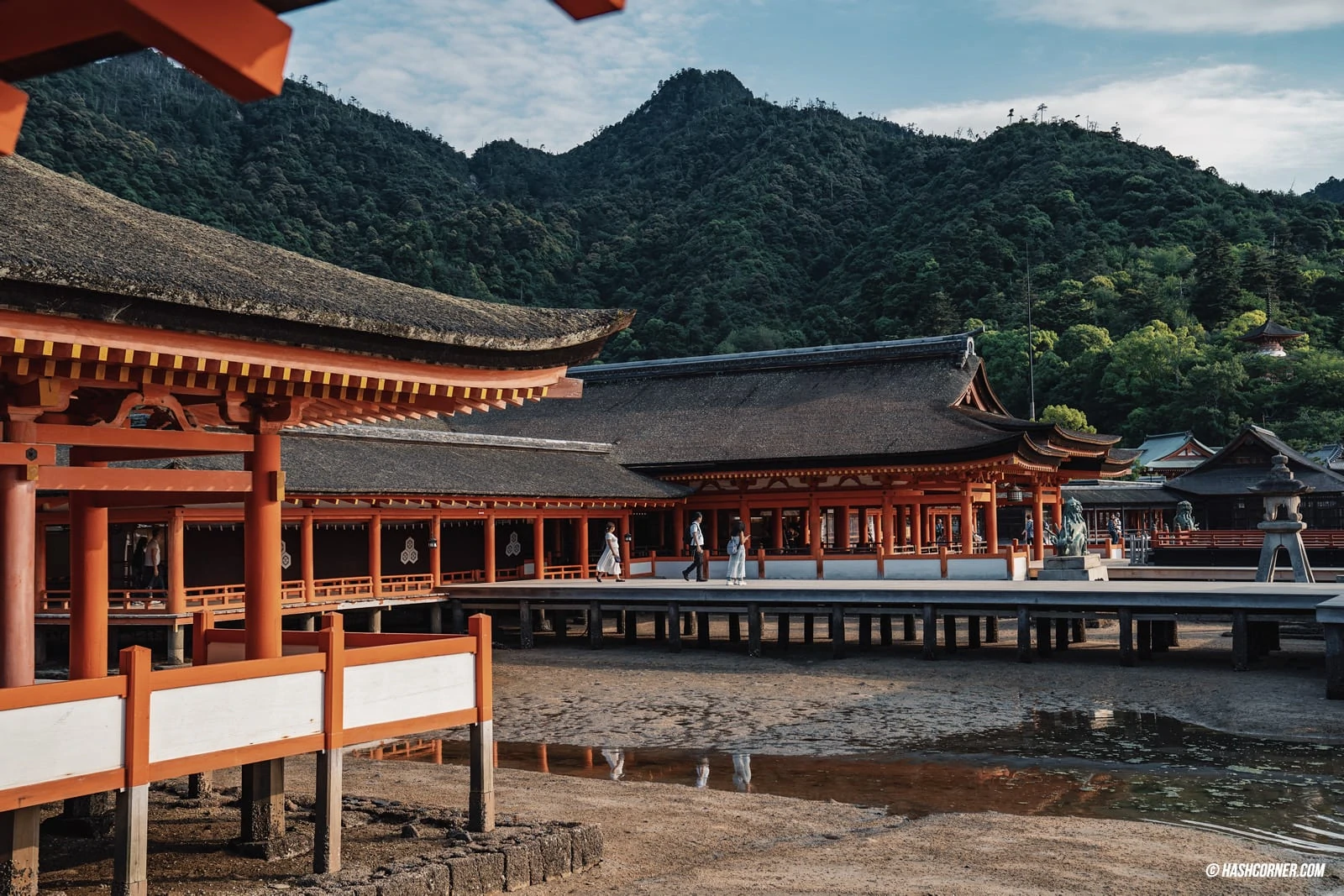

Itsukushima Shrine is revered as a pure Shinto shrine, so birth, death, and burials are strictly forbidden on this island or nearby areas. This rule extends to heavily pregnant women and very elderly people who are not allowed to live on the island. (It sounds a bit harsh, doesn’t it?) Beyond this purity, the shrine was designed to resemble a floating boat during high tide because the island was deemed so sacred that ordinary people could neither touch nor step on it. In the past, this shrine served as a sort of pier for people boarding and disembarking from the island, with the O-Torii Gate functioning as an entrance gate for those traveling by boat.
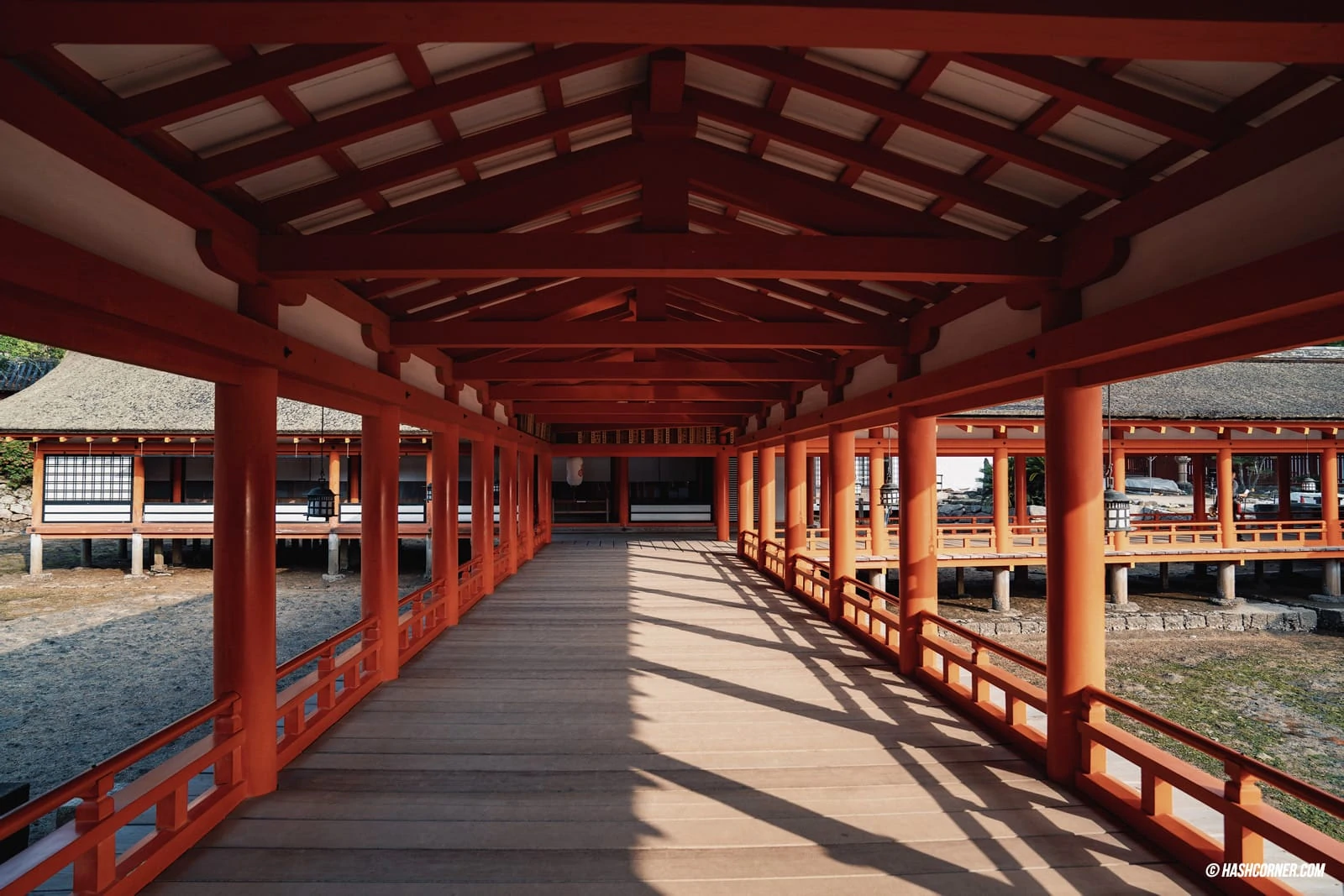
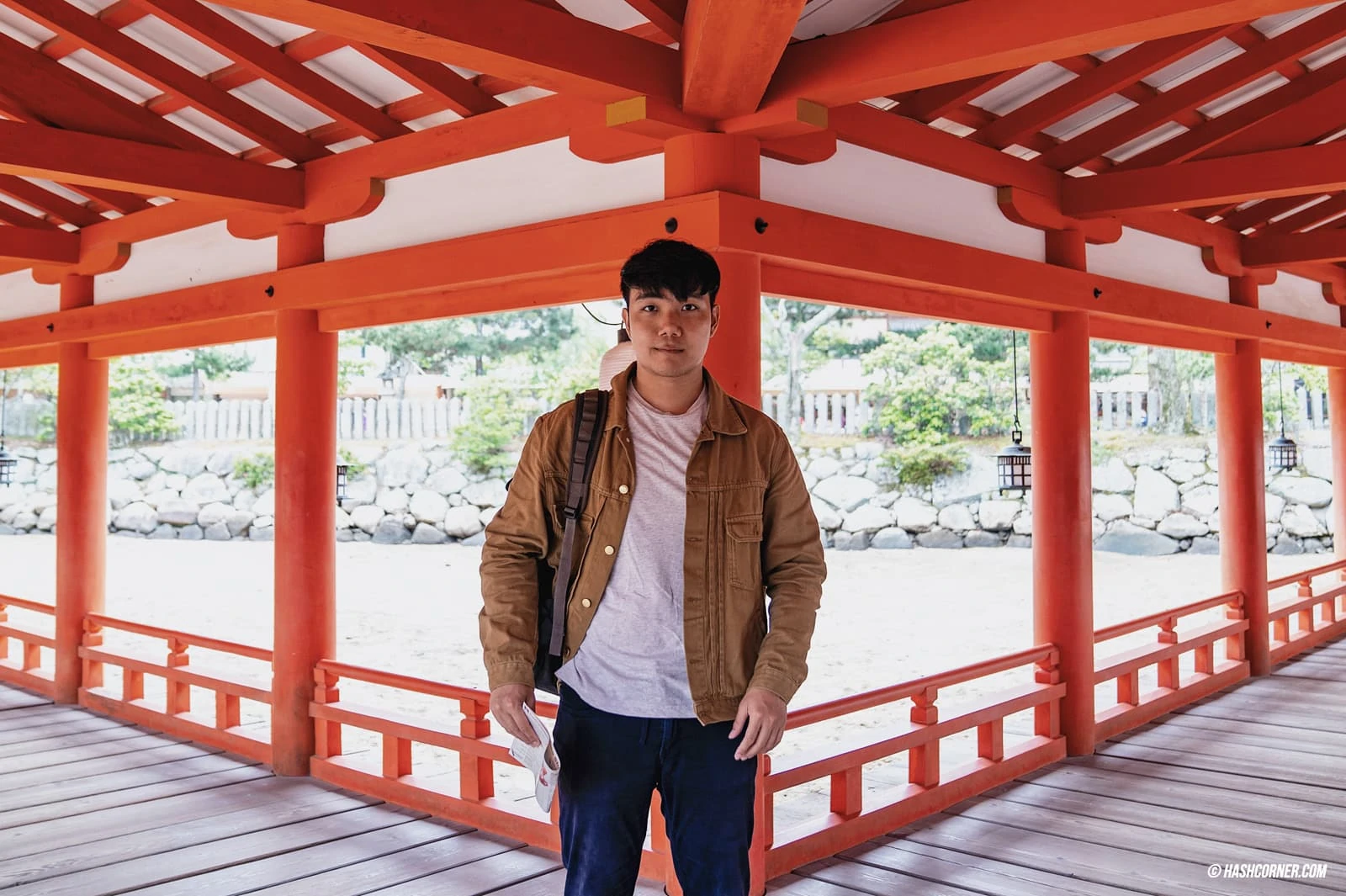

To explore the shrine, there’s a maintenance fee of 1,000 yen. You can pay your respects to the three goddesses and even cross over to the other side to continue exploring other parts of Miyajima Island.
Daisho-in Temple
Daisho-in Temple is one of the most important temples on Miyajima Island. It was established in 806 AD by the renowned ‘Kobo Daishi Kukai’, the founder of the Shingon sect of Buddhism in Japan. This temple was used by Kukai for his religious practices during his training here, and it’s also a stepping stone to Mount Misen, where we will venture next.
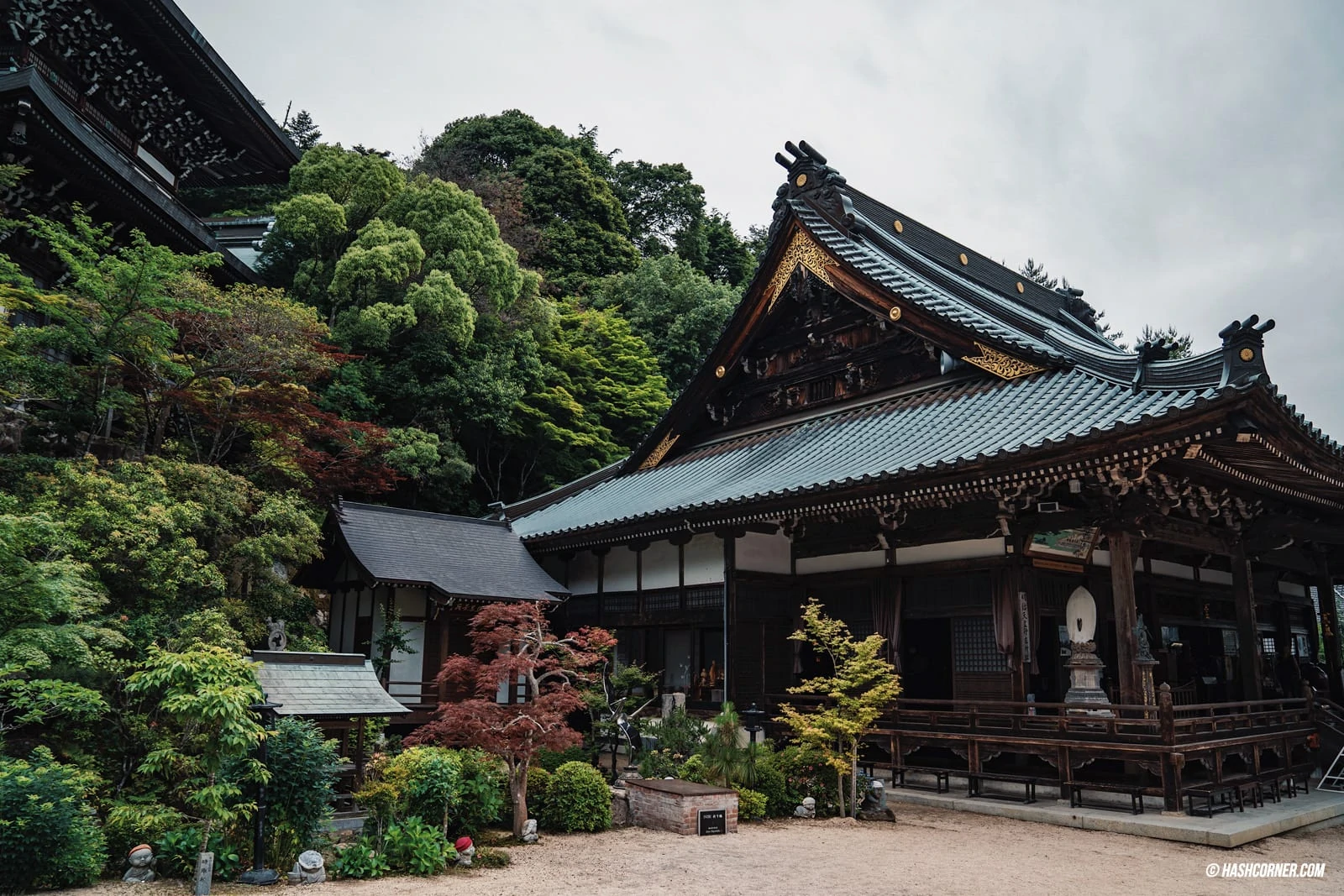
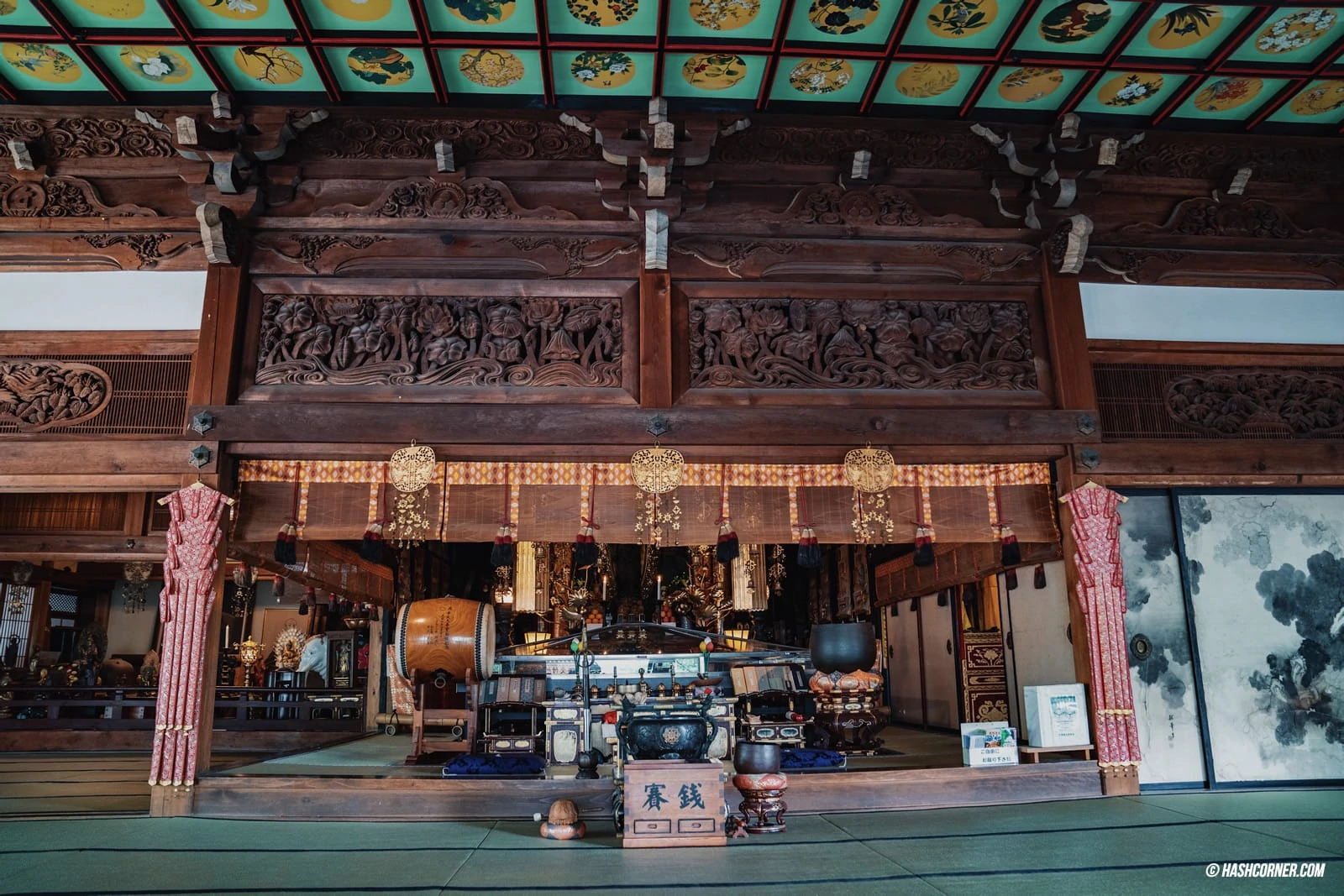
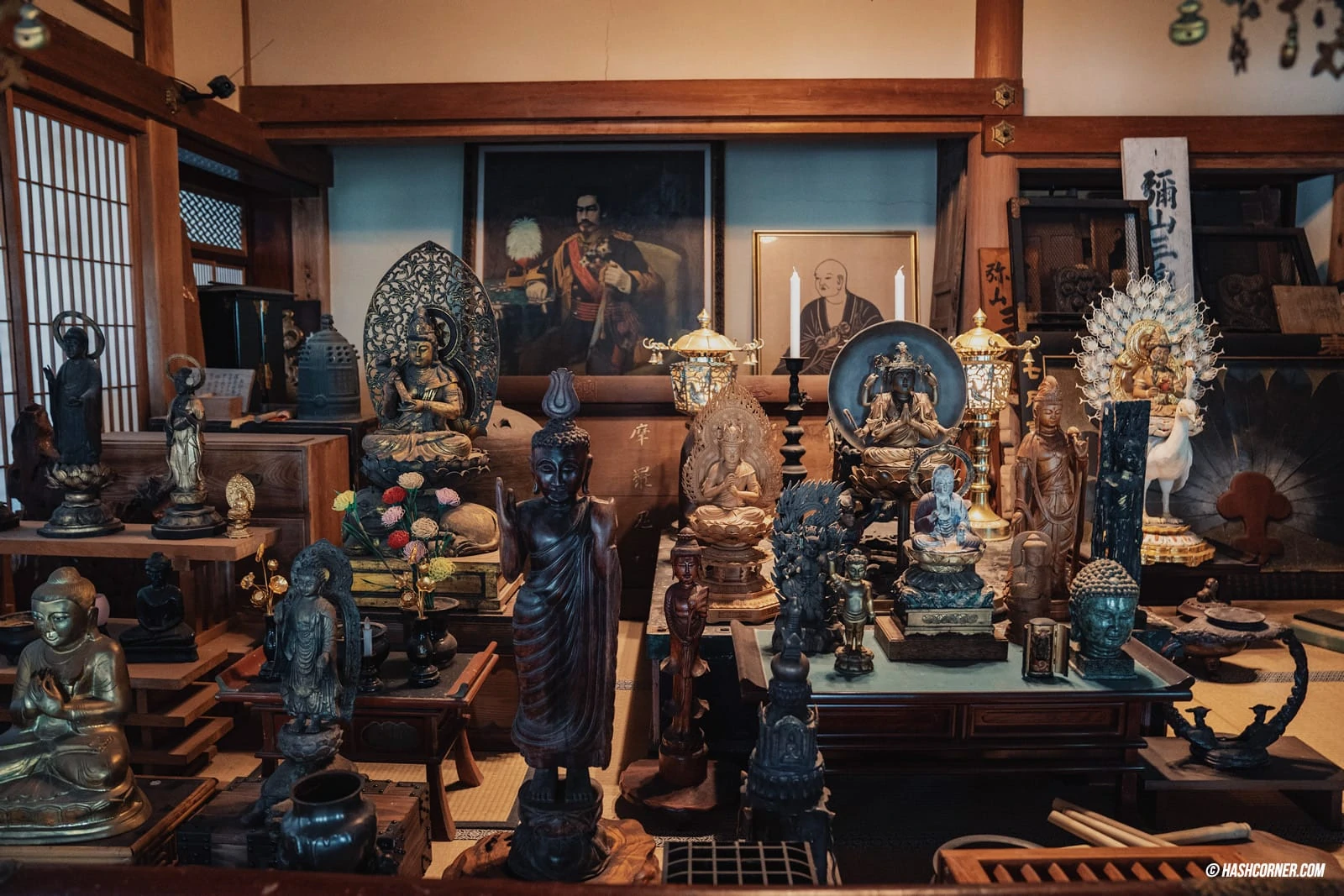
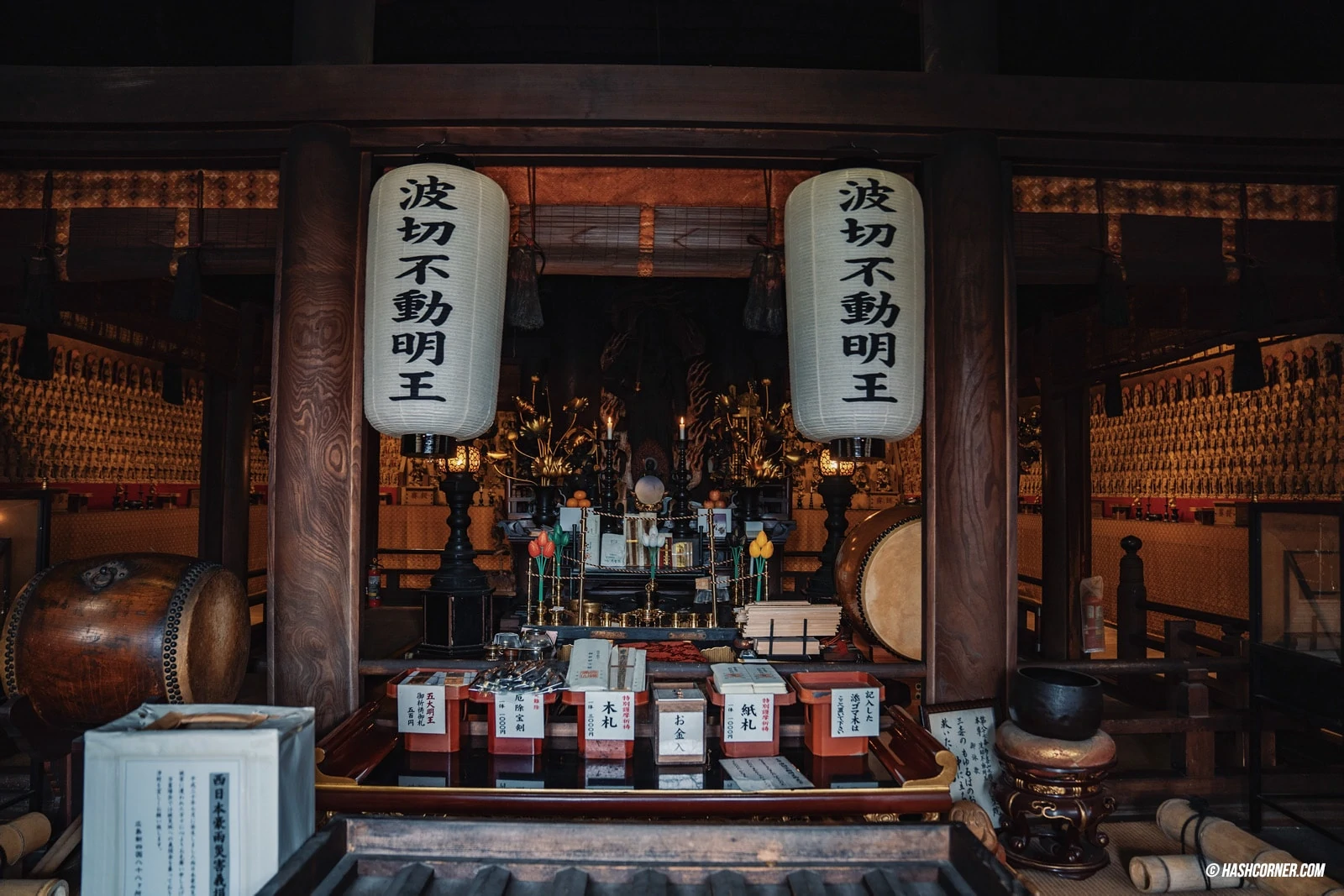
Daisho-in Temple features several buildings for visitors to explore, and the temple grounds are lush and tranquil. If you happen to visit during autumn, you’re in for a real treat – the fall colors here are breathtaking! Additionally, the temple’s charm is enhanced by a unique feature: a stairway lined with hundreds of small Jizo (Buddhist statue) figures, each wearing a knit cap, creating an adorable sight.
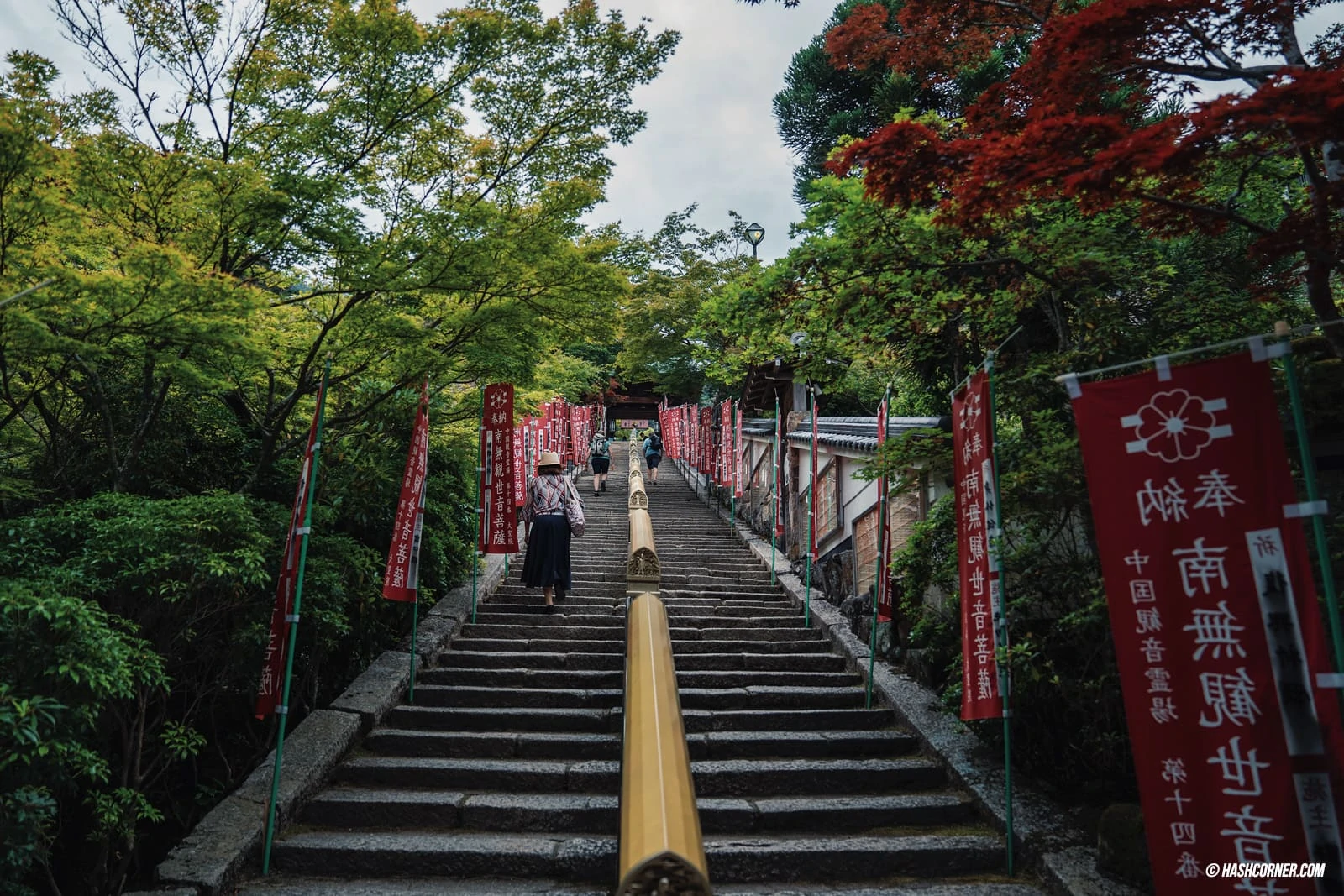
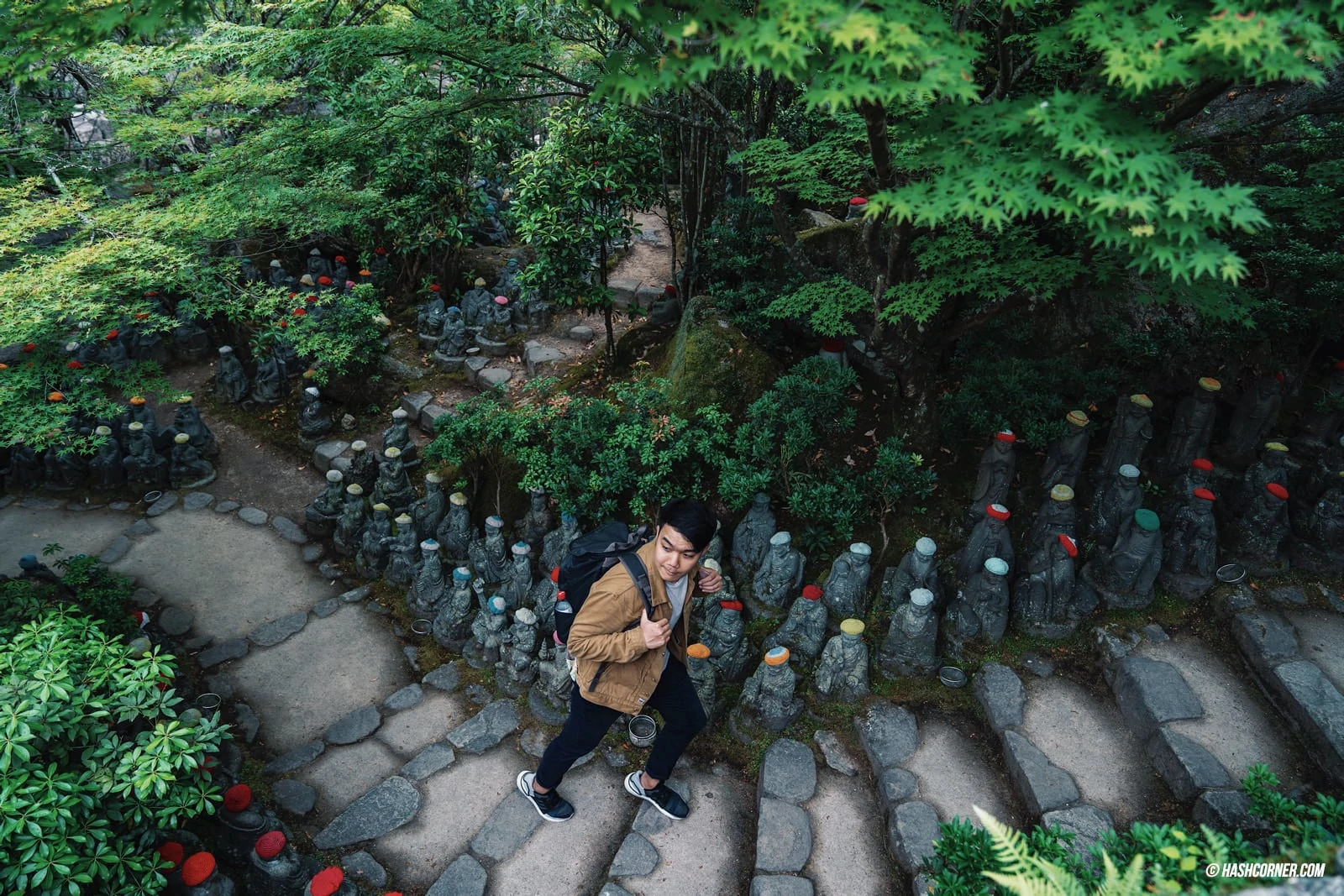
After spending some time in the temple, I decided to take the cable car to Mount Misen. However, if you’re up for a hike, you can walk up the mountain directly from Daisho-in Temple. The hike takes approximately 1.5 to 2 hours.
Momijidani Park
Upon leaving Daisho-in Temple, I took a leisurely walk through Momijidani Park towards the Miyajima Ropeway, leading to Mount Misen. You might think at first glance that this park is pretty ordinary. Still, if you come during the fall (mid to late November), you’d see that Momijidani Park turns into one of the most beautiful spots to enjoy autumn leaves on the island, with nearly all trees displaying vibrant orange-red leaves.
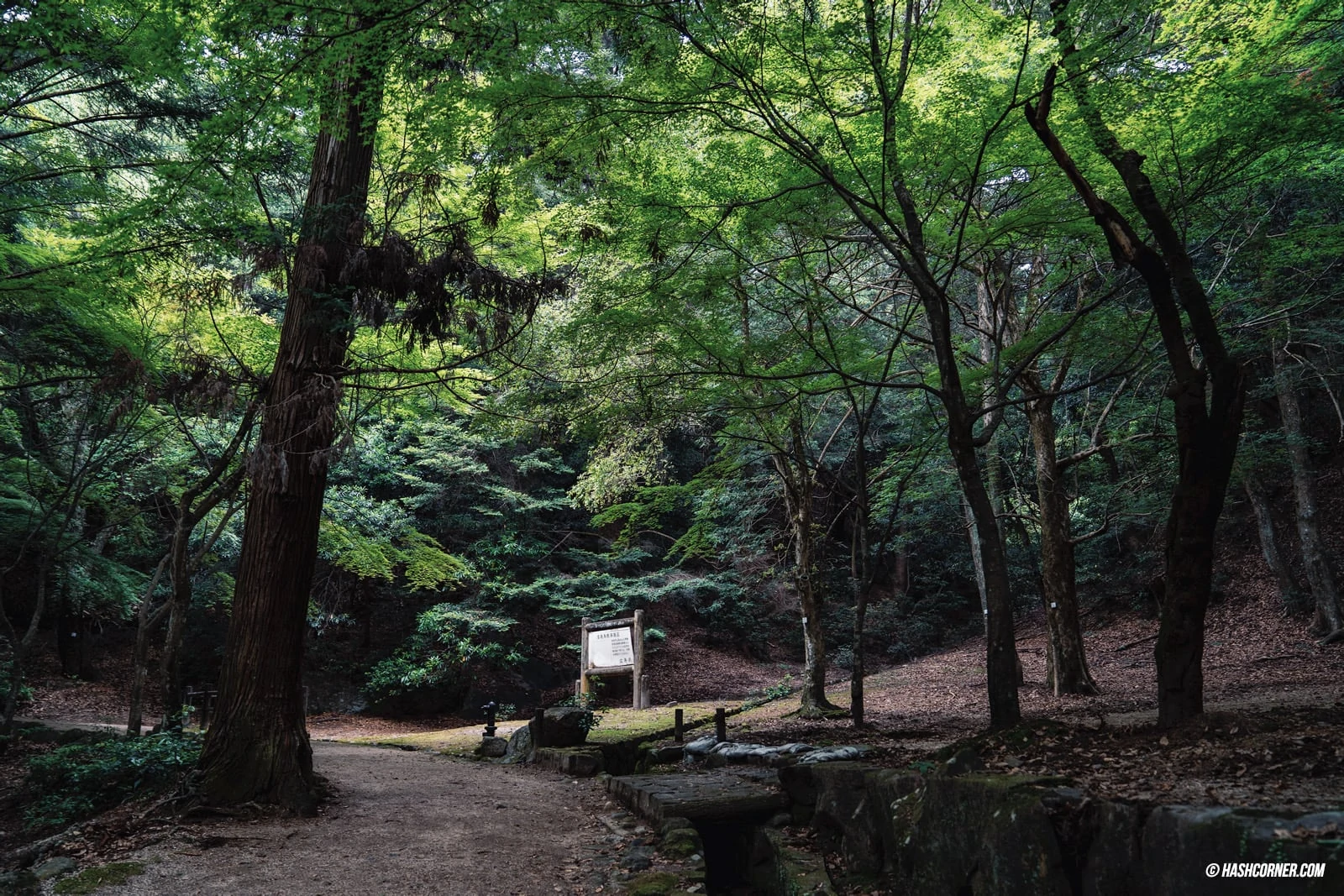
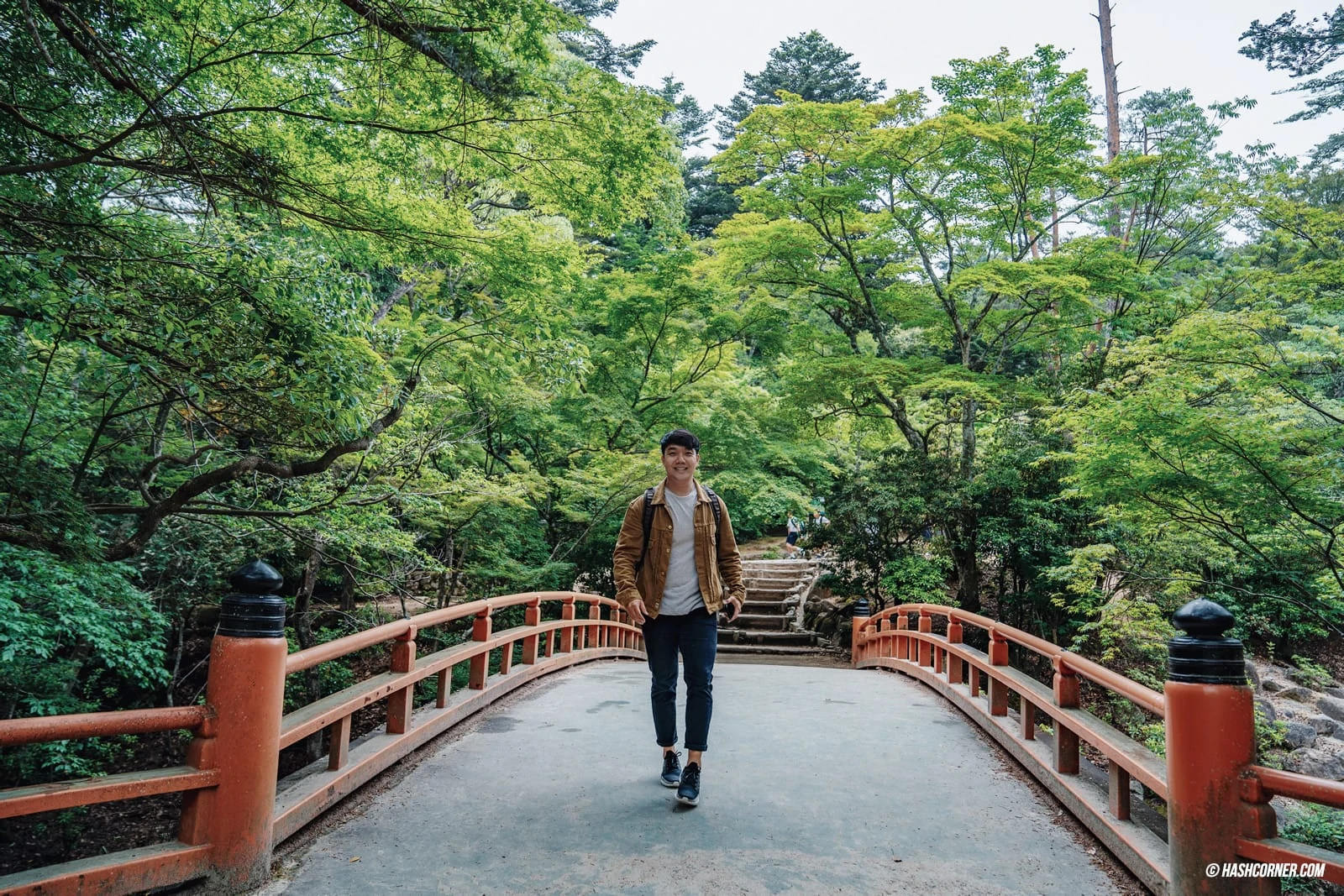
Even though I didn’t visit during the fall, the leisurely stroll through the park, with its trees, flowers, traditional Japanese red bridges, and occasional deer was quite refreshing! I highly recommend making a stop here, especially if you’re planning on going to Mount Misen and enjoying leisurely walks, as you’ll end up passing through this park anyway. Haha!
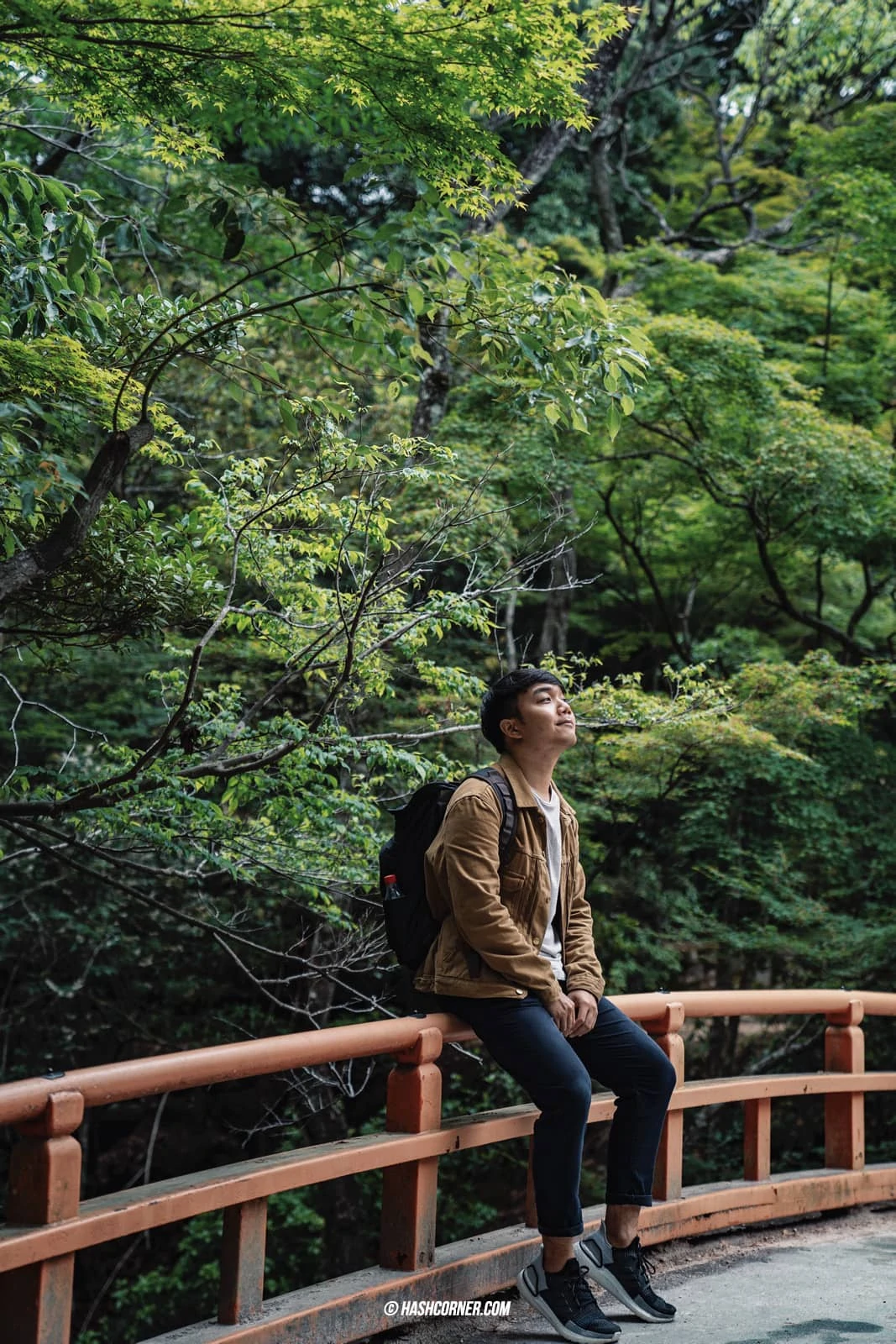
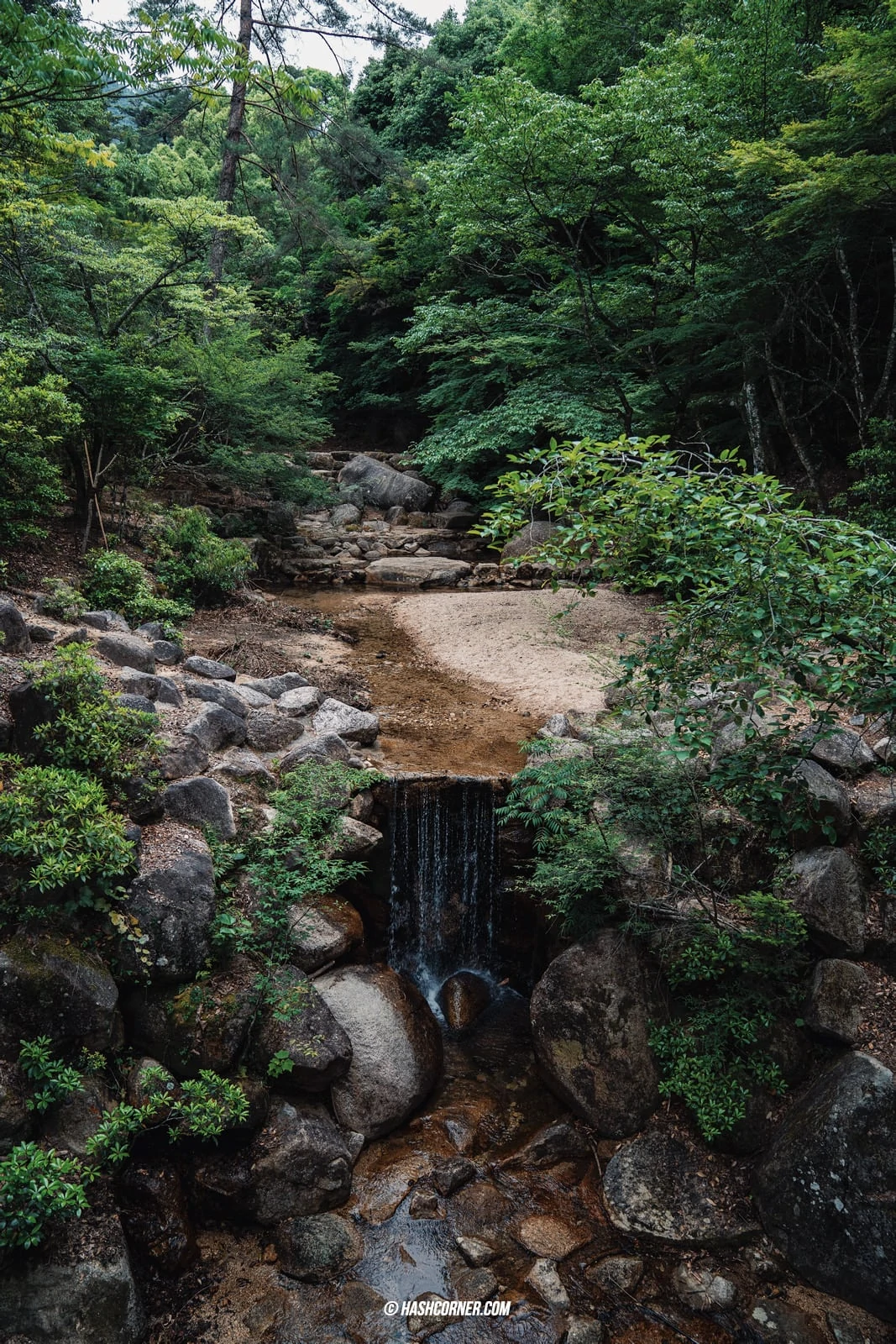
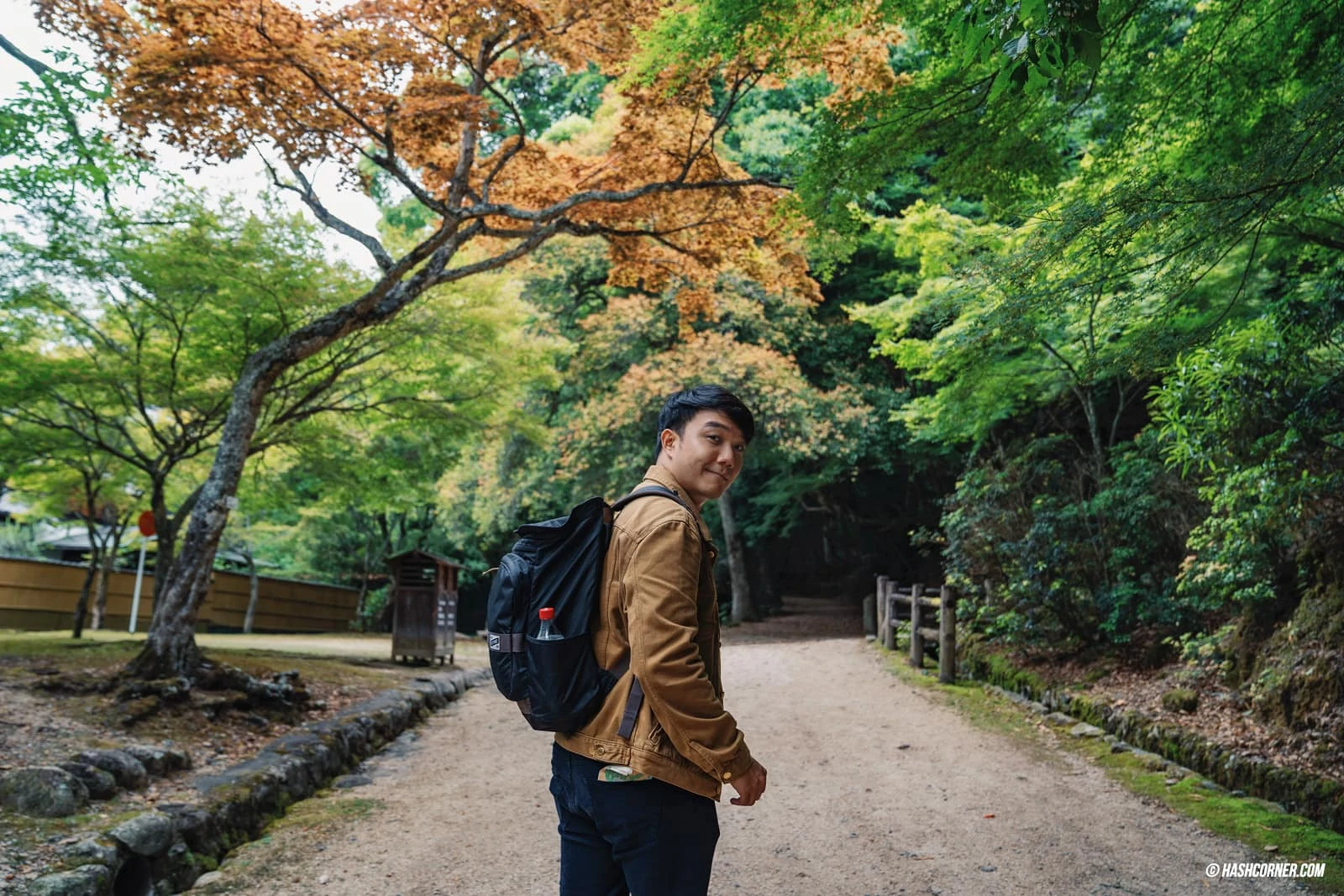
Mount Misen
Mount Misen, the highest peak on the island of Miyajima, stands 535 meters above sea level. Whether you’re an avid hiker or a trail walker, you can choose to climb Mount Misen to its summit. But for those who prefer a more leisurely pace, you can reach the summit with a ropeway ride and a short walk.
Locals revere Mount Misen as a sacred mountain, thanks to the renowned Kobo Daishi Kukai, founder of the Shingon sect of Buddhism in Japan. He practiced and established several temples on this mountain. So, while enjoying the stunning island views from above, many visitors also come to follow in the footsteps of a religious pilgrimage.
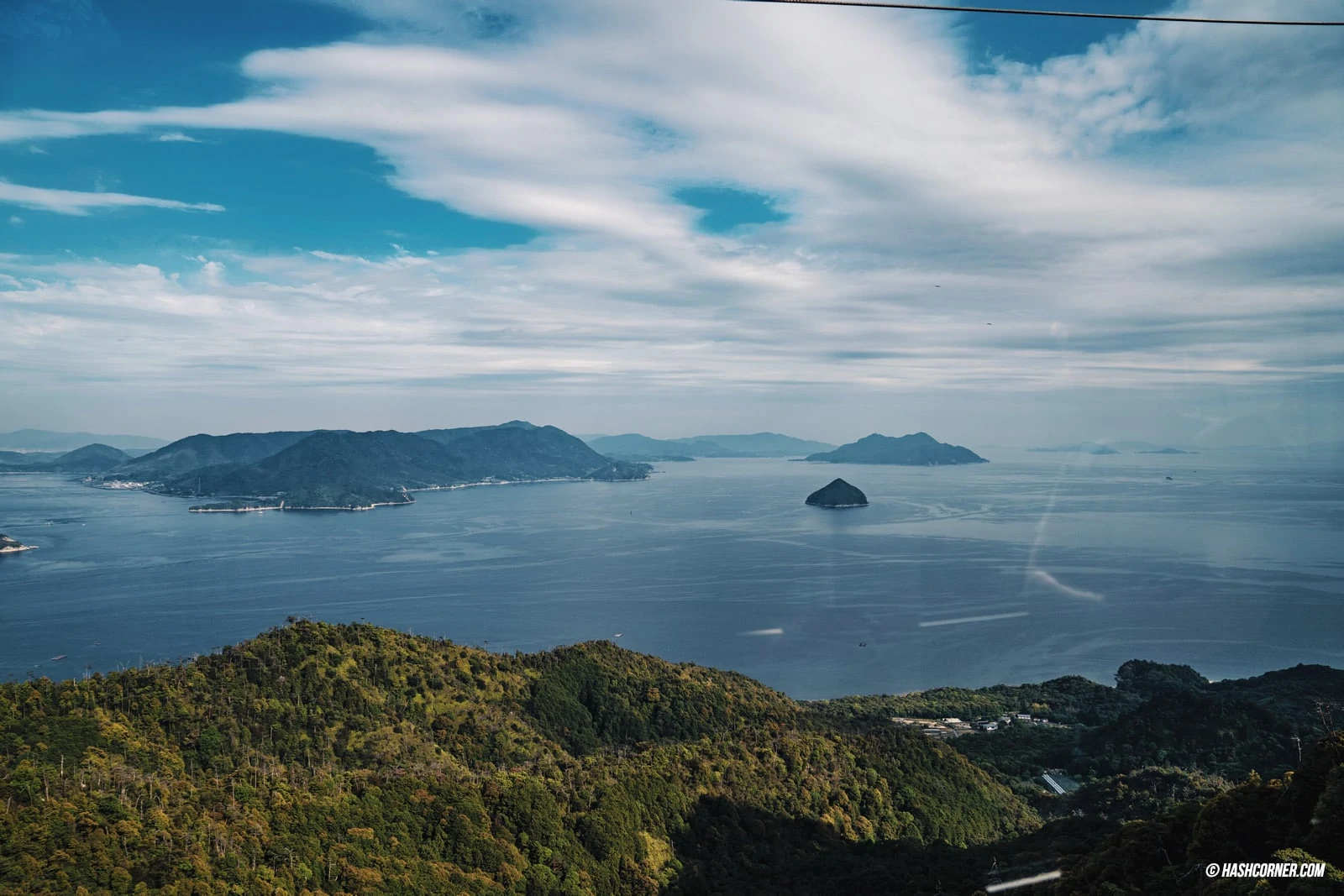
🚠 Miyajima Ropeway
If climbing isn’t your thing, or you’re traveling with elders, I recommend the ropeway service. It’s far more comfortable. A round trip ticket will cost 1,840 yen while a single trip is 1,010 yen. It operates from 9:00 am to 5:00 pm.
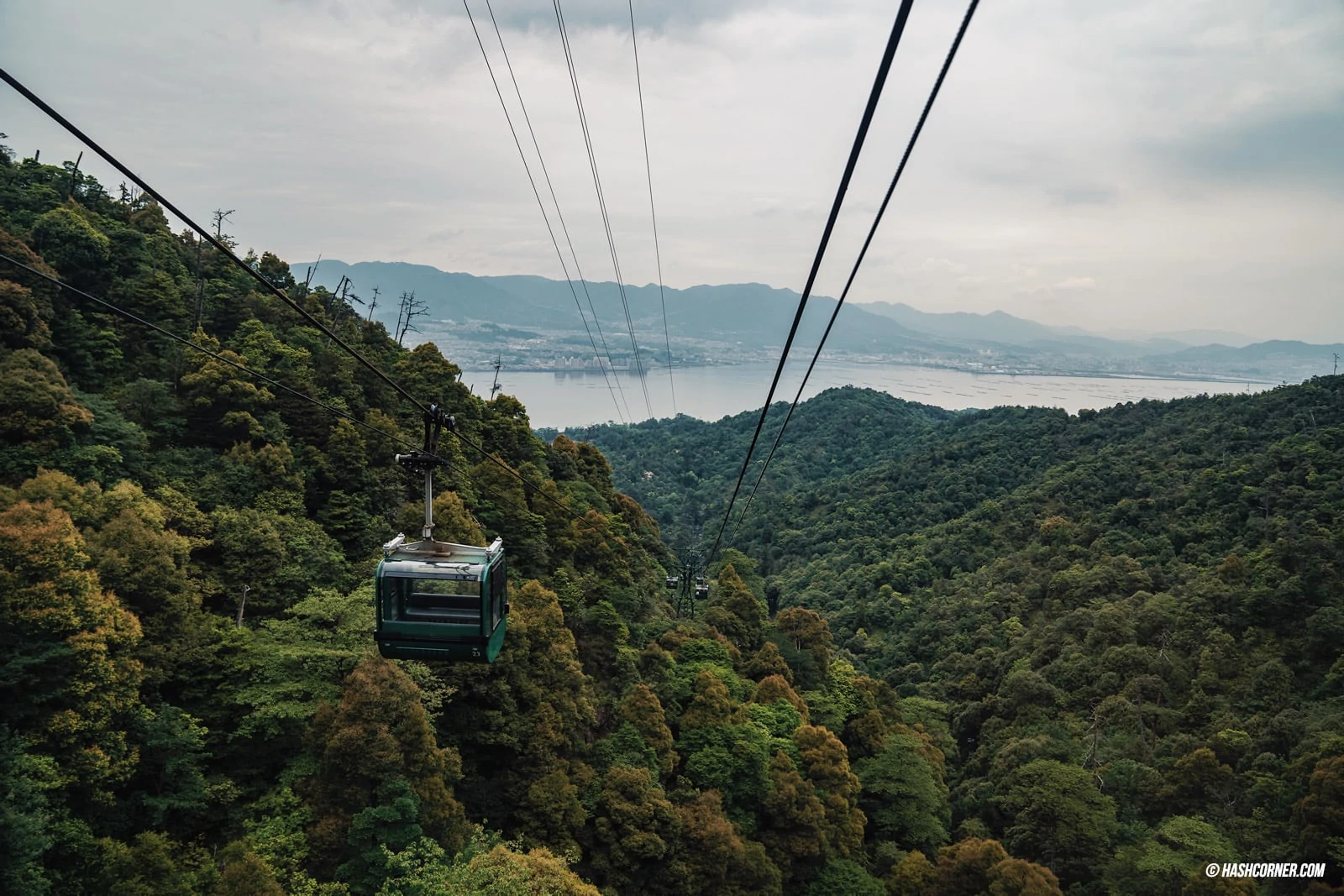
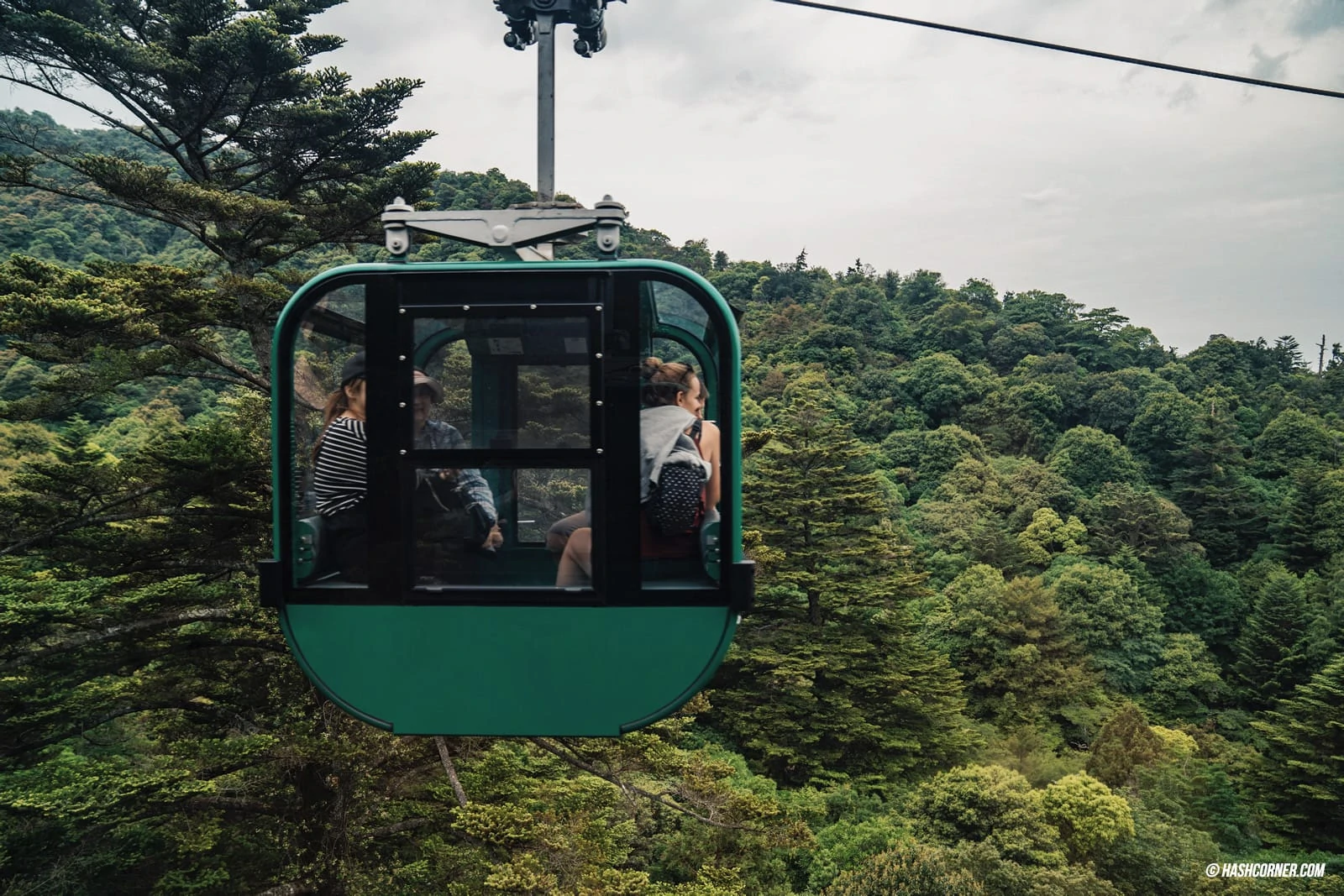
Once you reach the end of the ropeway station, don’t think you’re there just yet. You’ll need to walk for about another 20 minutes. The path is well-maintained and easy to follow. Halfway up, you can take a break at the Reikado pavilion. This hall holds a sacred flame said to have been lit by Kobo Daishi over 1,200 years ago, and it has never gone out since. The flame here was even used to light the peace flame at Hiroshima Peace Memorial Park in Hiroshima city.
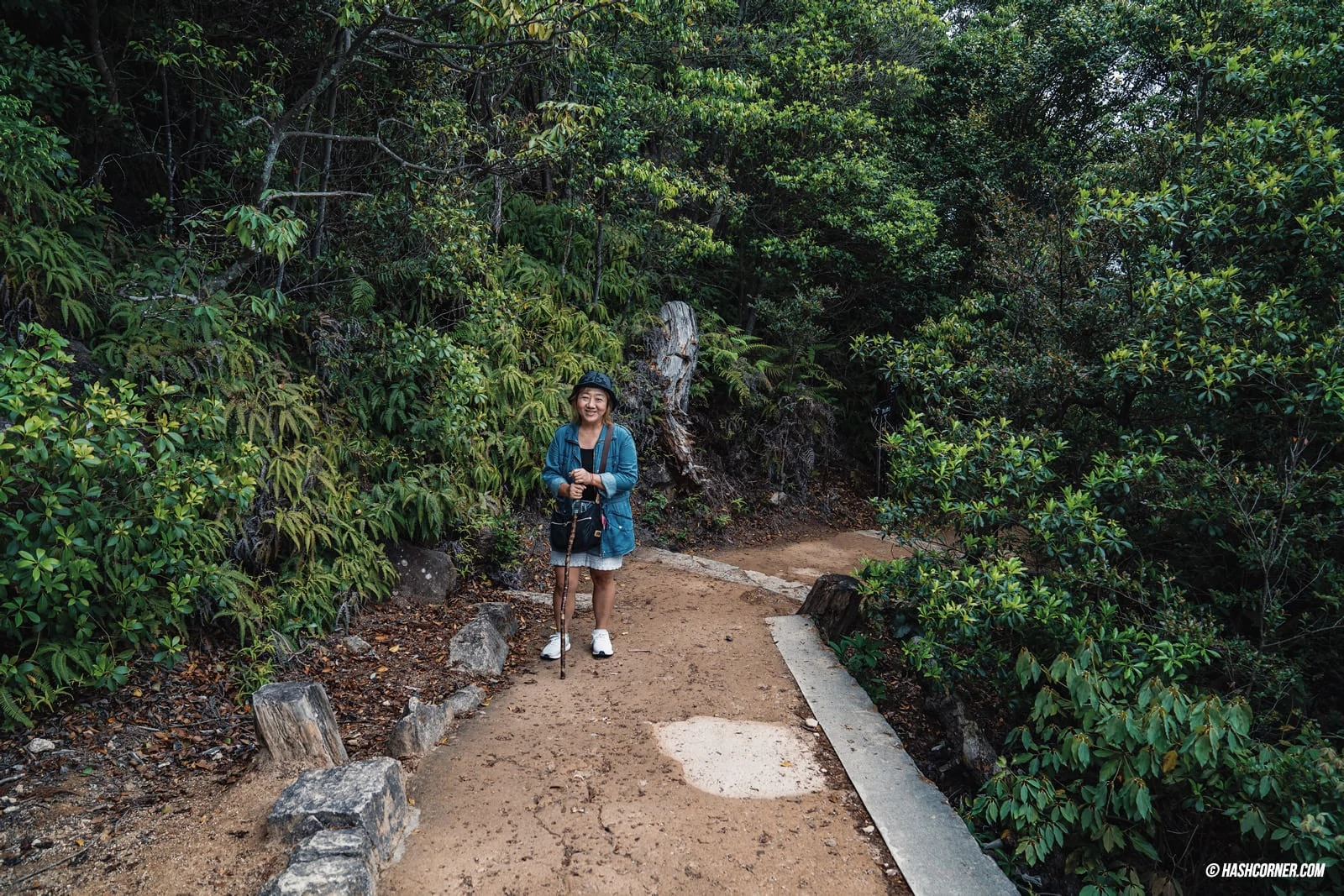
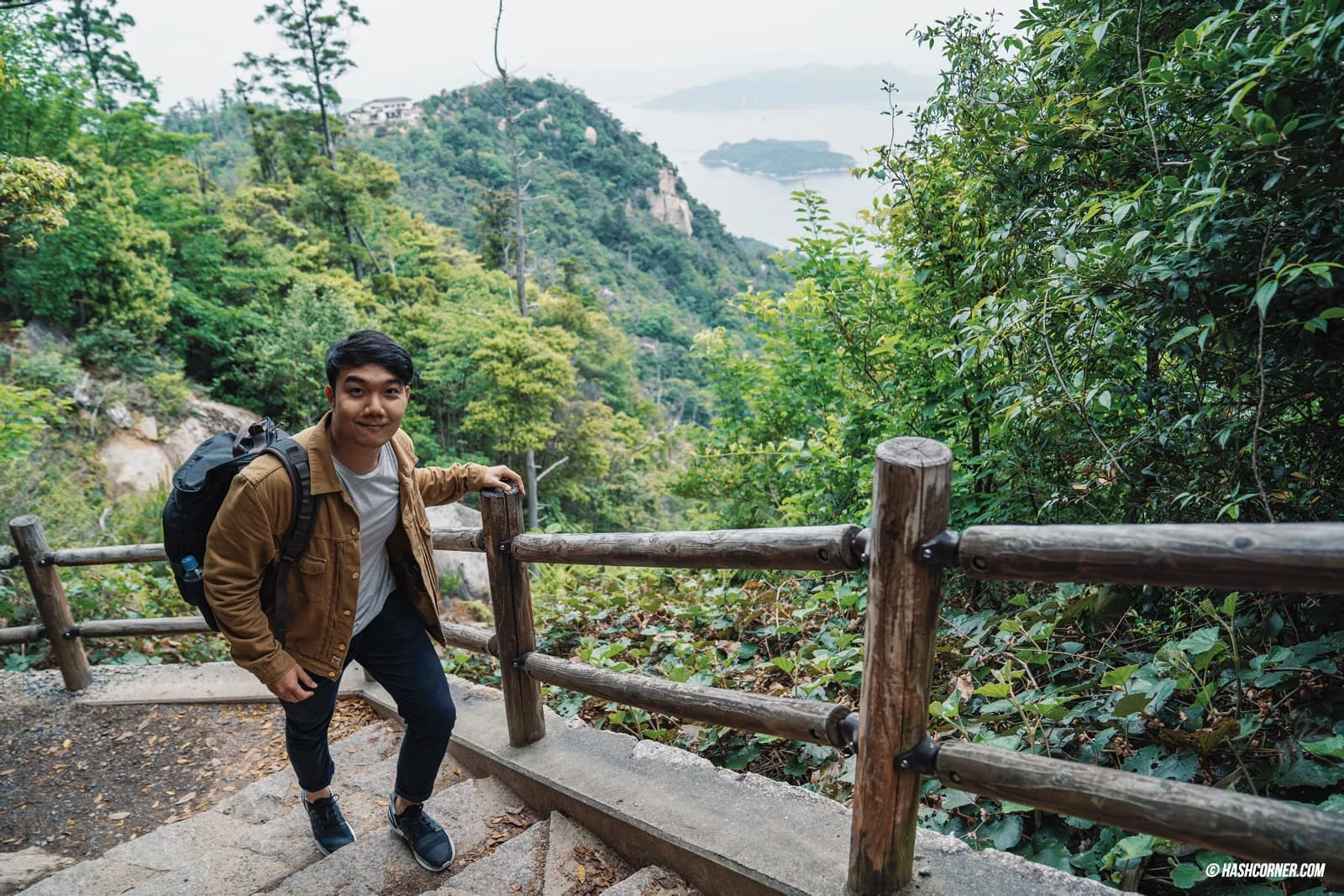
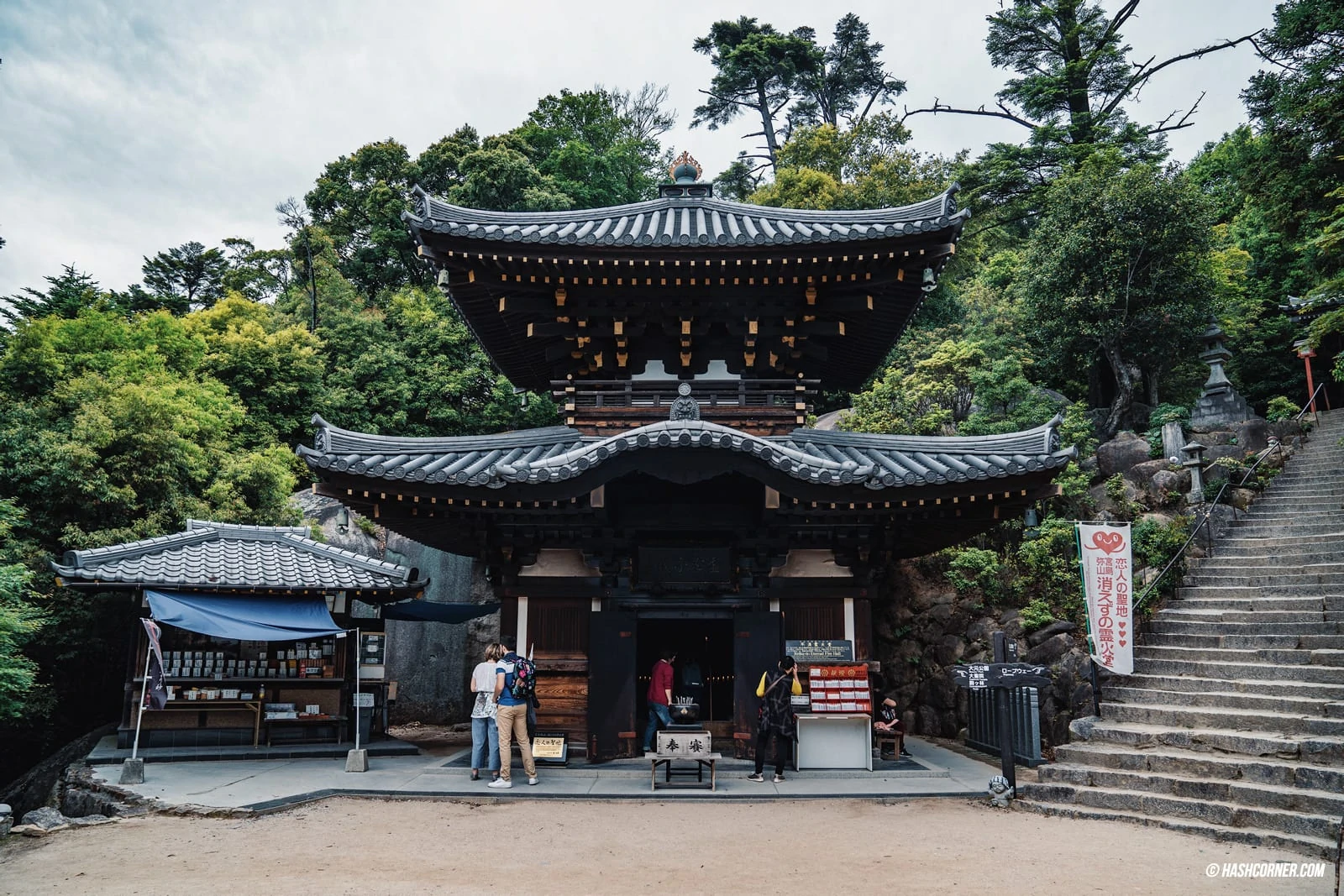
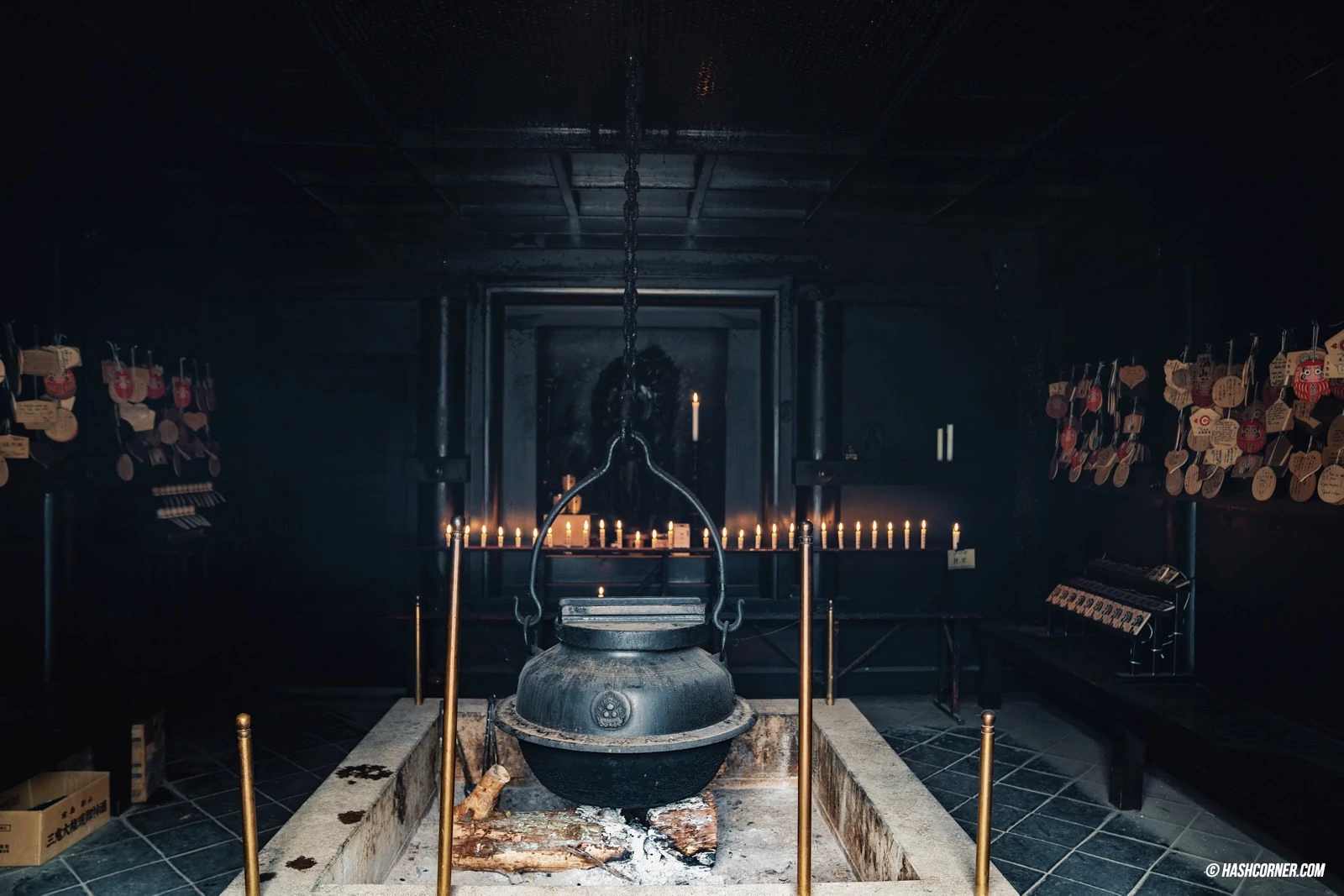
After recharging at Reikado, continue upwards for about 10 minutes and you’ll reach the summit of Mount Misen. Interestingly, it’s a rocky plateau. There’s a viewpoint that allows you a full 360-degree panorama. The view is absolutely breathtaking, showcasing the tiny and large islands scattered in the Seto Inland Sea. On a clear day, you can even see Hiroshima city!
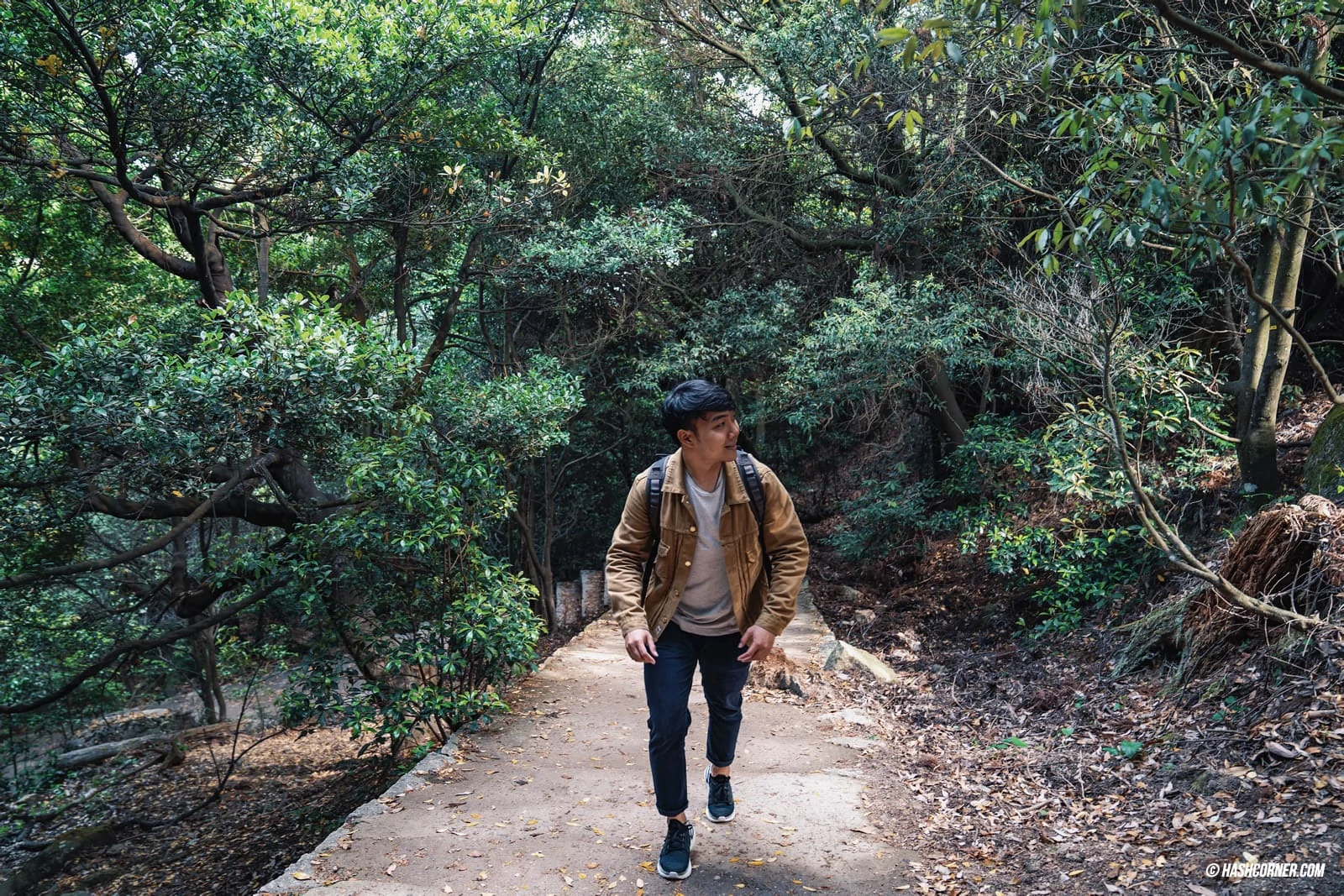
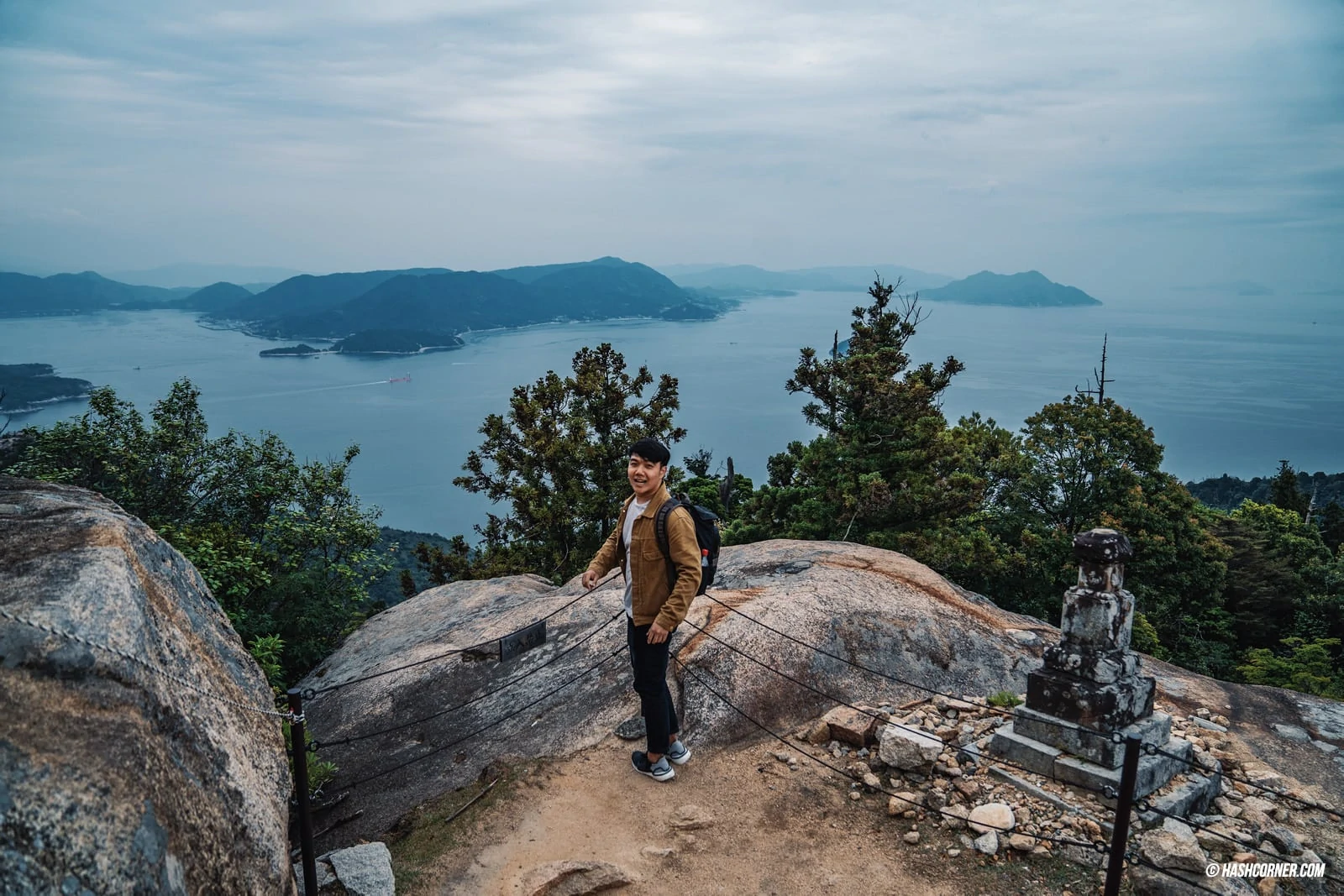

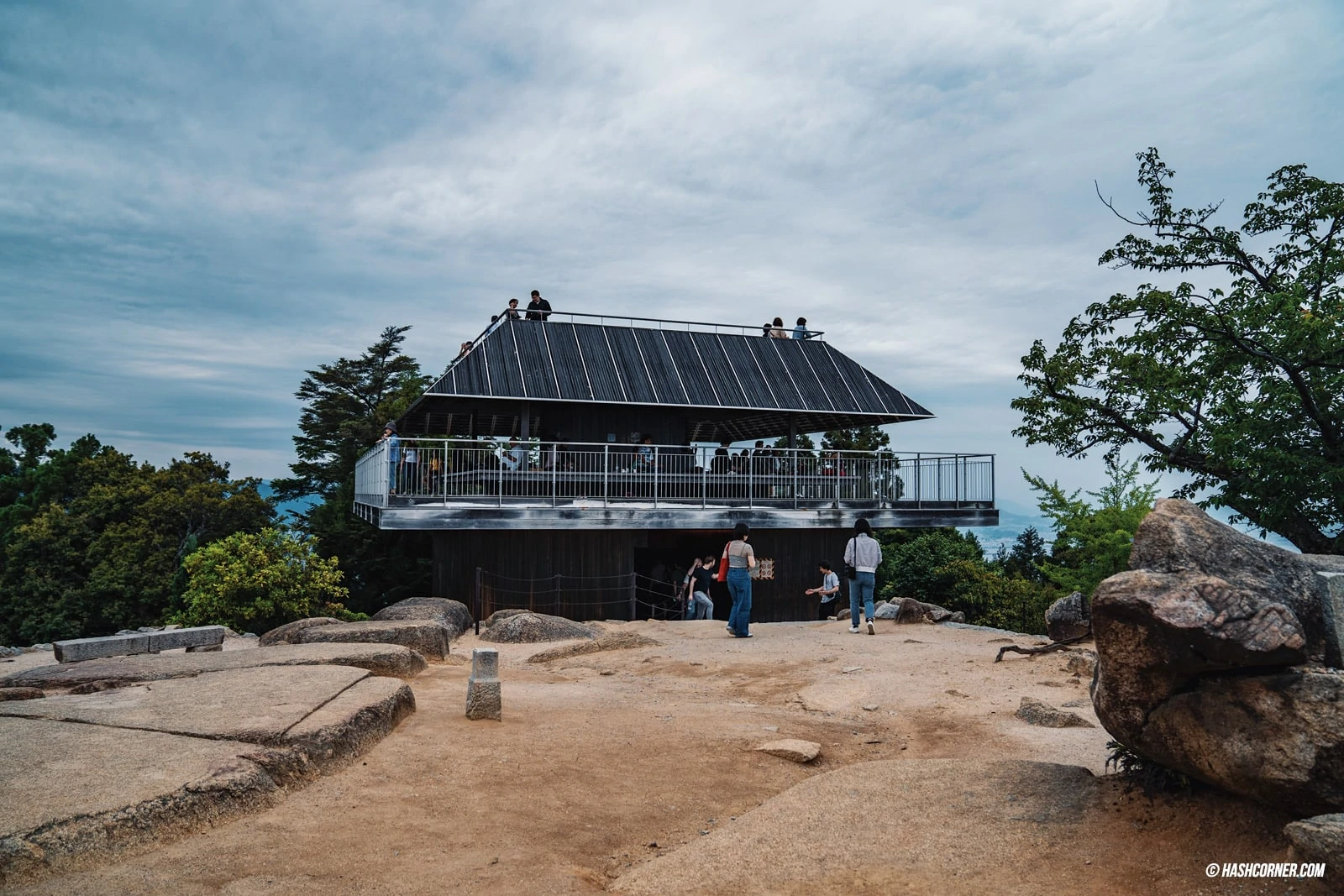
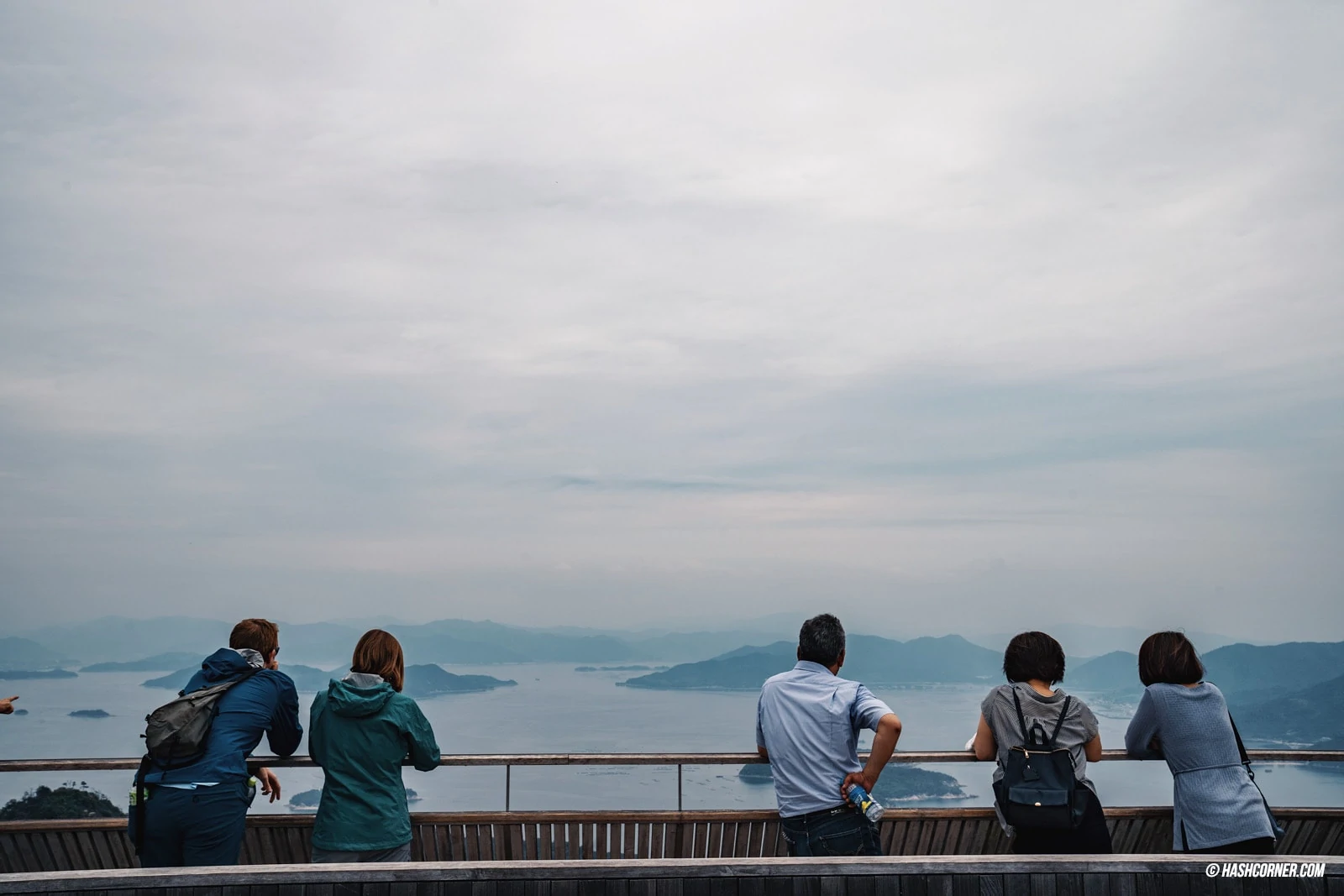
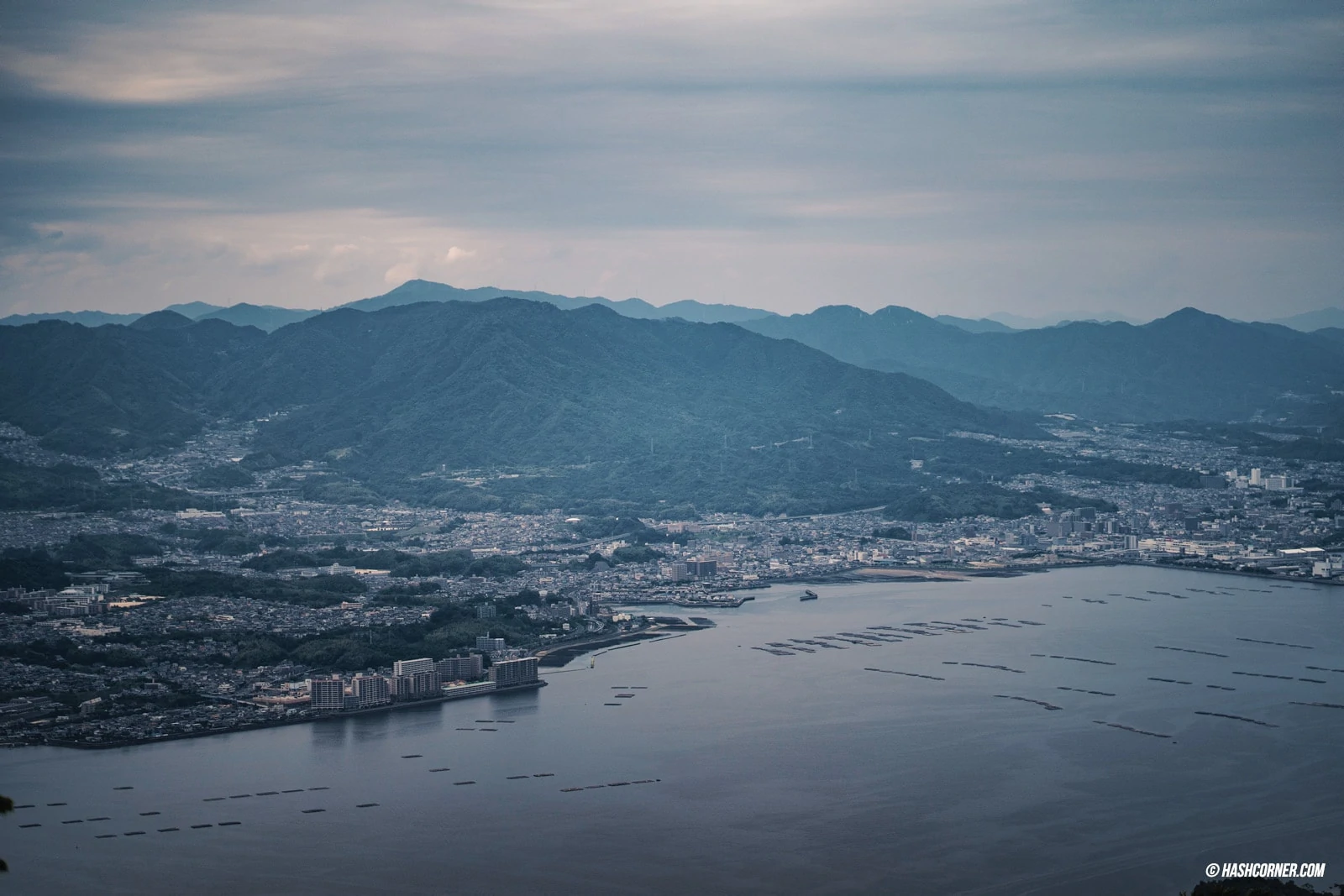
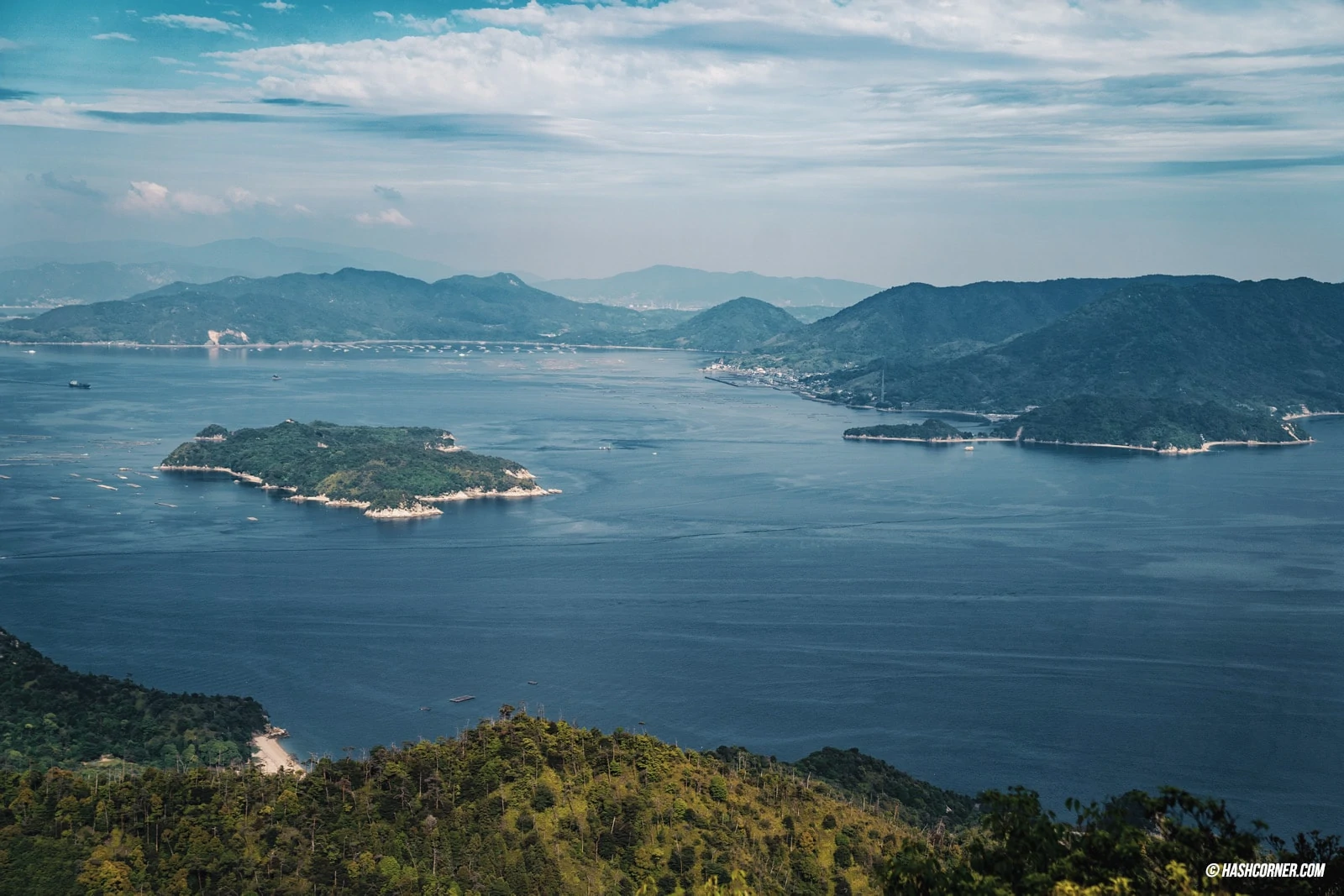
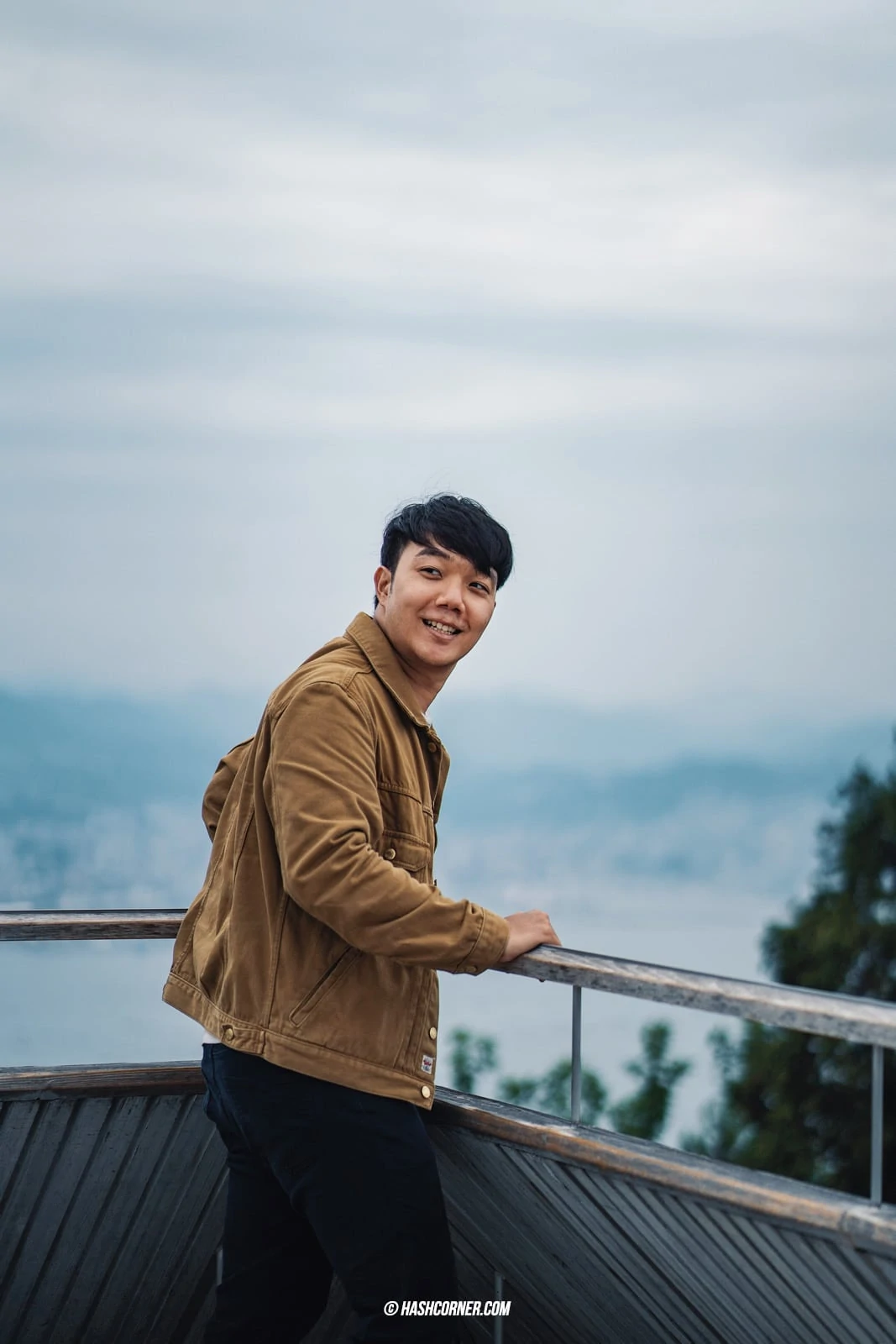

Senjokaku and Five-storied Pagoda
After descending from Mount Misen and walking a little, I realized that there was a shuttle bus service from the Itsukushima Shrine area. When I saw the sign, I promptly hopped on the bus because I was starting to feel tired! Haha. For those who are reluctant to walk from the shrine to the cable car station, you can board the bus right here > goo.gl/maps/VLN4vVN8Vij17nst6
With some time left to explore, I decided to pop in and take a stroll around Senjokaku (also known as Hokoku Shrine) and the Five-Storied Pagoda, which are located in the same area. Initially, these two places weren’t part of my plan, but seeing the Pagoda standing tall from a distance while strolling through the village, I decided to drop in, and I wasn’t disappointed – they were stunningly beautiful!
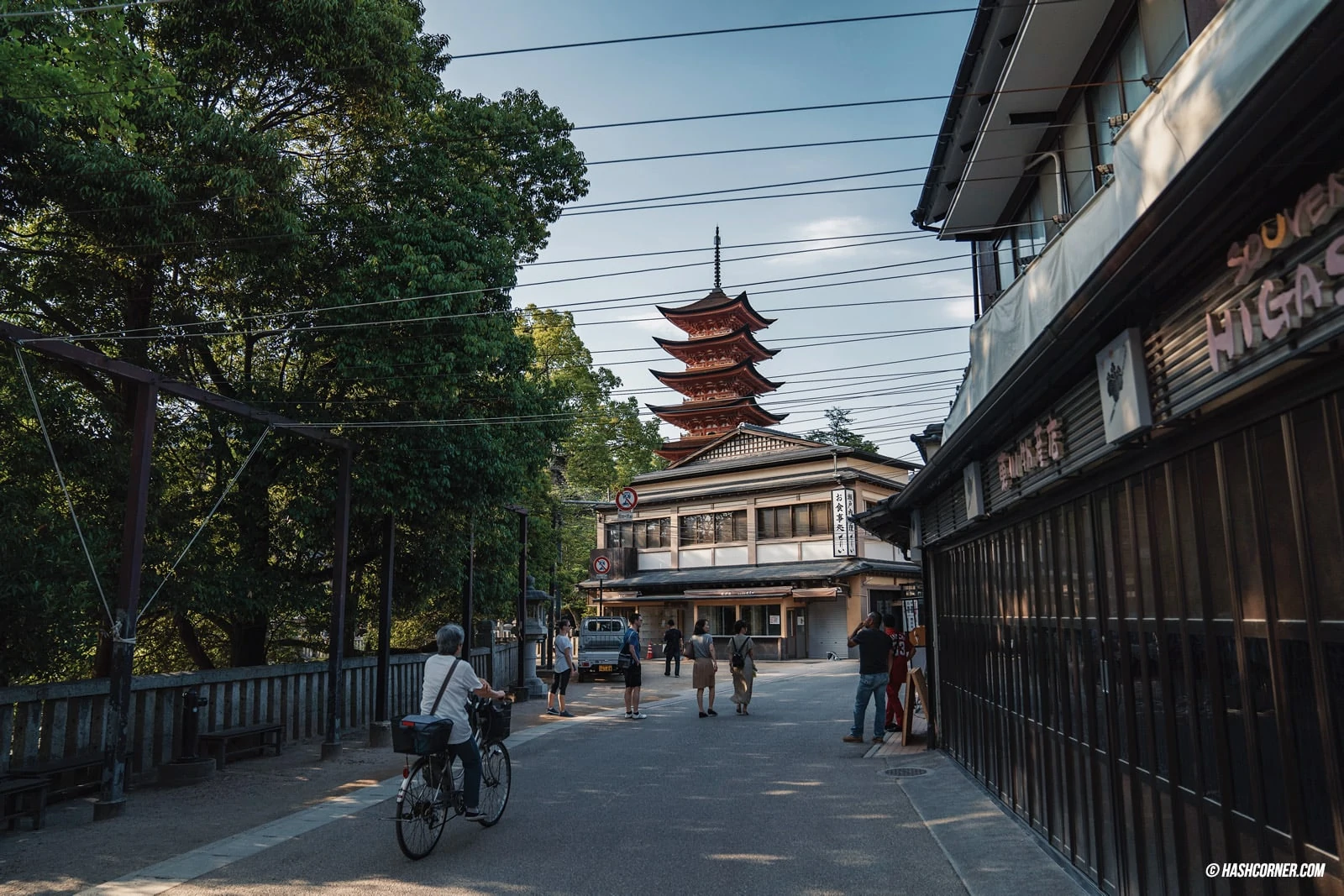

Senjokaku, or Hokoku Shrine, was built in 1587 by Toyotomi Hideyoshi, a significant daimyo in Japan (and also the builder of Osaka Castle). Initially, he built this place intending it to be a temple, but his death meant it was never finished, resulting in the building being open-sided as you see it today.
Another gorgeous site is the adjacent Five-Storied Pagoda, constructed in 1407, even before the Senjokaku was built. The architecture exhibits a blend of Chinese and Japanese styles, reflecting the period of cultural exchange and trade during China’s Ming Dynasty. The result is a striking feature on the island, beautifully maintained and appearing as pristine as when it was new.
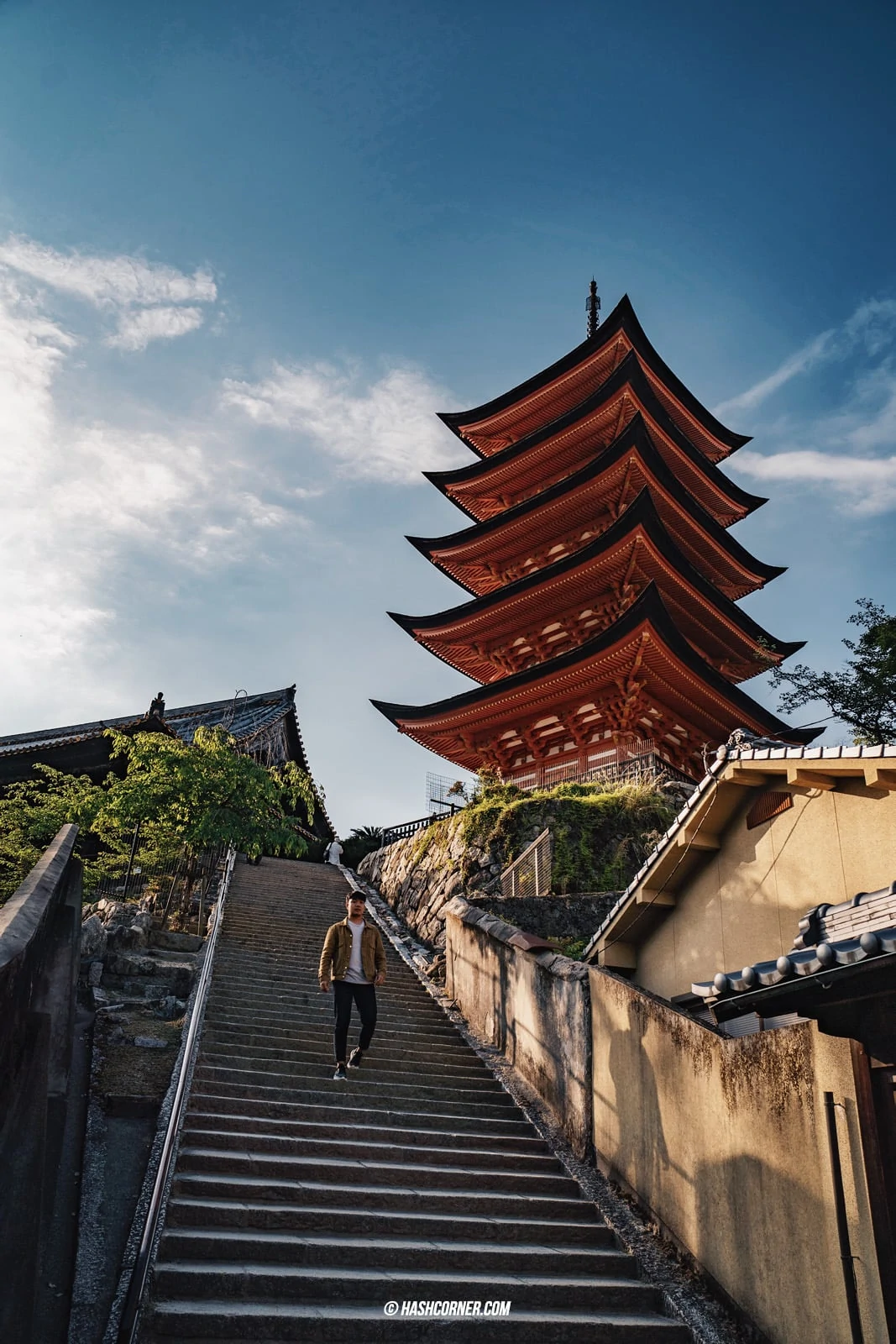
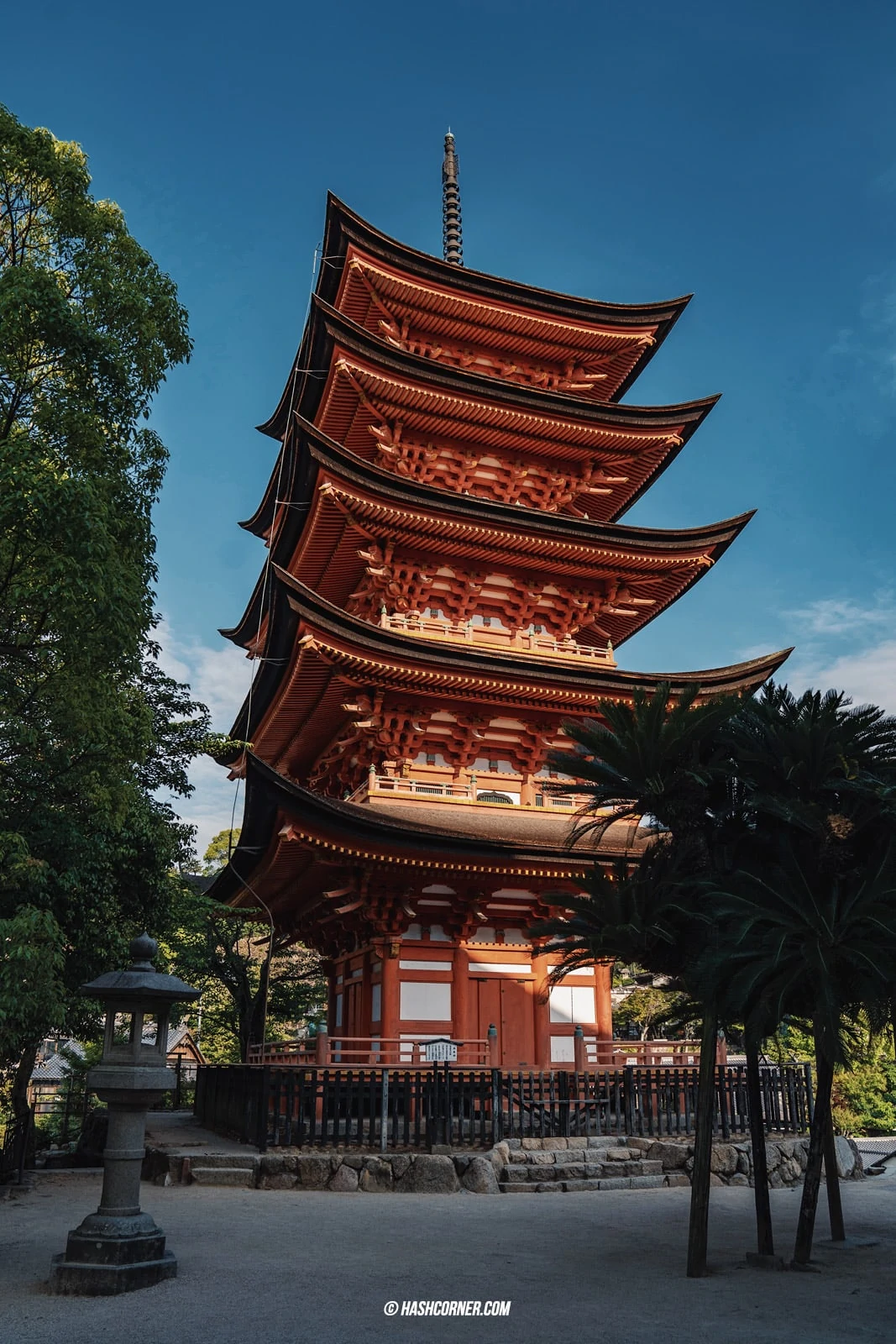
Watch the Sunset at O-Torii Gate
Before leaving Miyajima Island, I don’t want you to miss its most beautiful and splendid moment – the late afternoon leading up to sunset. The sight is breathtaking, especially since the setting sun is perfectly aligned with the O-Torii Gate. As evening approaches, the tide gradually rises, submerging the gate’s pillars, making it appear as if it’s floating. The scene unfolding in front of you is truly mesmerizing.
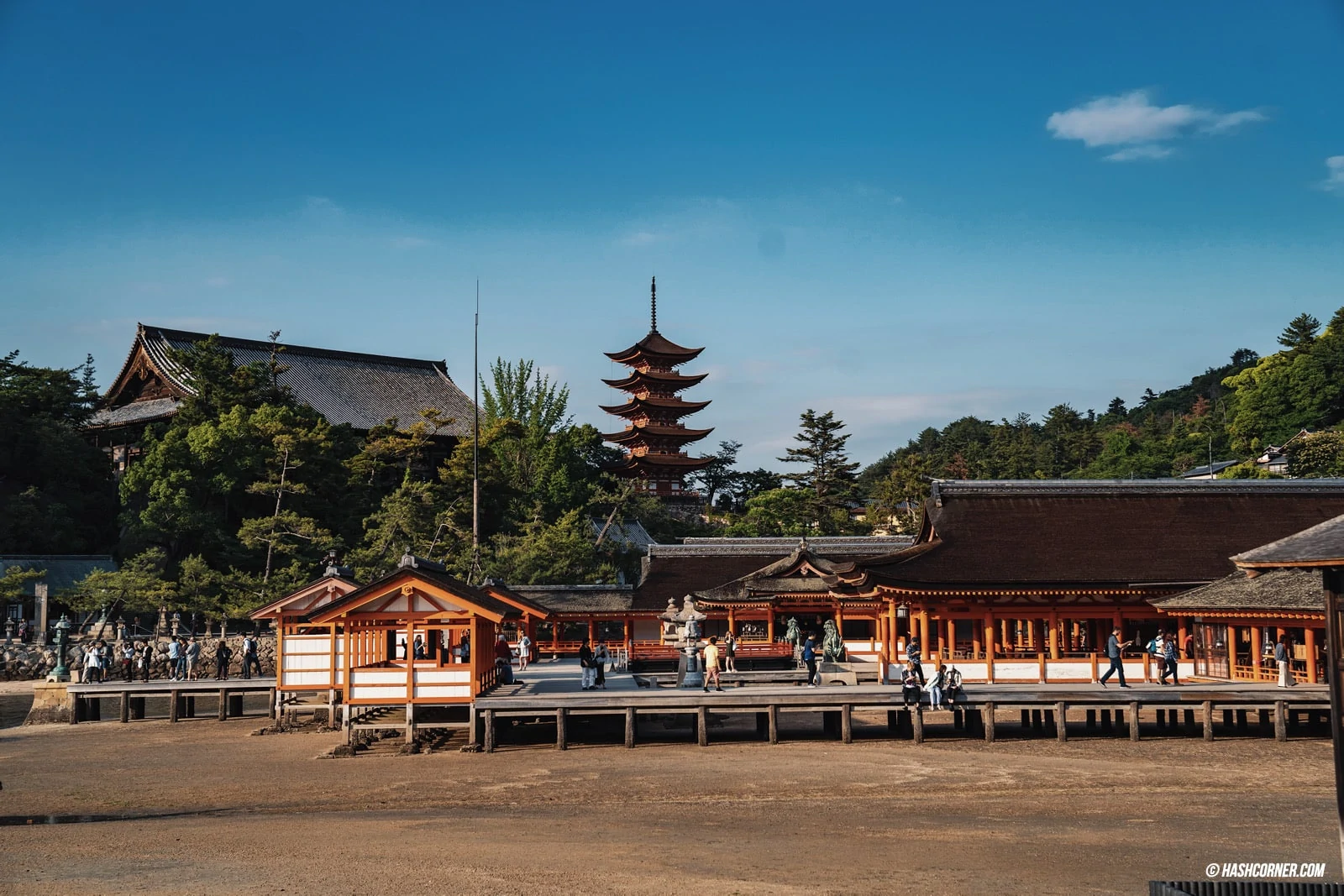
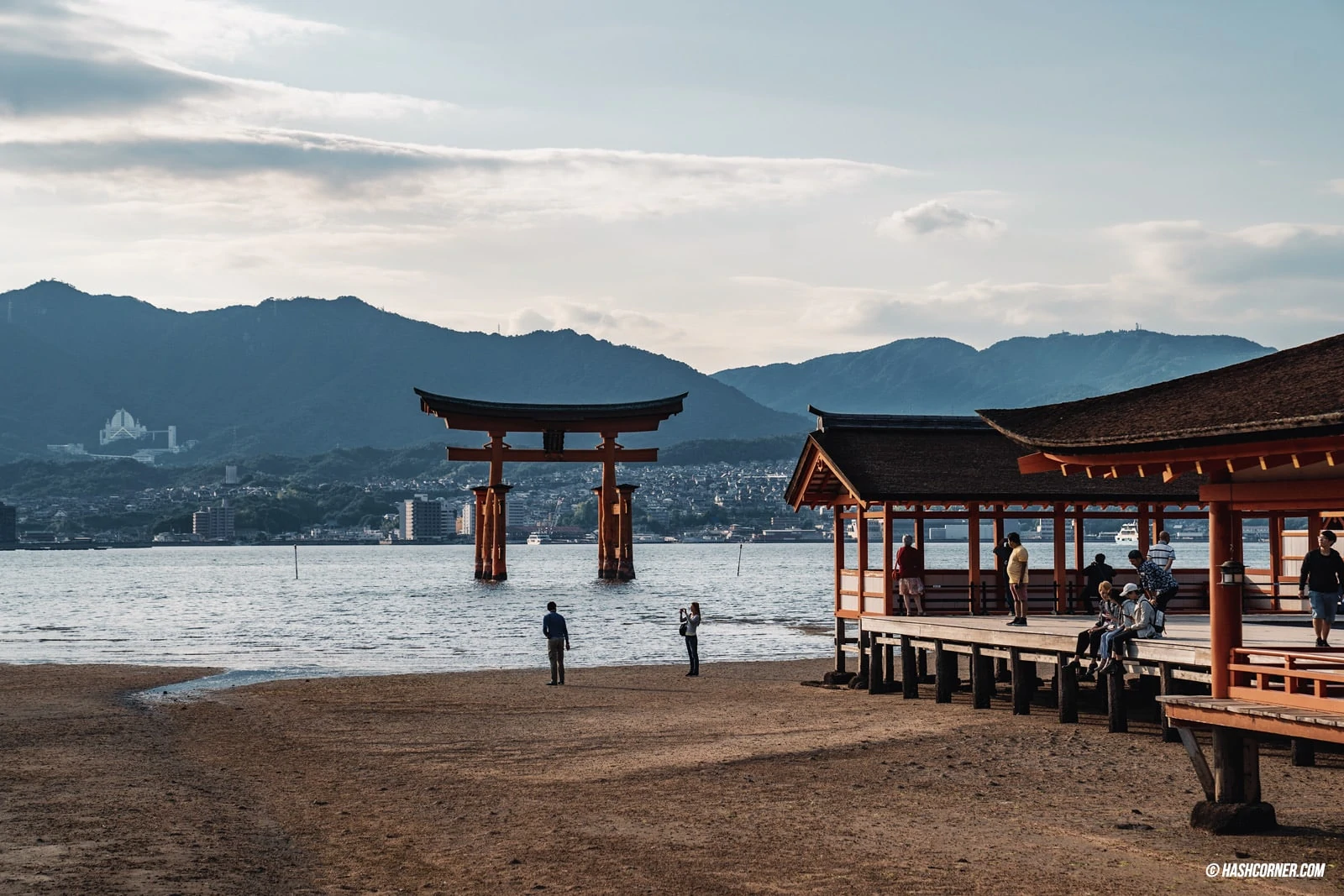
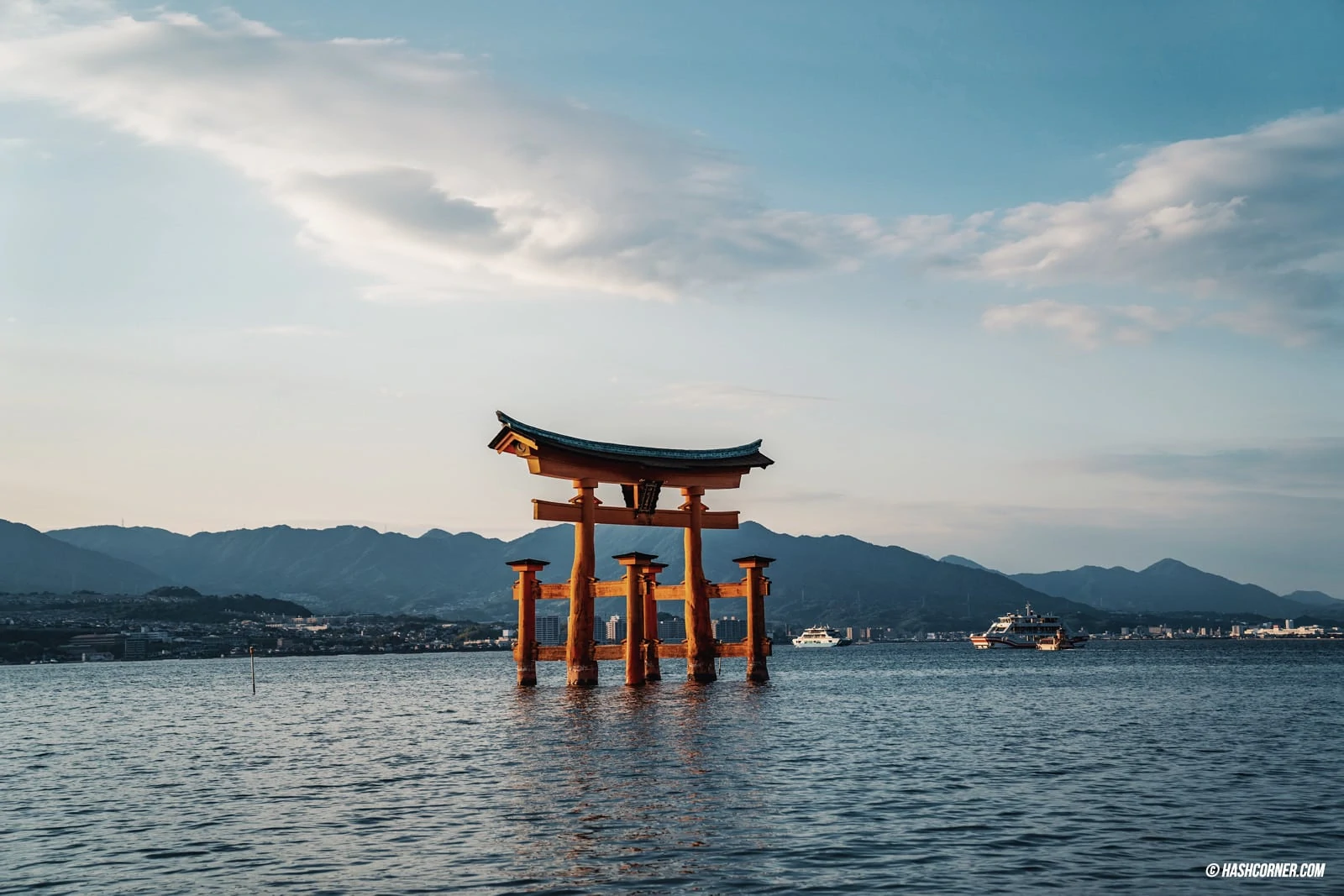
I recommend strolling wherever your heart desires. Whether you choose to explore the side areas or elsewhere is up to you. For me, sitting and relaxing on the small sandy beach to the left of the Itsukushima Shrine was simply amazing. Then, just as the sun is about to set, you can head over to the right side of the shrine once more.
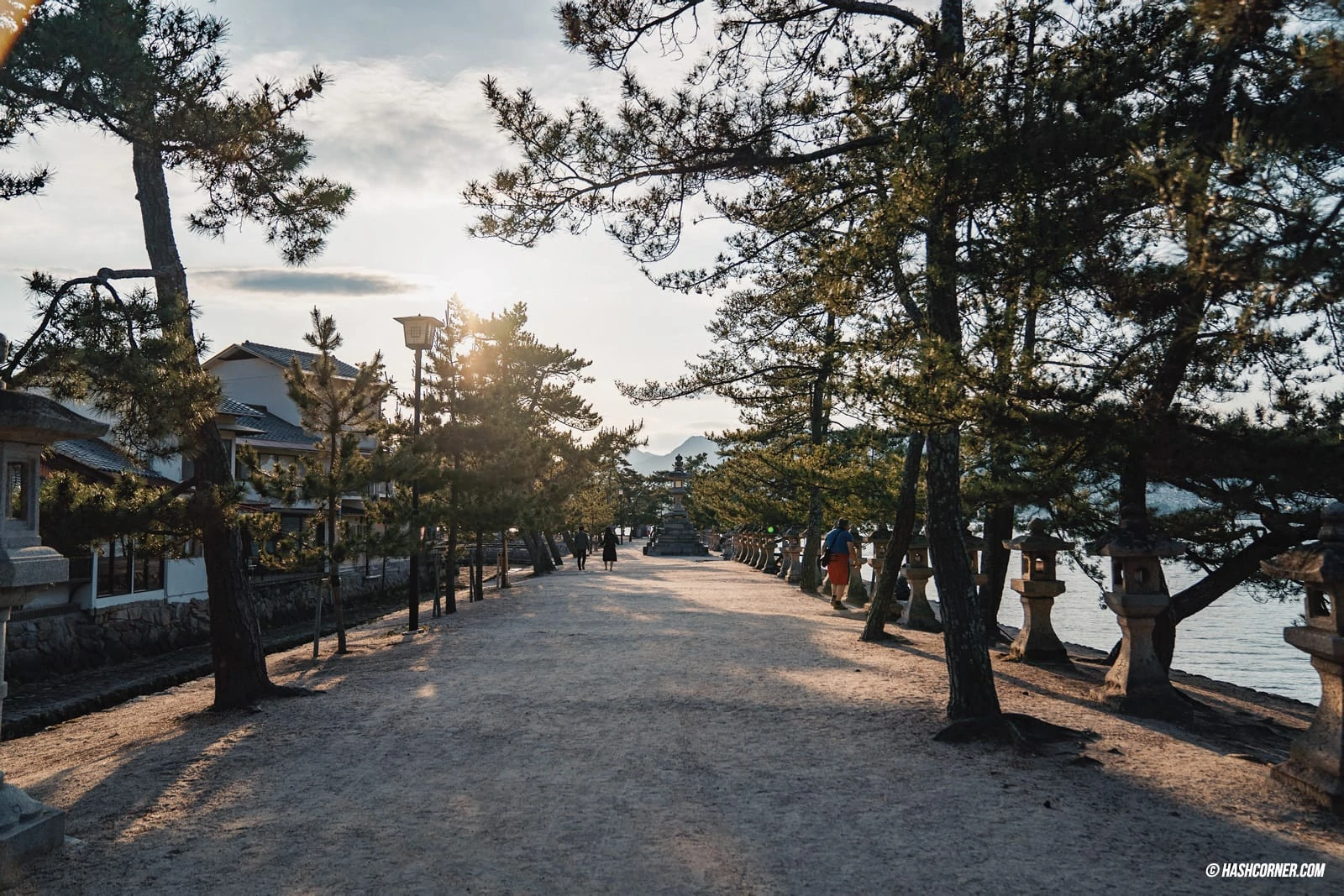

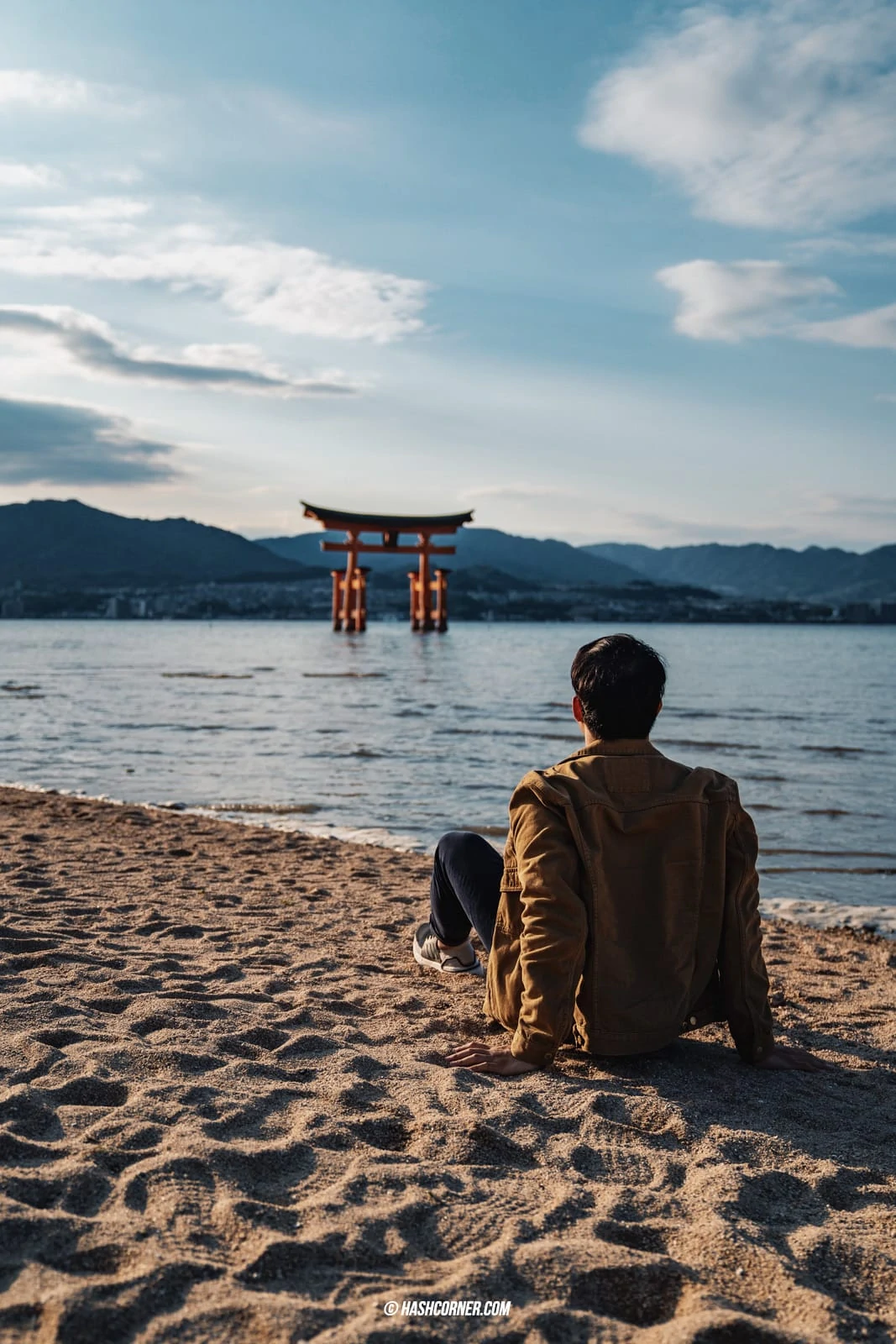
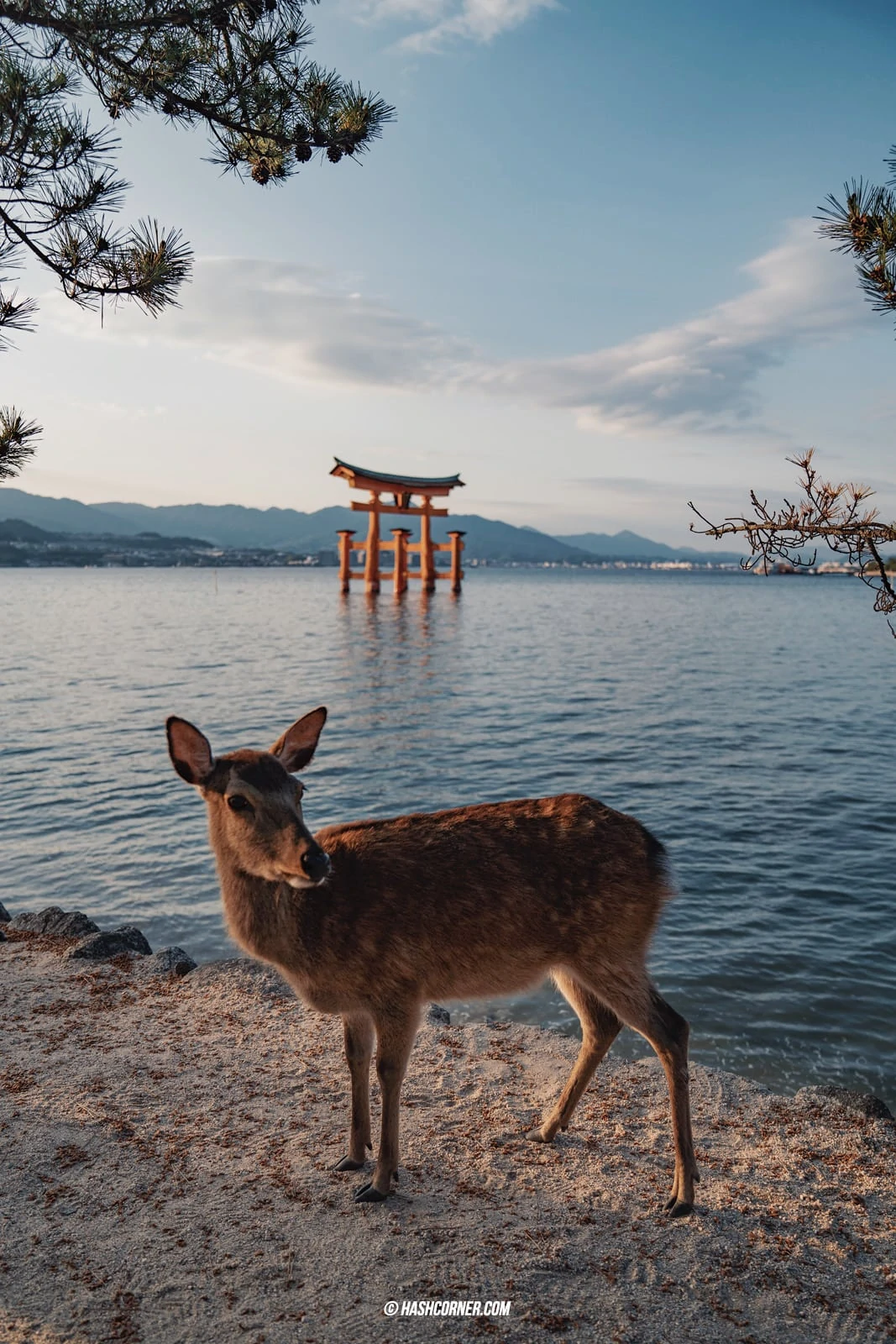
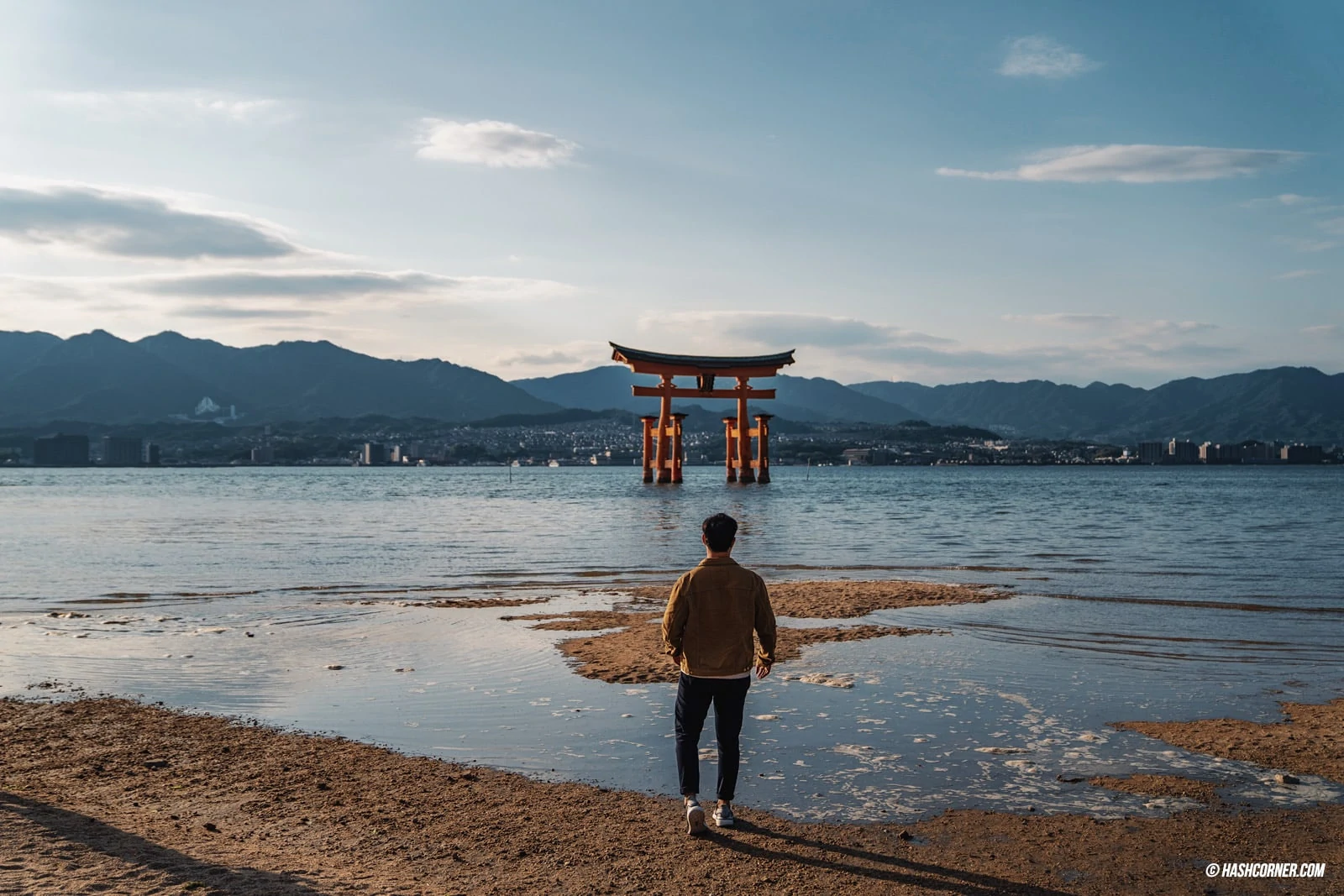
Honestly, those who leave early are missing out significantly. So, I suggest you stay until the sunset and take the last ferry back to the mainland (I can’t remember the exact time, but you can check it). Ending your trip to Miyajima Island with this unforgettable sunset experience would be the ultimate way to top it off. ♥️
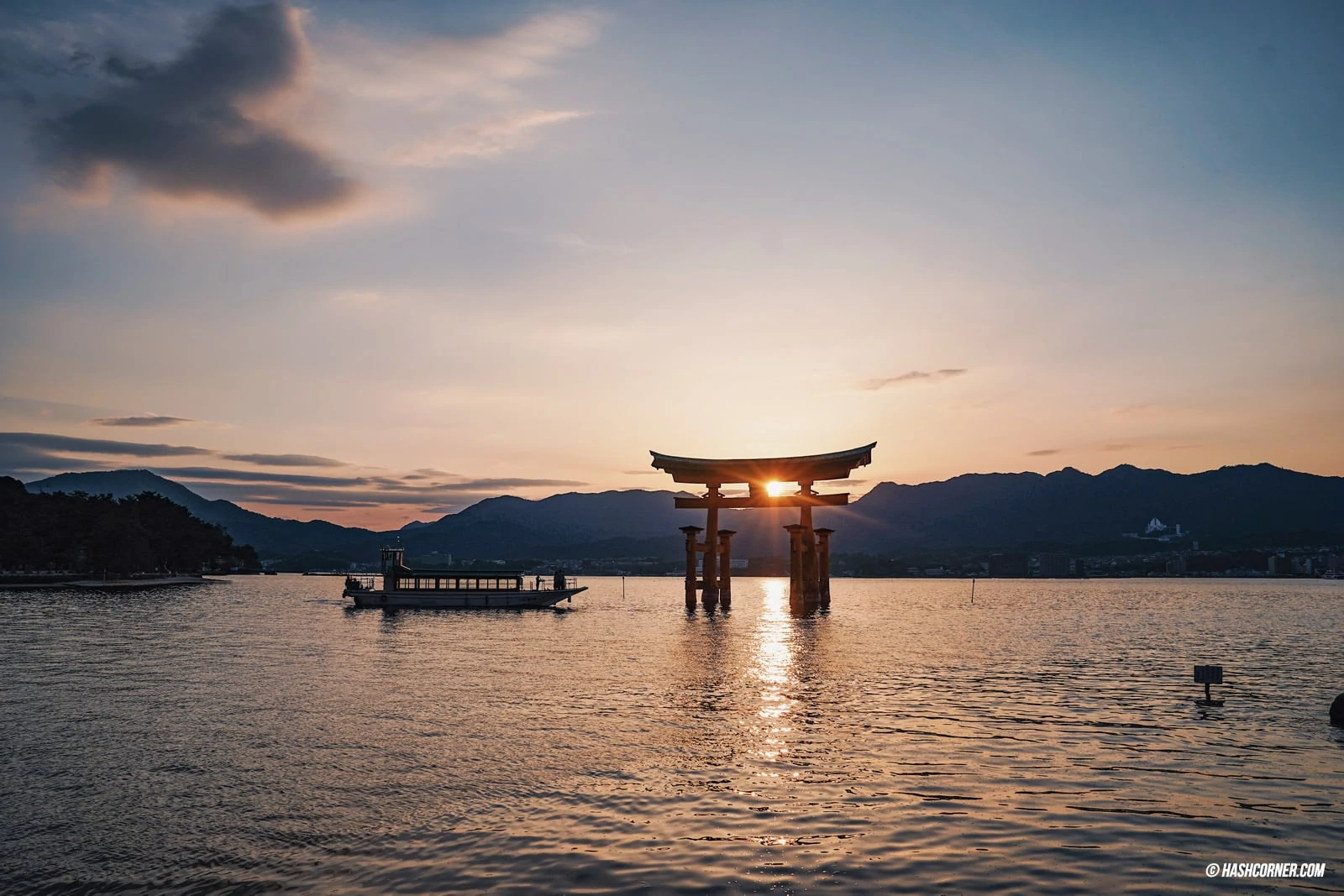
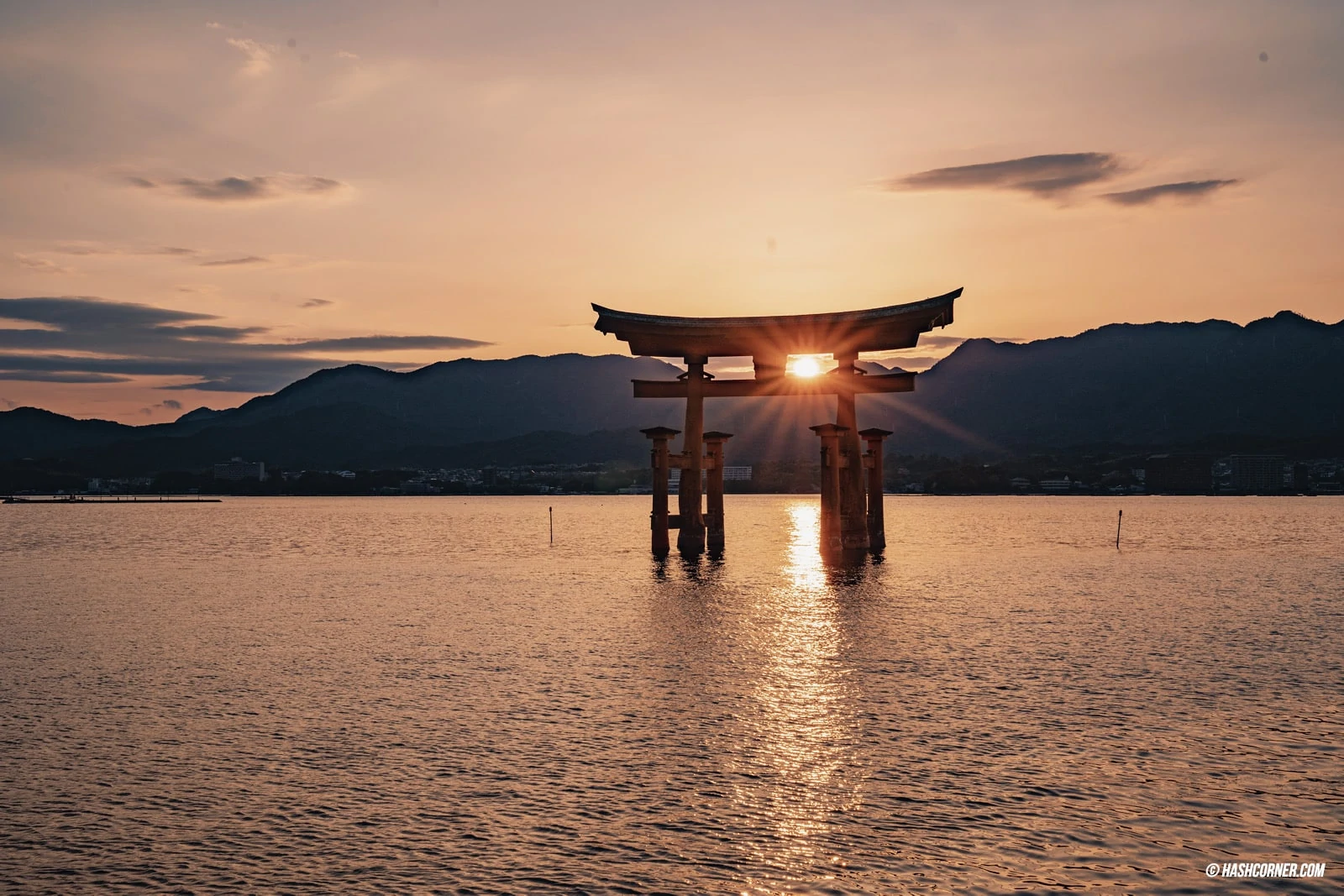
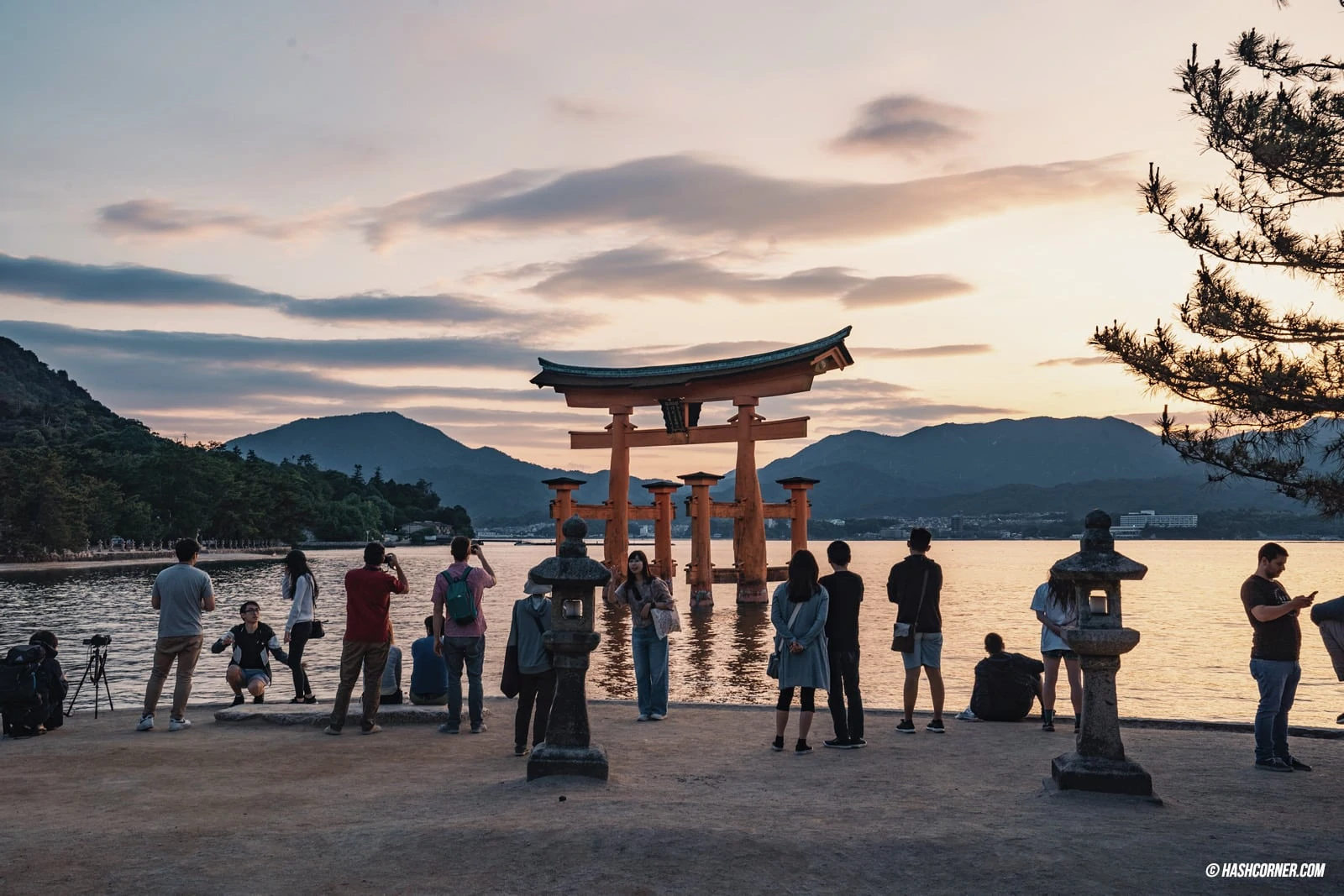
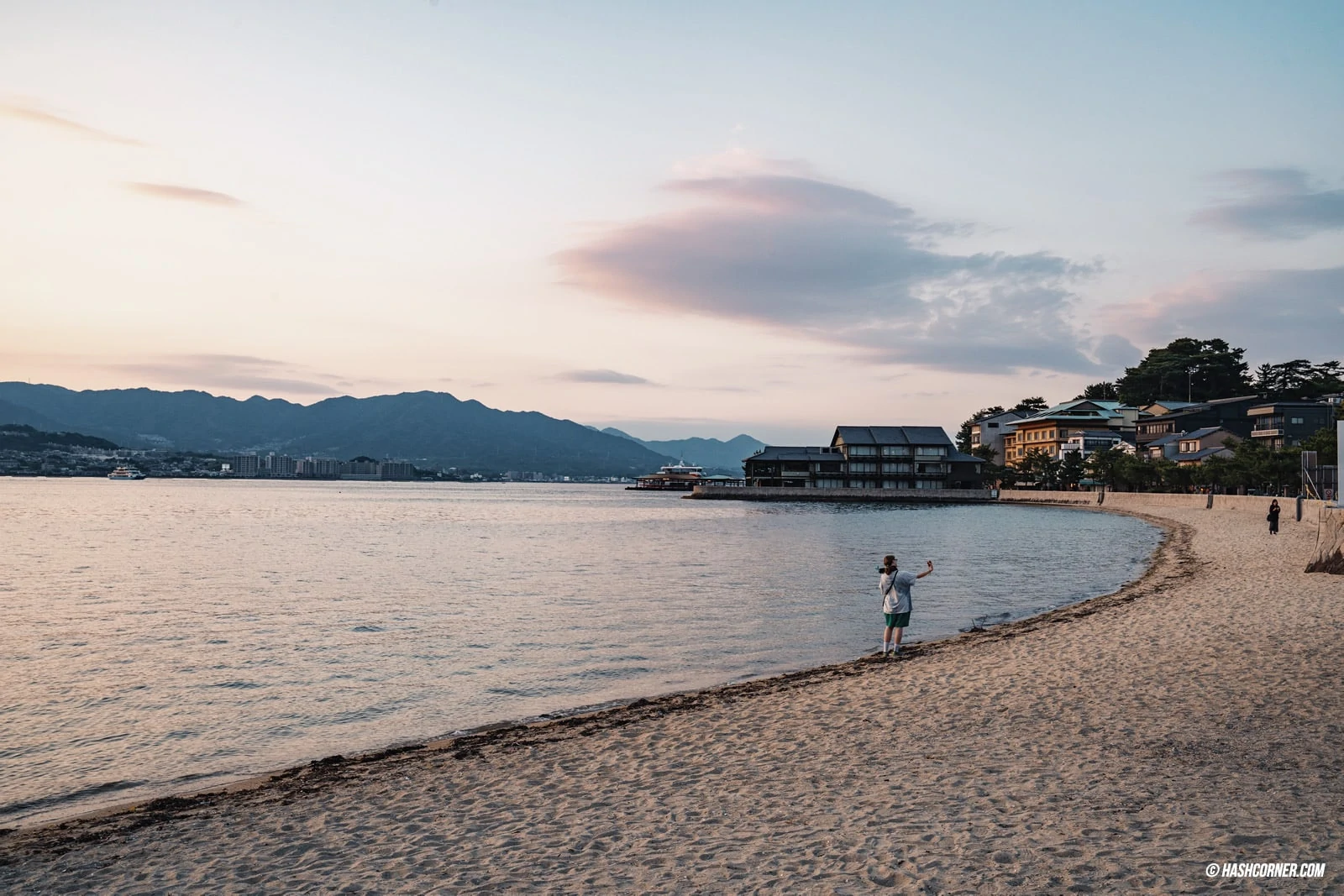
อ่านรีวิวเมืองนี้จบแล้ว
อ่านรีวิวเมืองอื่นในญี่ปุ่นต่อกันเลย 🤗
ญี่ปุ่นเป็นประเทศไม่กี่ประเทศที่นี่รู้สึกว่า ไปกี่ครั้งก็ไม่น่าเบื่อ ไปแล้วไปอีกได้ตลอด และยังประเทศที่ตัวเองตั้งมิชชั่นว่า อยากจะเก็บให้หมดทั่วประเทศ ฮ่าา เอาเป็นว่า HASHCORNER นี่ก็มีรีวิวญี่ปุ่นให้อ่านและตามรอยเยอะพอสมควร ทั้งหมดนับแล้วเกือบ 50 รีวิวแล้ว เยอะโคตร ใครที่มีแพลนไปเมืองไหนในญี่ปุ่นที่มีชื่อเมืองตามลิสด้านล่าง สามารถคลิกลิงค์อ่านต่อได้เล้ย
ภูมิภาคคันโต (Kanto Region)
1. รีวิว โตเกียว (Tokyo)
2. รีวิว โตเกียวดิสนีย์แลนด์ (Tokyo Disneyland)
3. รีวิว โตเกียวดิสนีย์ซี (Tokyo DisneySea)
4. รีวิว Harry Potter: Warner Bros. Studio Tour Tokyo
5. รีวิว โยโกฮาม่า (Yokohama)
6. รีวิว คามาคุระ (Kamamura)
7. รีวิว นิกโก้ (Nikko)
8. รีวิว ฮาโกเน่ (Hakone)
⸺⸺⸺⸺
ภูมิภาคคันไซ (Kansai Region)
9. รีวิว โอซาก้า (Osaka)
10. รีวิว Universal Studios Japan (USJ)
11. รีวิว เกียวโต (Kyoto)
12. รีวิว นารา (Nara)
13. รีวิว โกเบ (Kobe)
14. รีวิว ฮิเมจิ (Himeji)
15. รีวิว อิเสะ-ชิมะ (Ise-Shima) กำลังเขียน
16. รีวิว อิกะ อุเอโนะ (Iga Ueno) กำลังเขียน
17. รีวิว อะซุกะ (Asuka) กำลังเขียน
⸺⸺⸺⸺
ภูมิภาคชูบุ (Chubu Region)
18. รีวิว คานาซาวะ (Kanazawa)
19. รีวิว ชิราคาวาโกะ (Shirakawa-go)
21. รีวิว ทาคายาม่า (Takayama)
21. รีวิว คาวากุจิโกะ (Kawaguchigo)
22. รีวิว สวนสนุก Fuji-Q Highland
23. รีวิว ยามานากะโกะ (Yamanakako)
24. รีวิว ชิซึโอกะ (Shizuoka)
25. รีวิว อิซุ (Izu) กำลังเขียน
26. รีวิว คาวาซึ (Kawazu)
27. รีวิว อิโต (Ito) กำลังเขียน
28. รีวิว อาตามิ (Atami)
29. รีวิว คารุอิซาวะ (Karuizawa)
30. รีวิว นากาโน่ (Nagano)
31. รีวิว มัตสึโมโตะ (Matsumoto)
⸺⸺⸺⸺
ภูมิภาคคิวชู (Kyushu Region)
32. รีวิว ฟุกุโอกะ-ดาไซฟุ (Fukuoka-Dazaifu)
33. รีวิว นางาซากิ (Nagasaki)
34. รีวิว ยูฟูอิน (Yufuin)
35. รีวิว คุมาโมโตะ (Kumamoto)
36. รีวิว ภูเขาไฟอะโสะ (Mount Aso)
37. รีวิว ทาคาชิโฮ (Takachiho)
⸺⸺⸺⸺
ภูมิภาคโอกินาว่า (Okinawa Region)
38. รีวิว โอกินาว่า (Okinawa)
⸺⸺⸺⸺
ภูมิภาคฮอกไกโด (Hokkaido Region)
39. รีวิว ซัปโปโร (Sapporo)
40. รีวิว โอตารุ (Otaru)
41. รีวิว อาซาฮิกาวะ-บิเอะ (Asahikawa-Biei)
42. รีวิว อะบาชิริ-คุชิโระ (Abashiri-Kushiro)
43. รีวิว ฮาโกดาเตะ (Hakodate)
⸺⸺⸺⸺
ภูมิภาคชูโกกุ (Chugoku Region)
44. รีวิว ฮิโรชิม่า (Hiroshima)
45. รีวิว เกาะมิยาจิม่า (Miyajima)
46. รีวิว โอคายาม่า-คุราชิกิ (Okayama-Kurashiki)
⸺⸺⸺⸺
แนะนำโรงแรม / พาสรถไฟ
47. แนะนำที่พักในโตเกียว (Tokyo)
48. แนะนำที่พักในโอซาก้า (Osaka)
49. แนะนำที่พักในฟุกุโอกะ (Fukuoka)
50. แนะนำที่พักในนิกโก้ (Nikko)
51. เรื่องต้องรู้ก่อนซื้อ JR PASS
ส่วนลดจองโรงแรมจาก Agoda, Expedia, Booking และบัตรสวนสนุก ตั๋วรถไฟ กิจกรรมท่องเที่ยวจาก Klook และ KKday ปี 2023
⚡️ สำหรับใครที่กำลังจะจองที่พักและหาส่วนลดจองโรงแรมอยู่ ลองดูตามลิงค์ด้านล่างได้เลย มีทั้ง Agoda, Expedia, Booking รวมถึง Hotels.com ด้วย ประหยัดไปได้อีกเกือบ 10-20% ใช้ได้กับโรงแรมทั่วโลก
หลายคนอาจจะไม่รู้ว่าเว็บไซต์จองโรงแรมพวกนี้ มีส่วนลดท็อปอัพจากบัตรเครดิตเพิ่มเกือบทุกธนาคาร ไม่ว่าจะเป็นบัตรเครดิต Citibank, KBANK, SCB, Krungsri, KTC, Bangkok Bank, UOB และ TMB หรือแม้แต่ส่วนลดจากค่ายมือถืออย่าง AIS, DTAC หรือ True ซึ่งส่วนลดพวกนี้จะเปลี่ยนตลอดทุกเดือน และเก๊าก็อัพเดทให้ตลอดเวลาเน้อ 🧡
